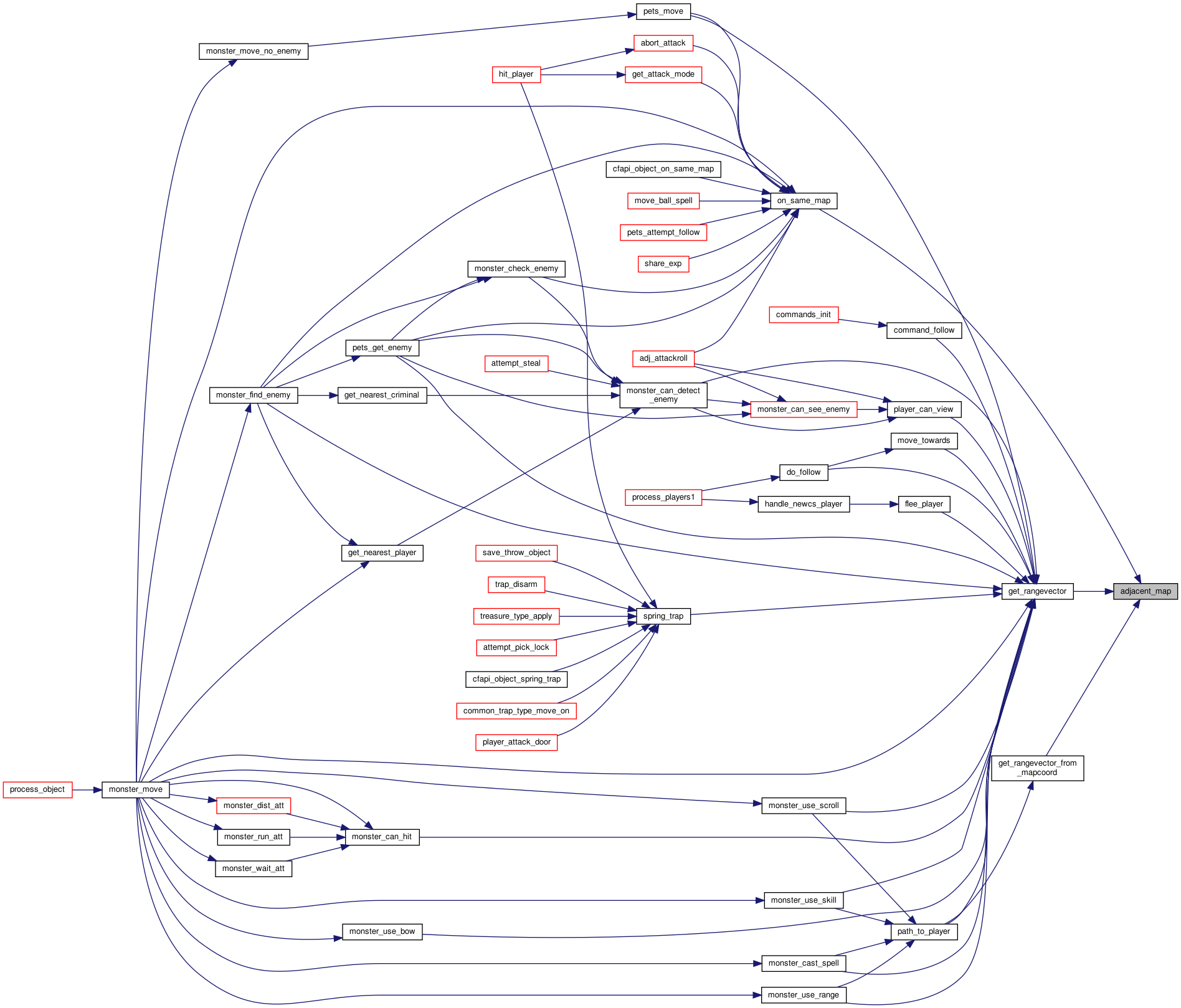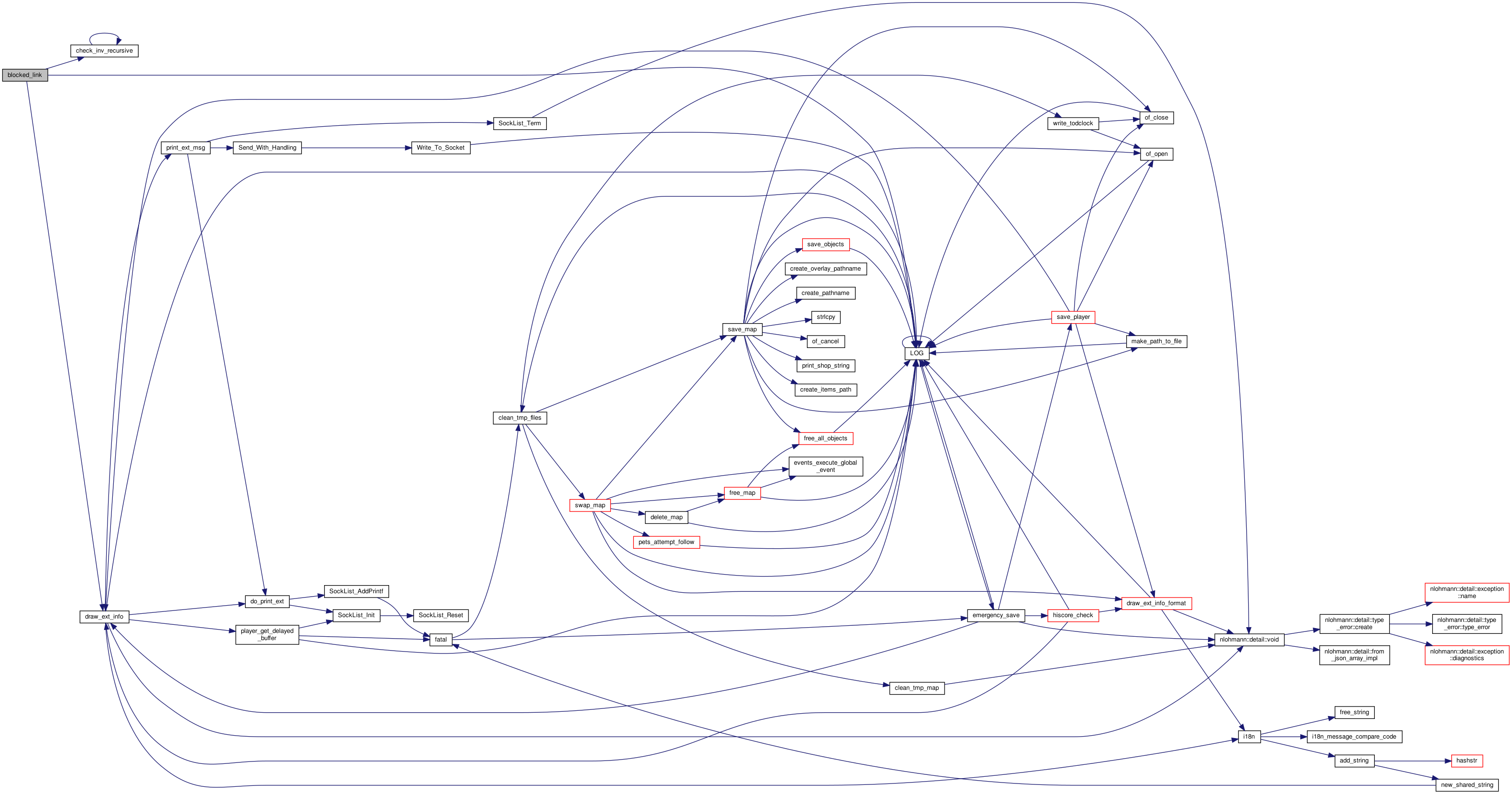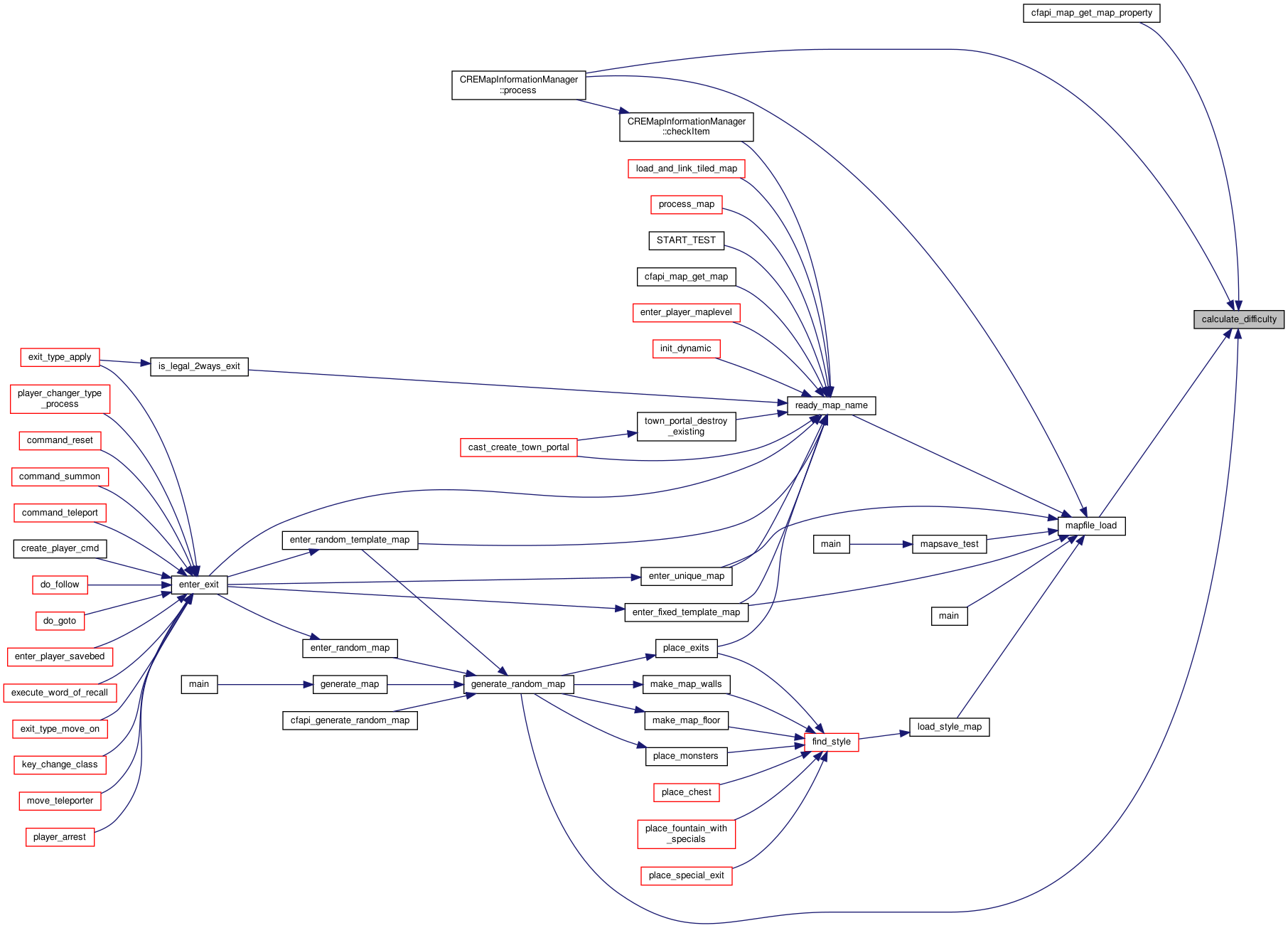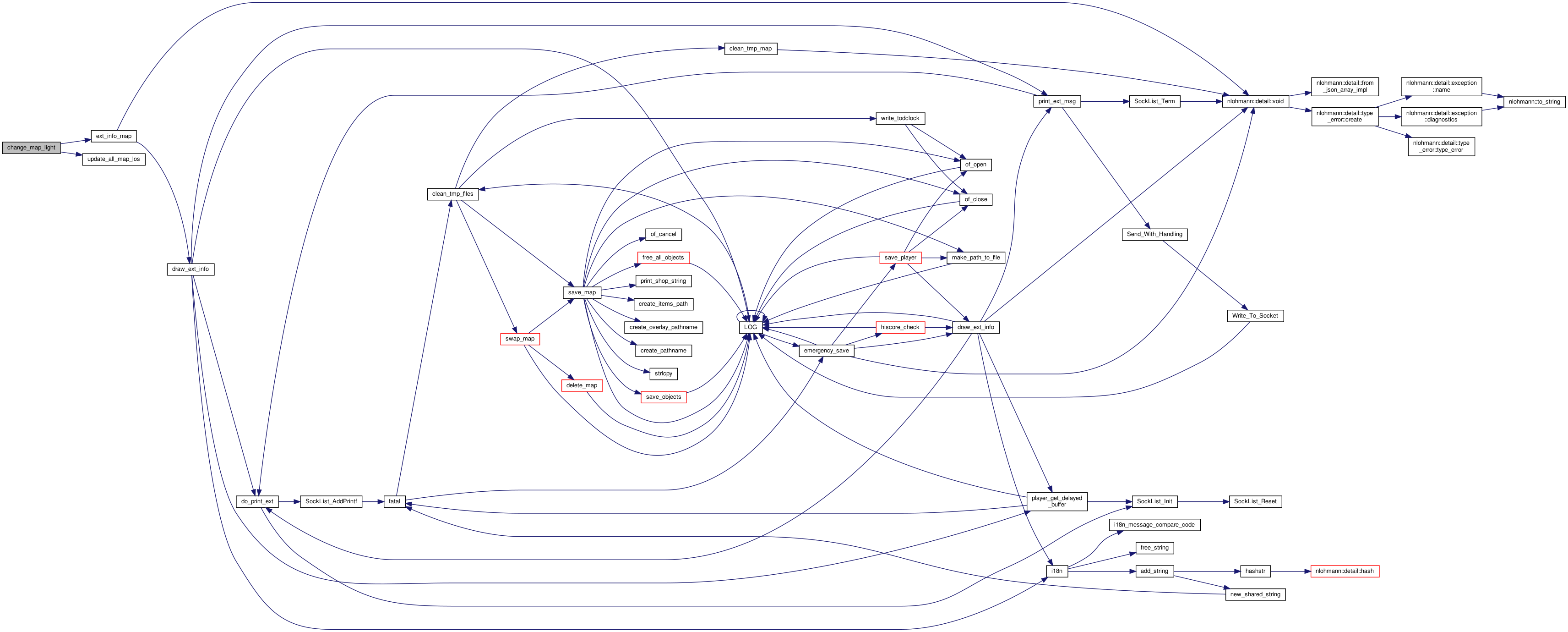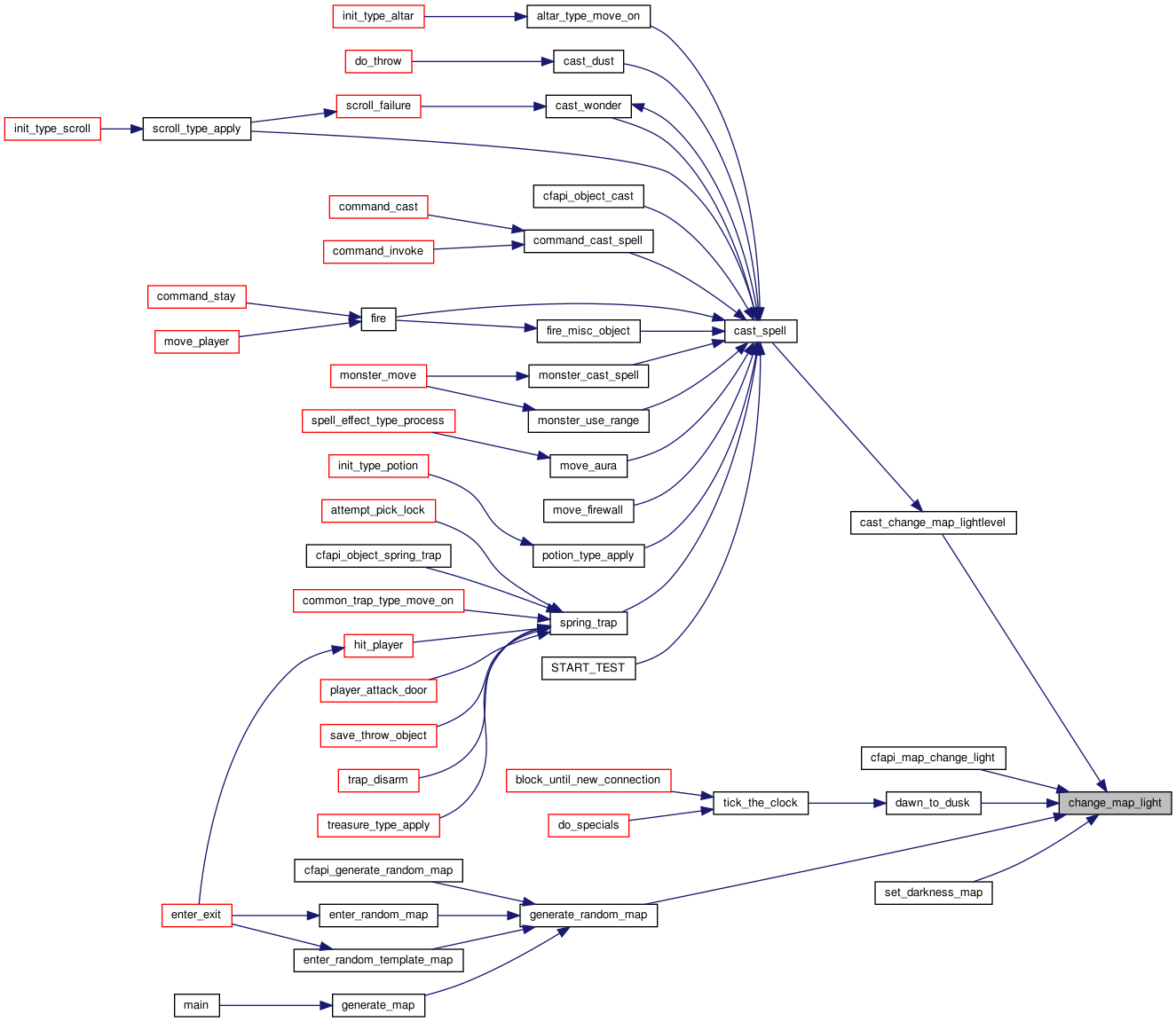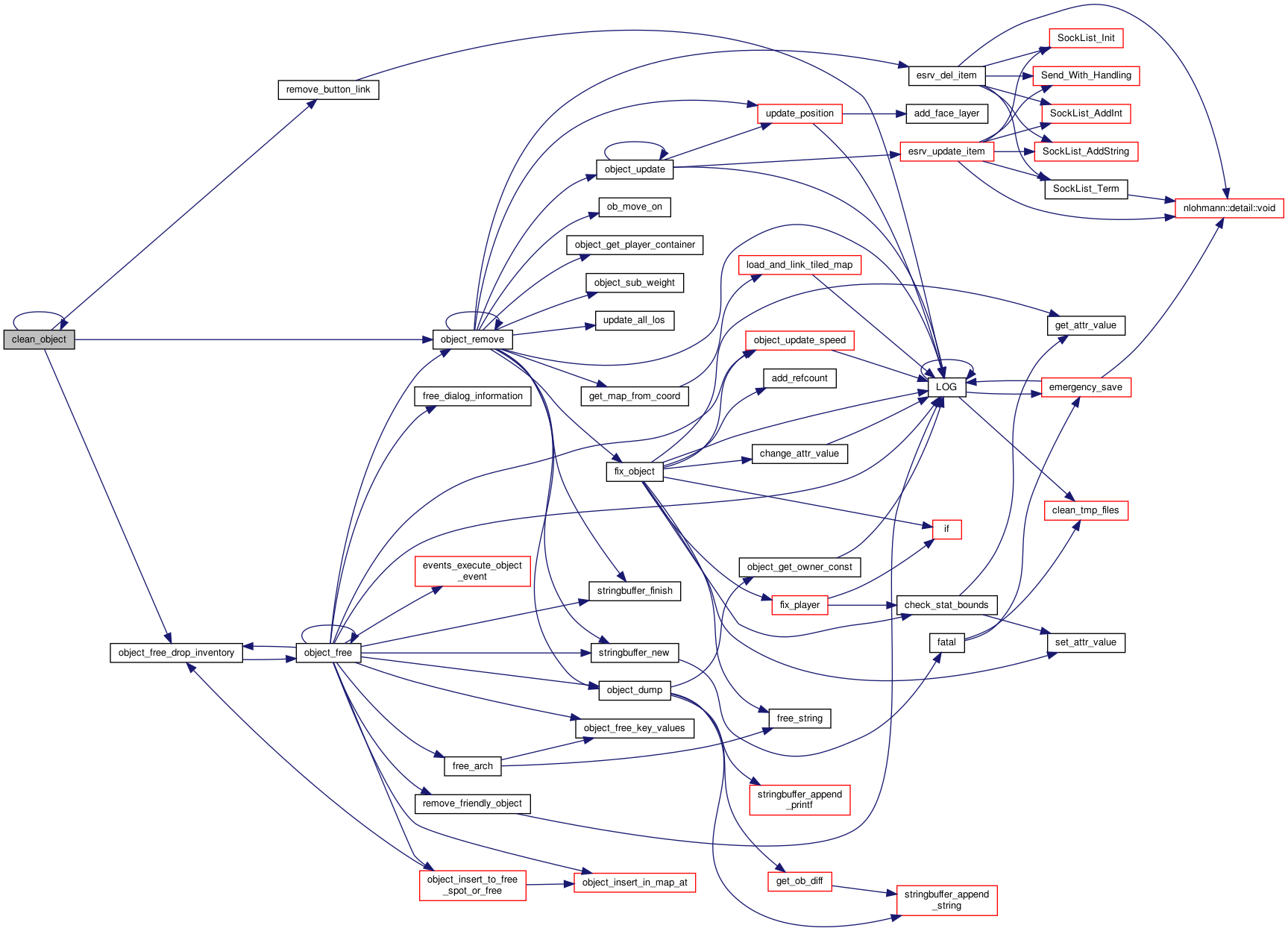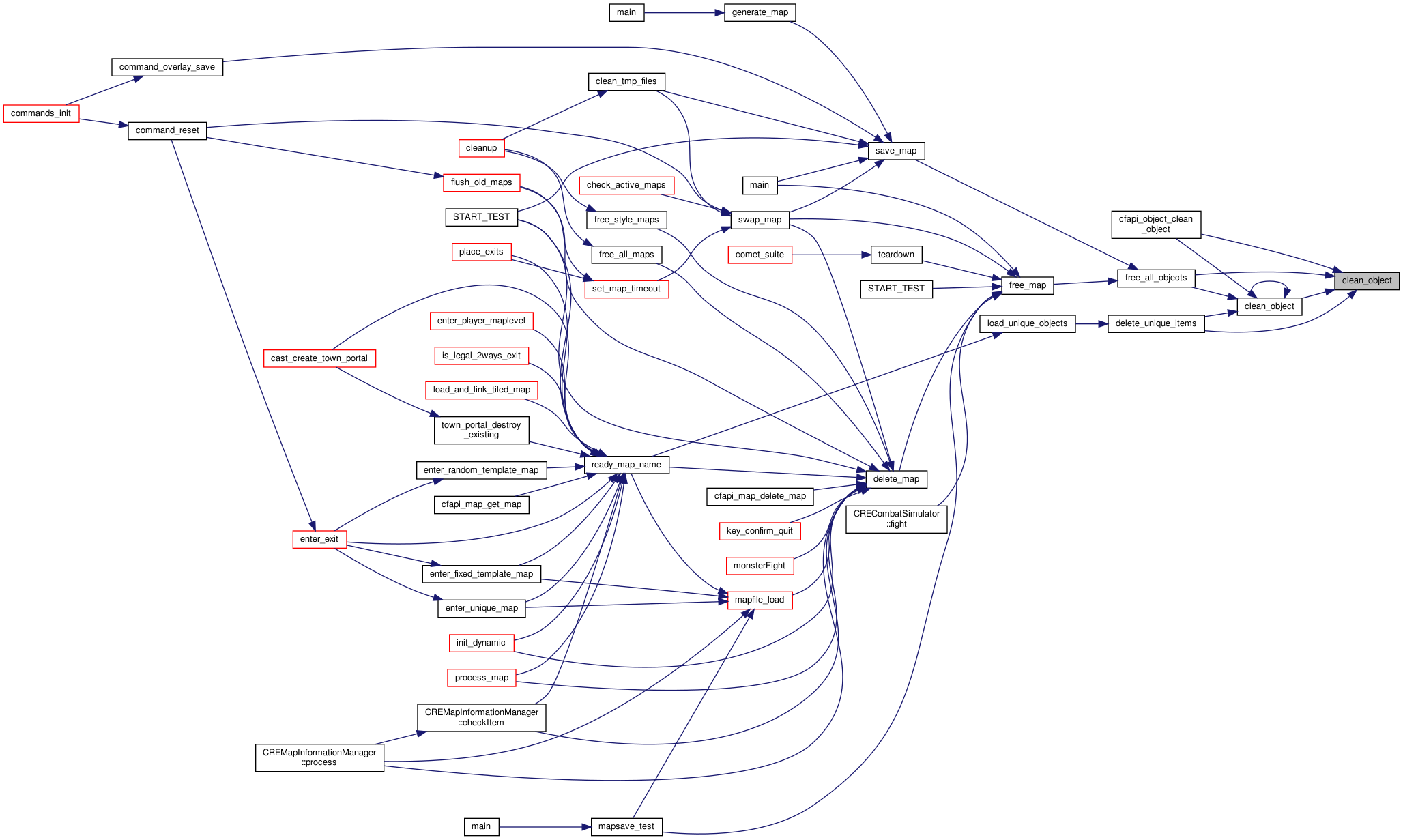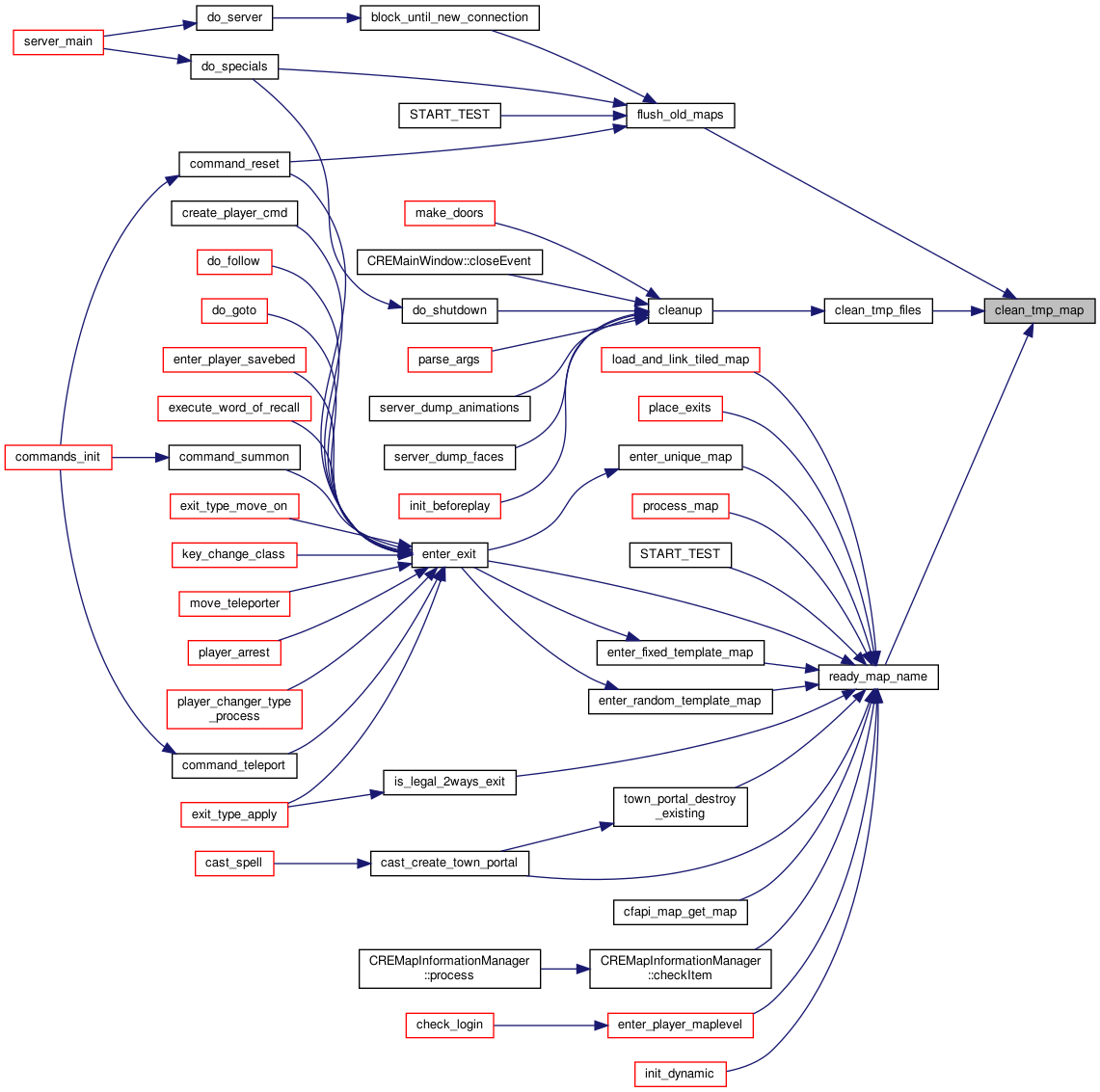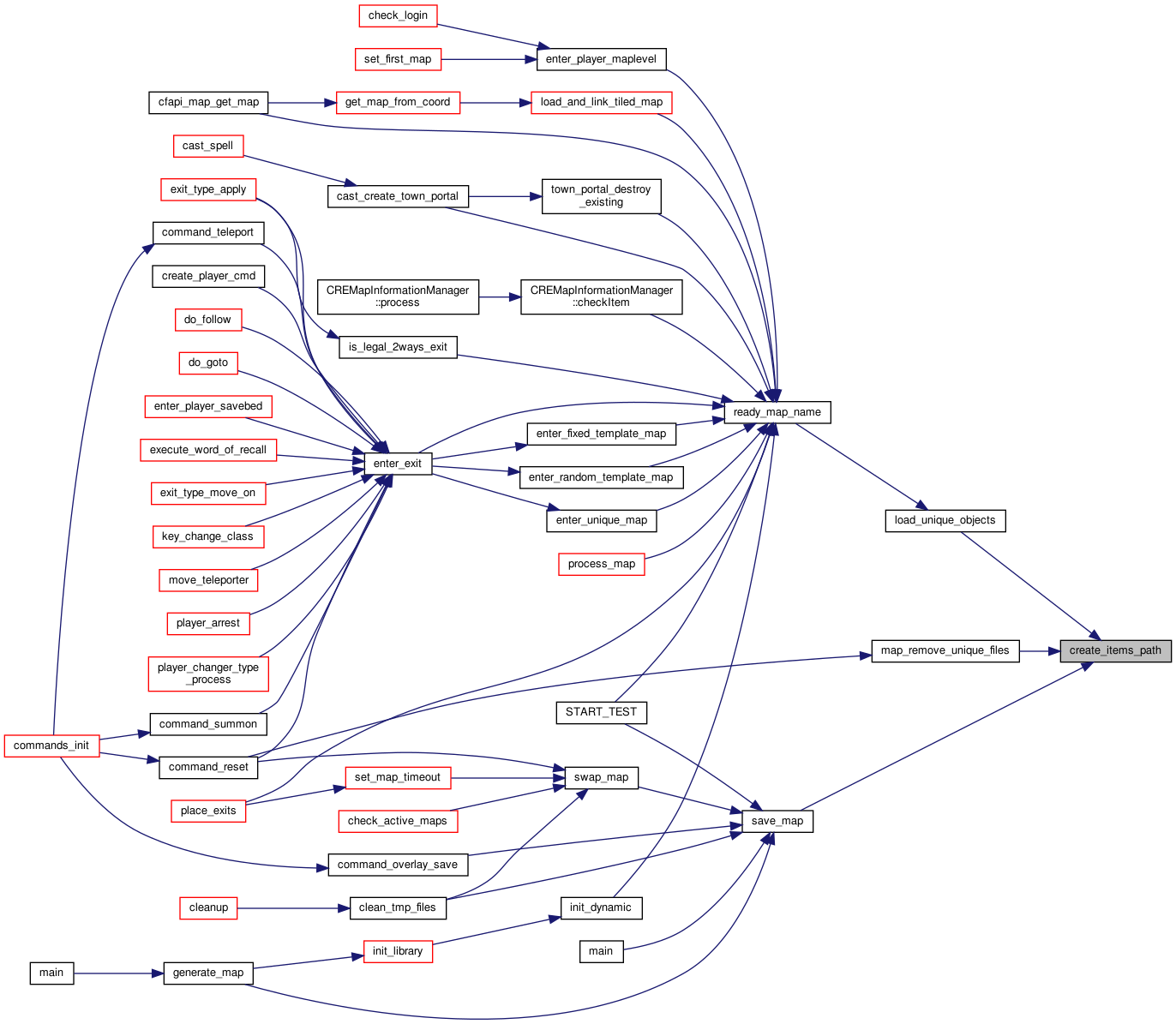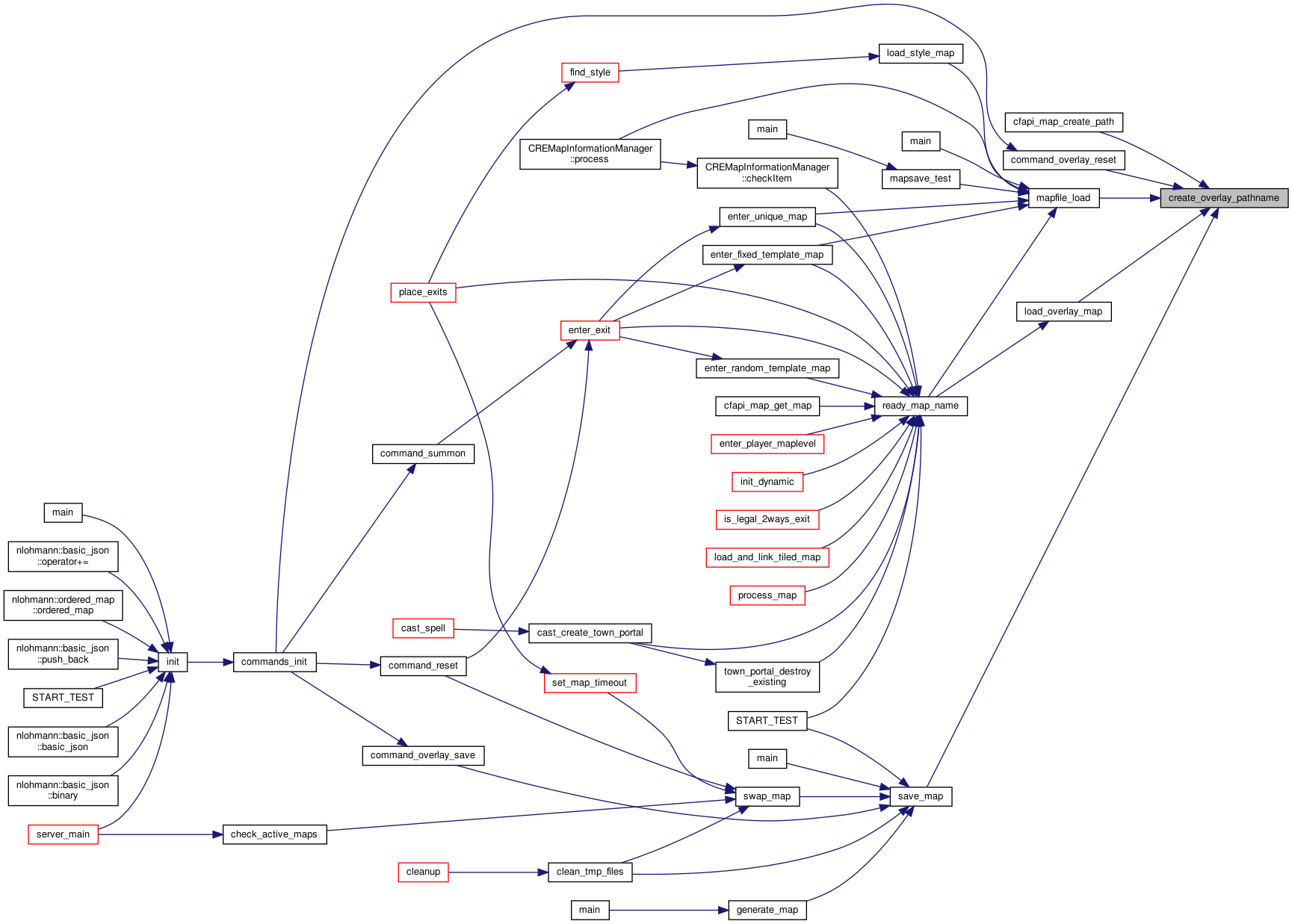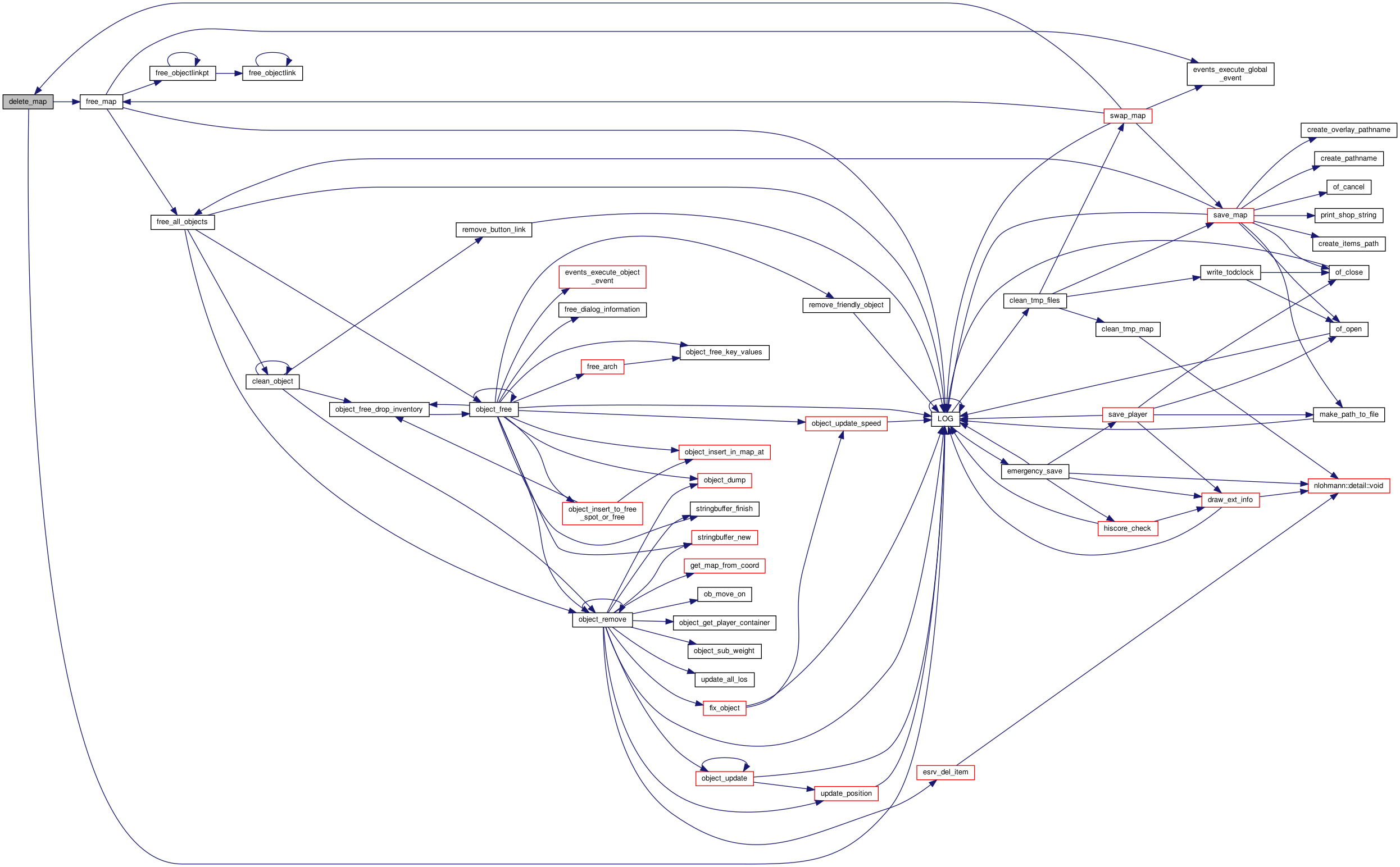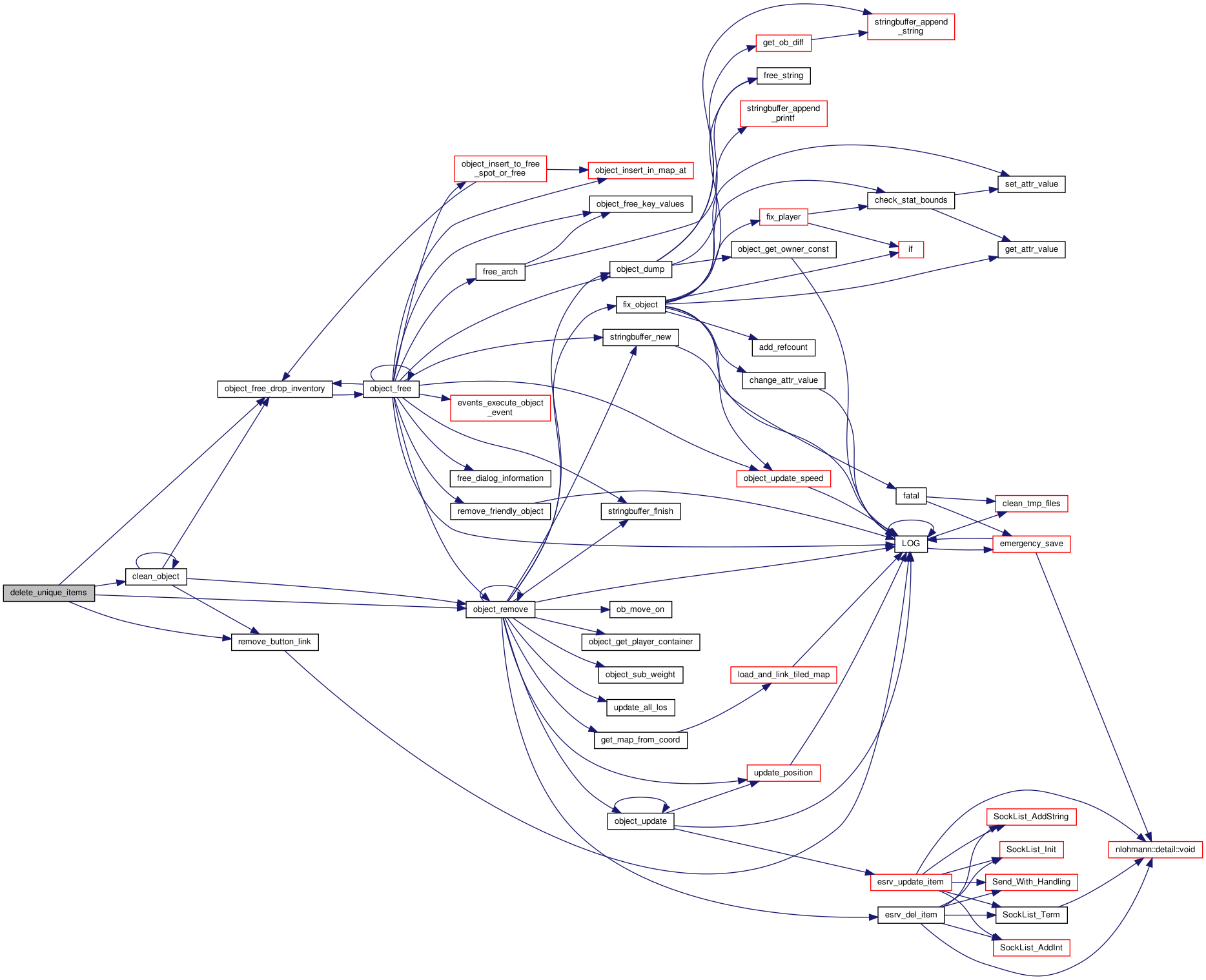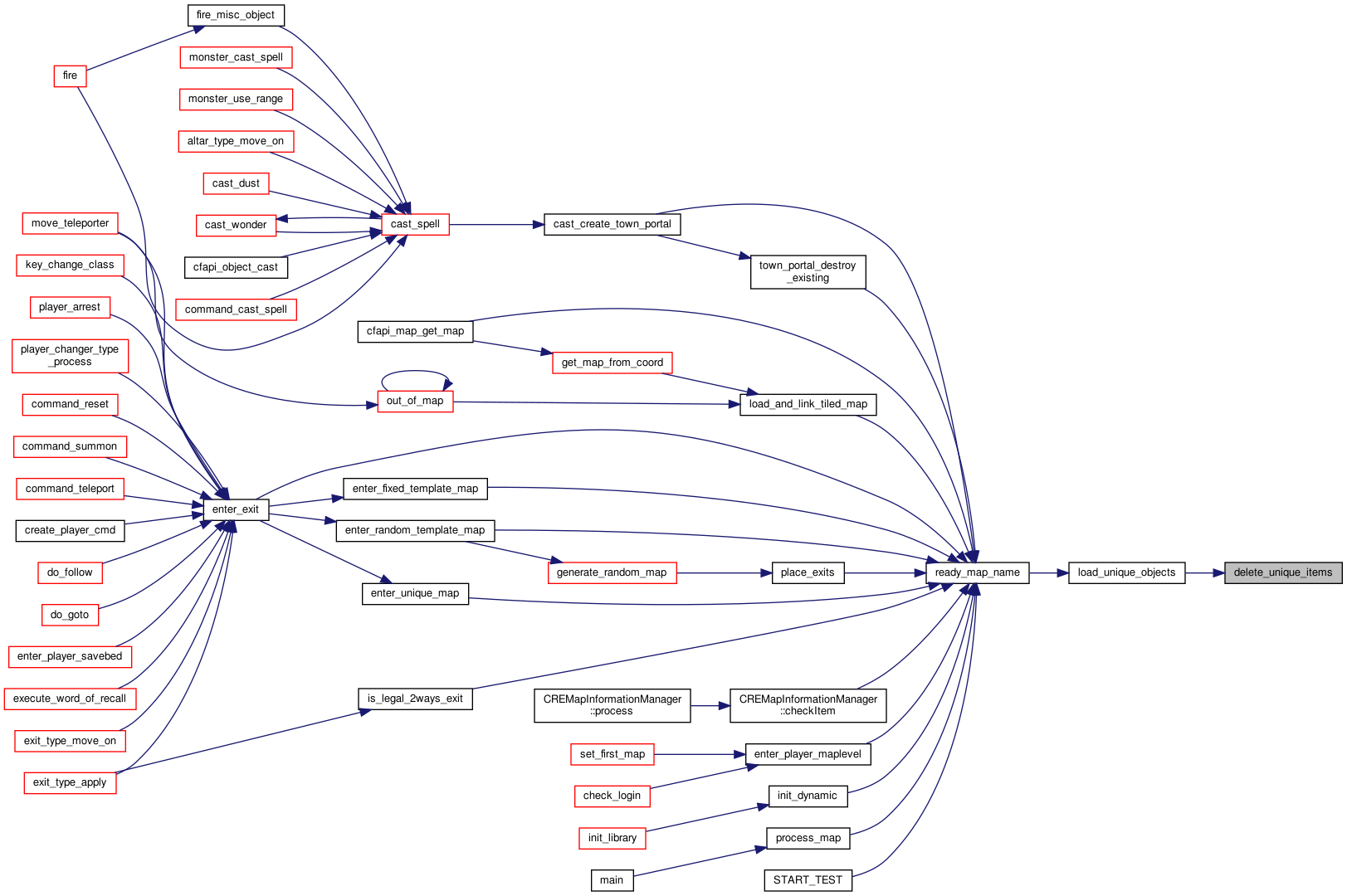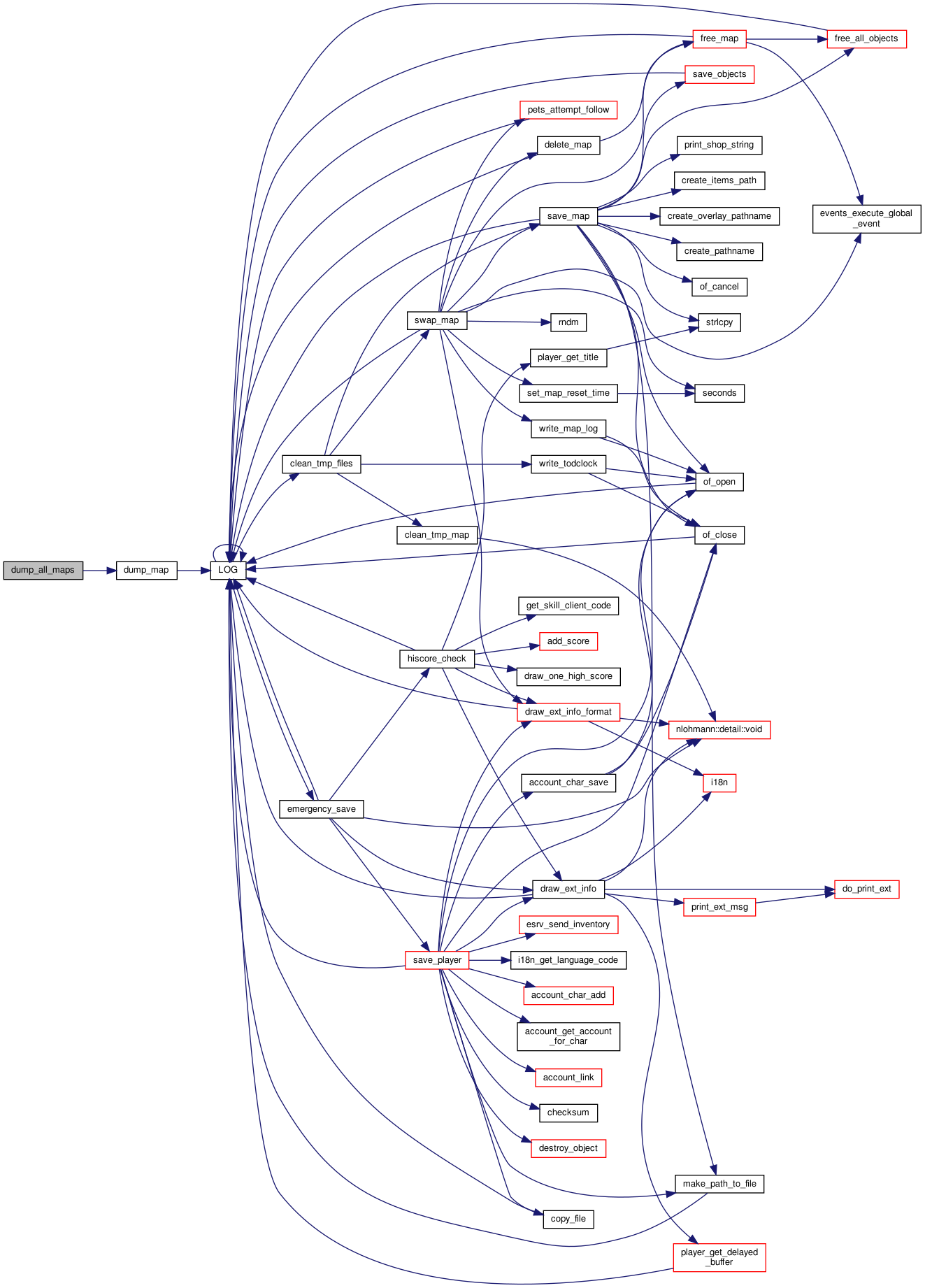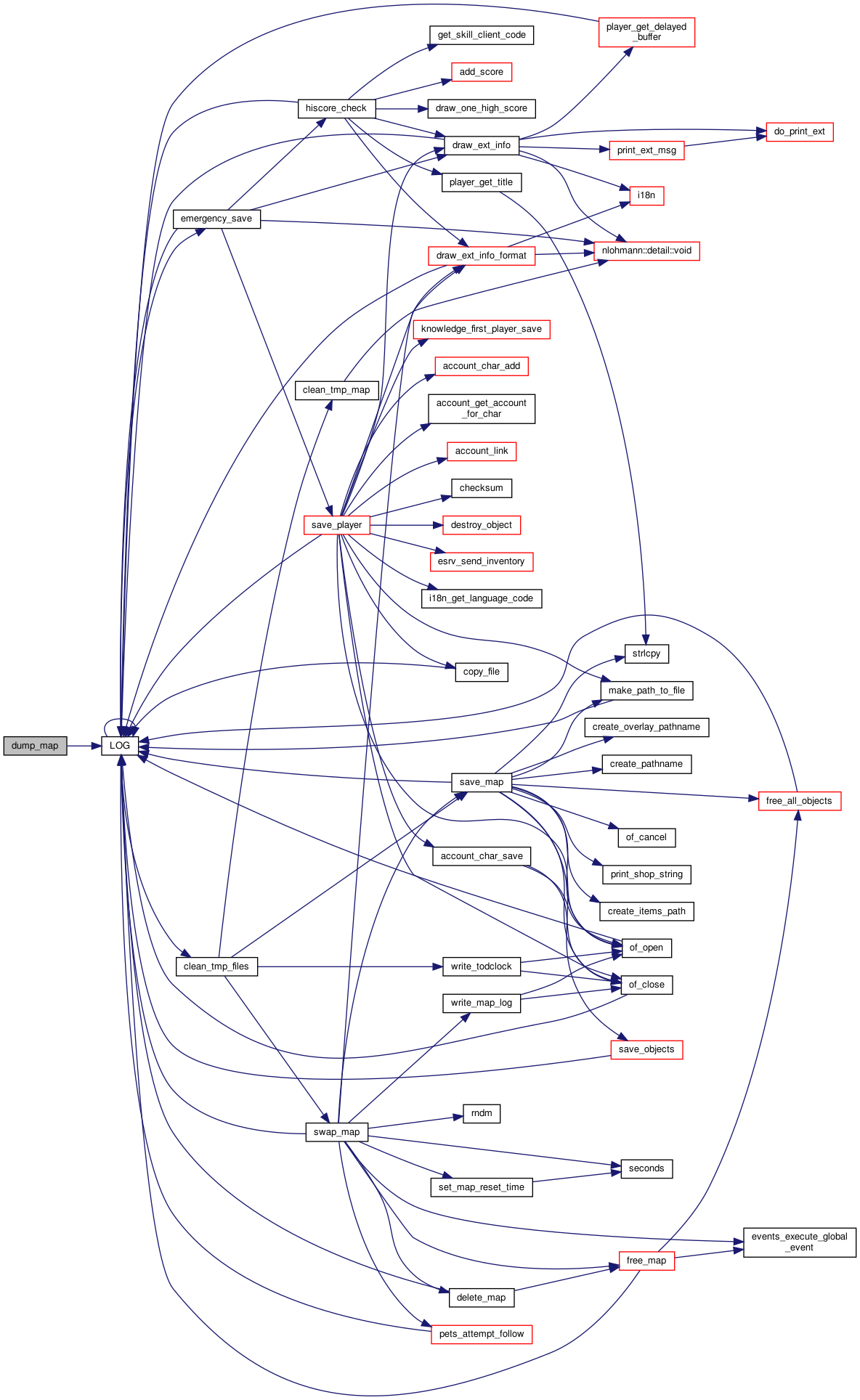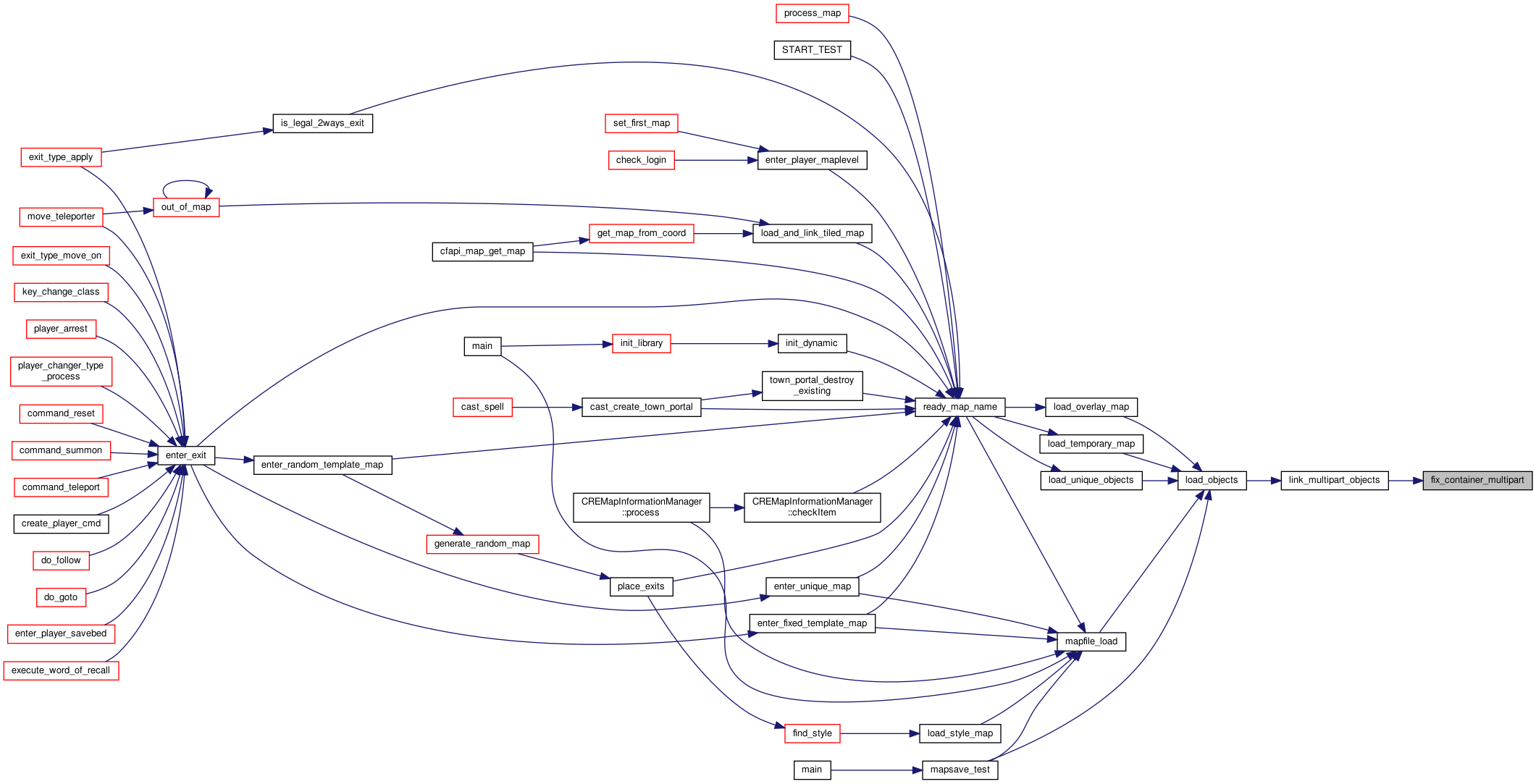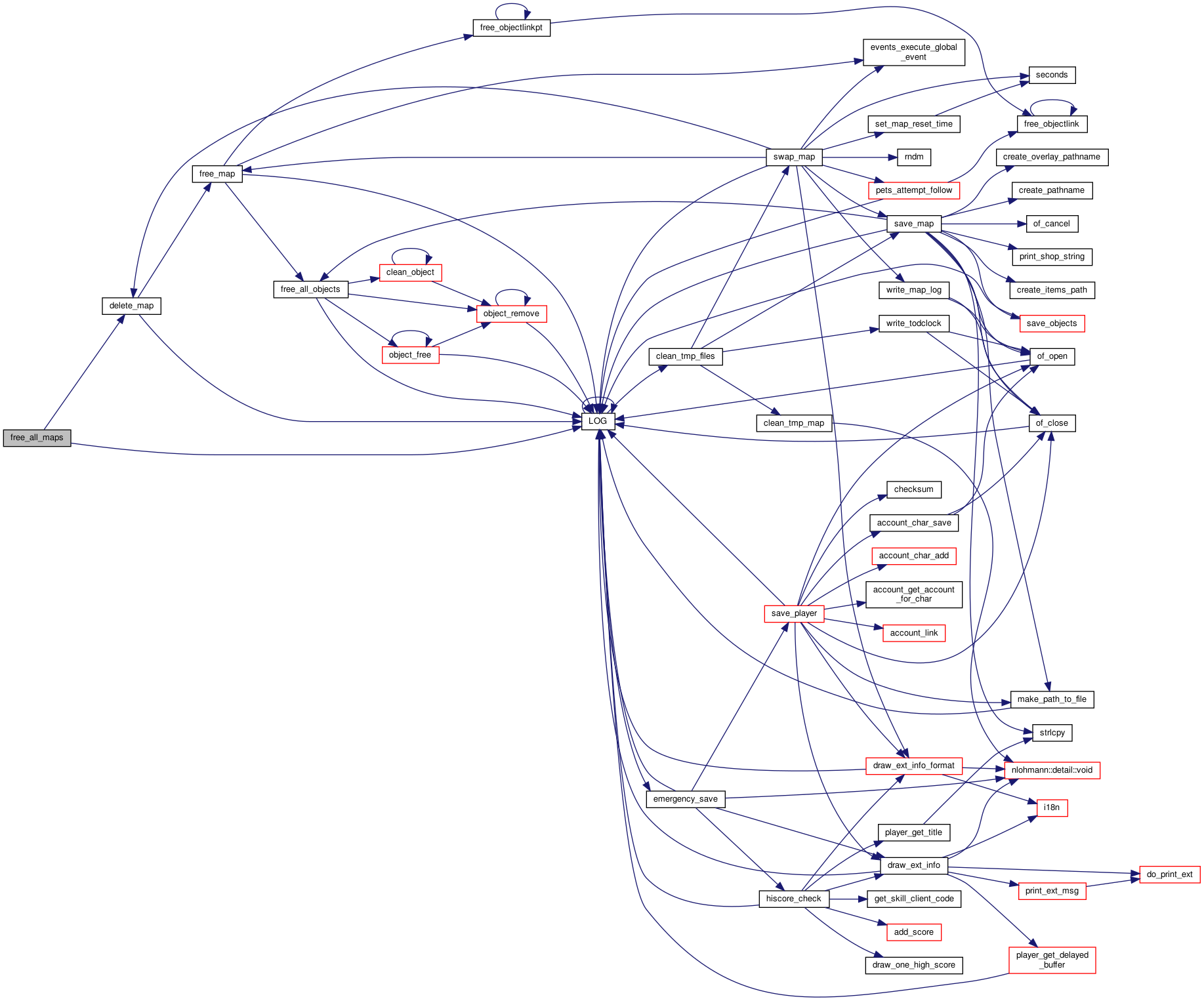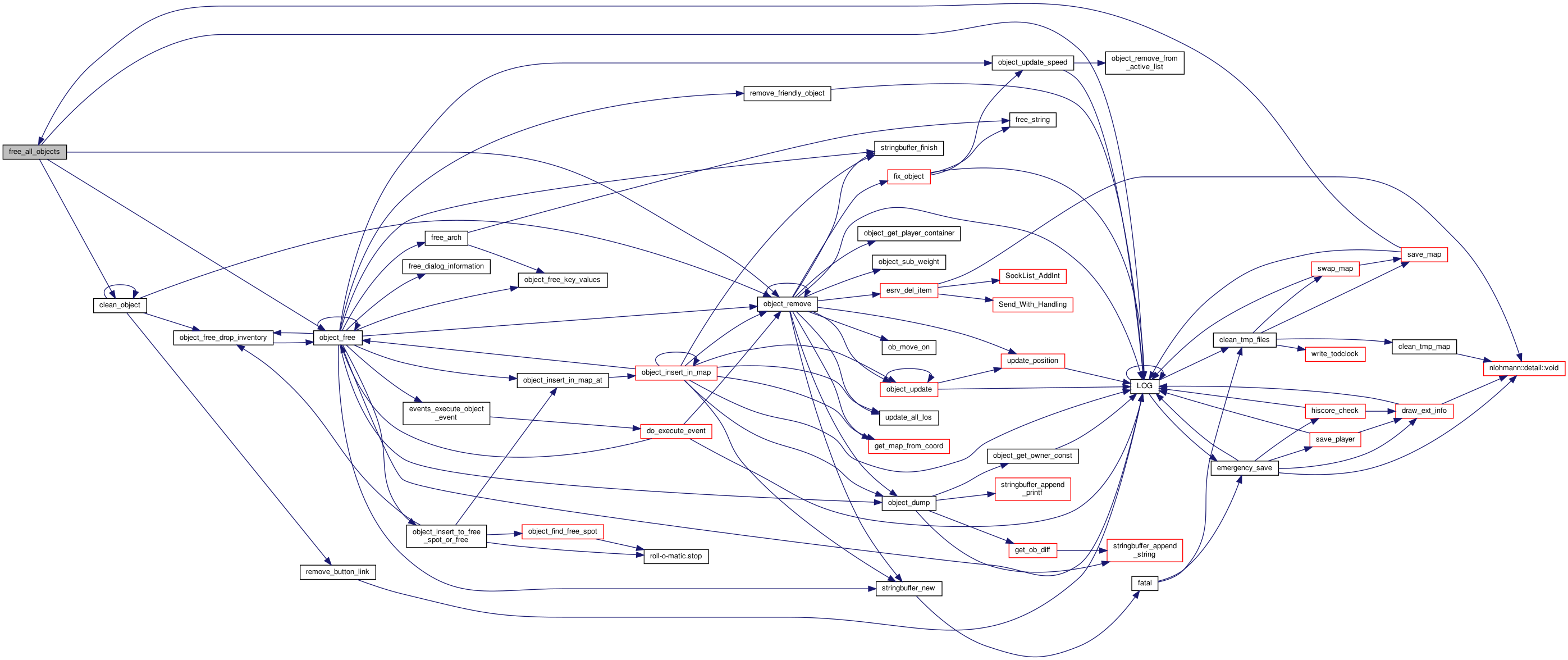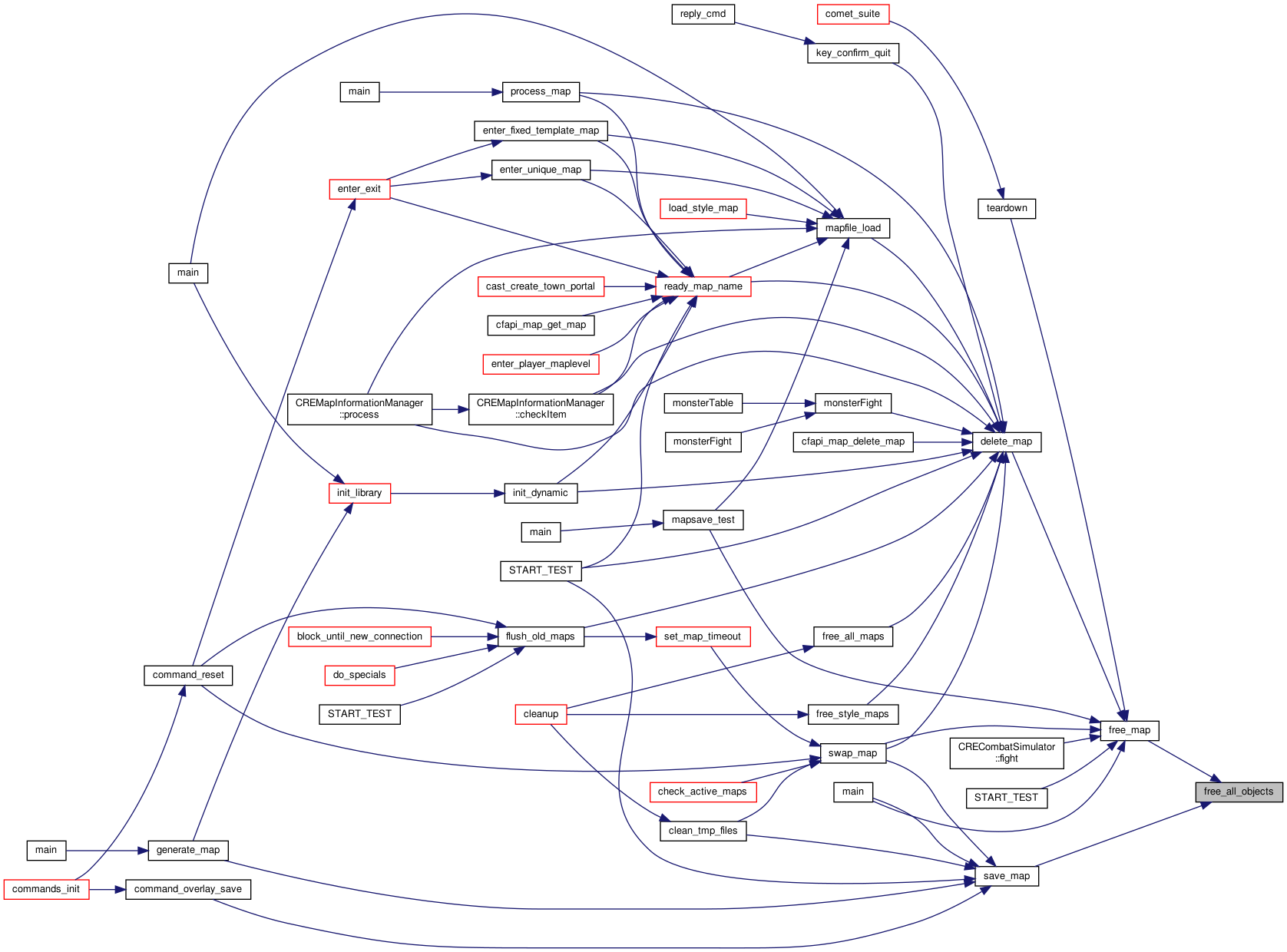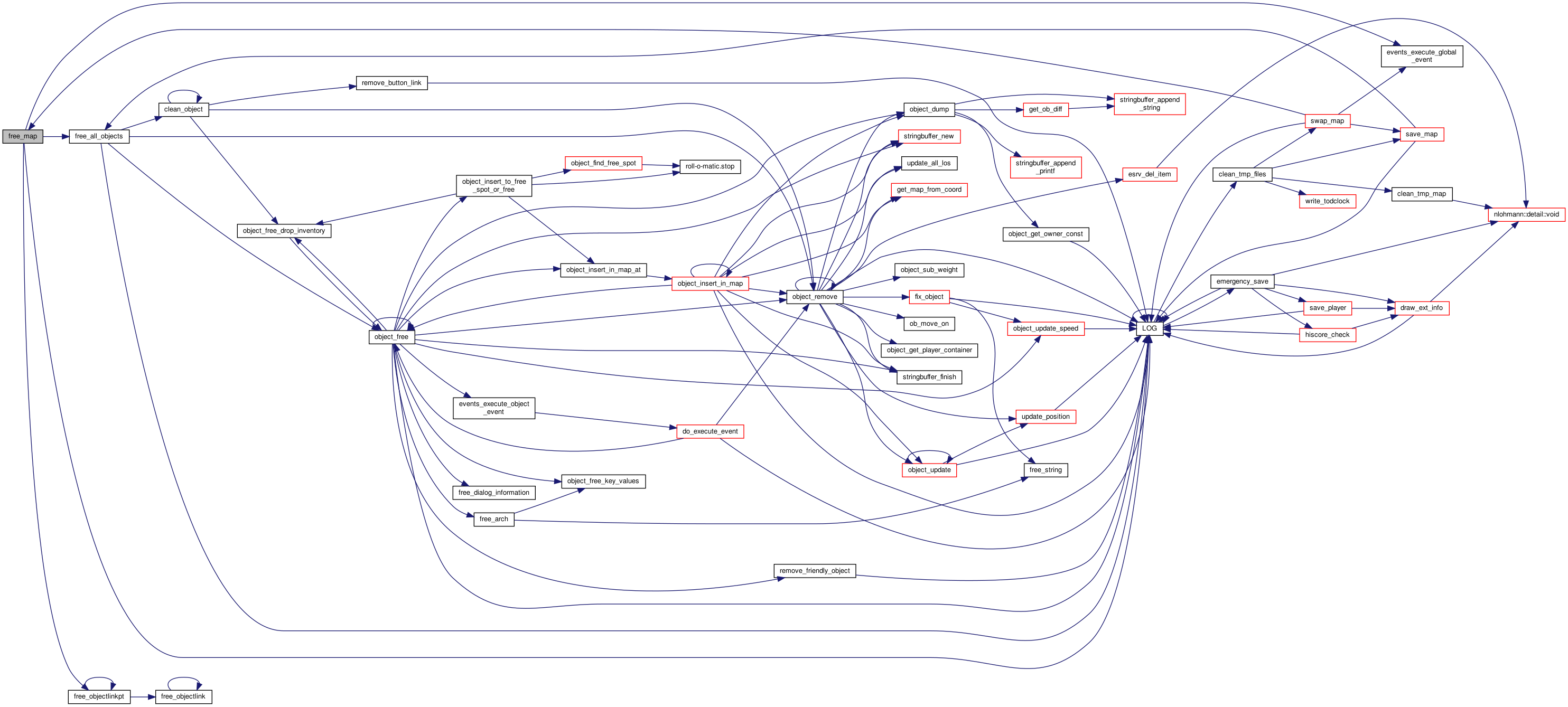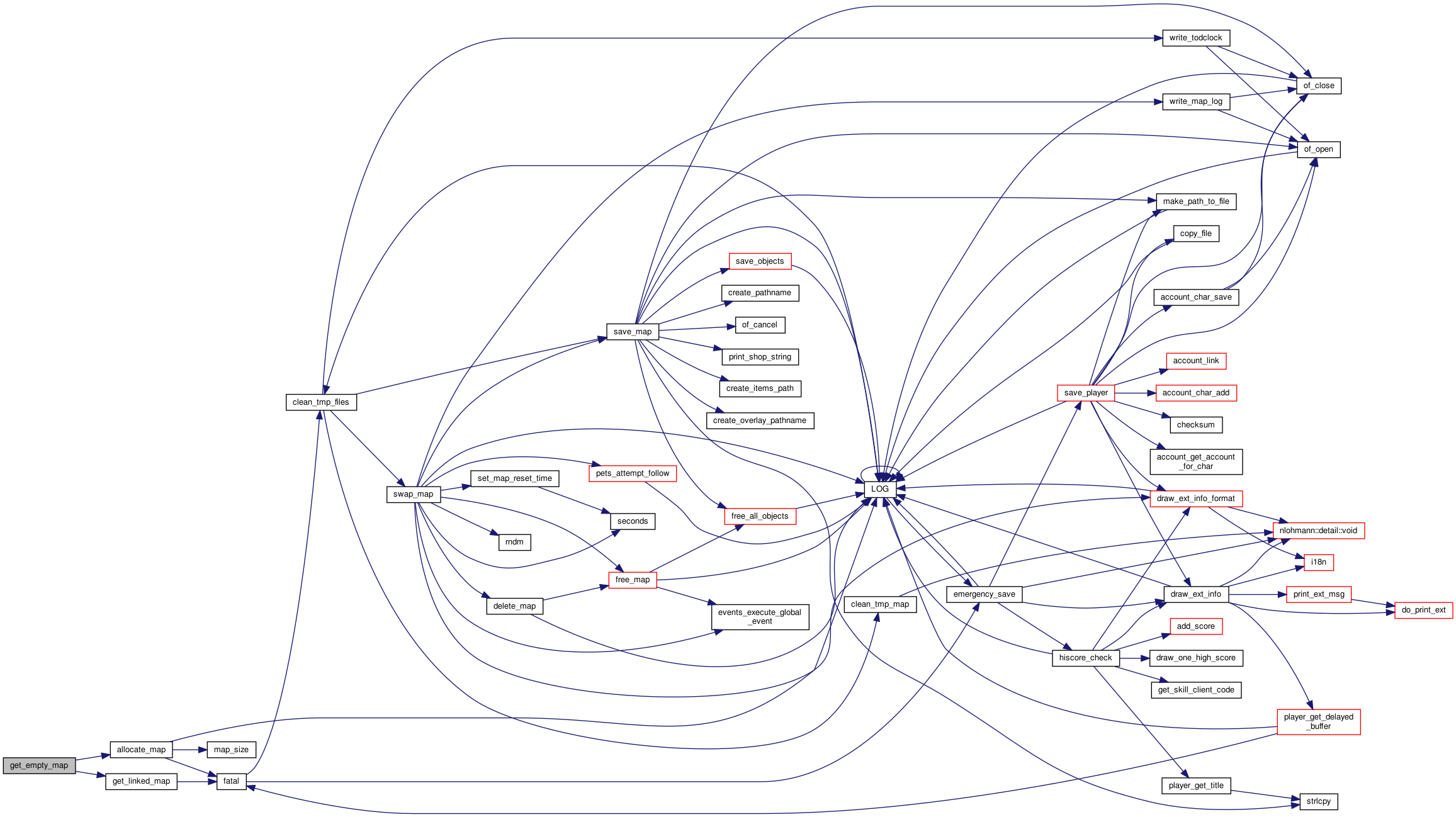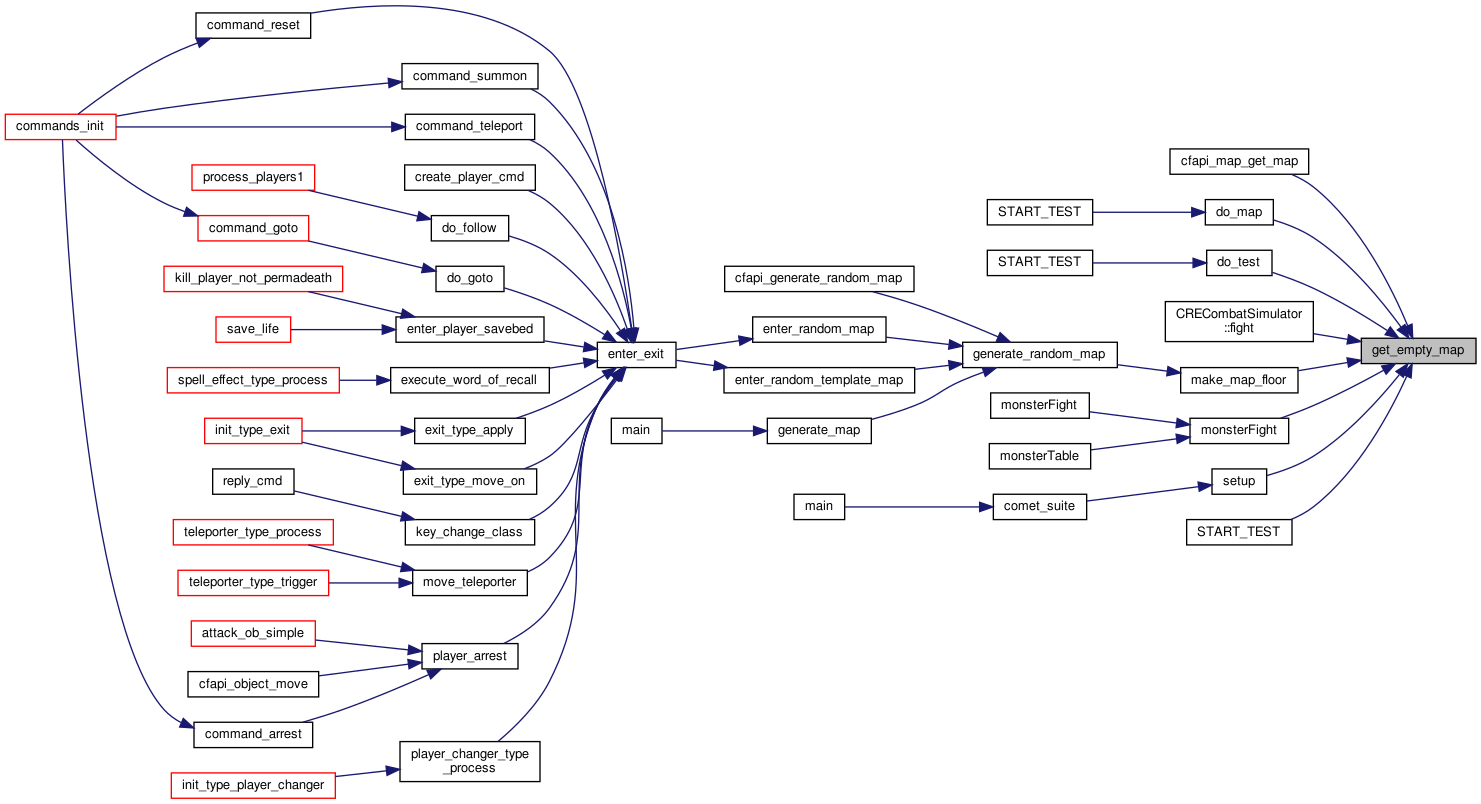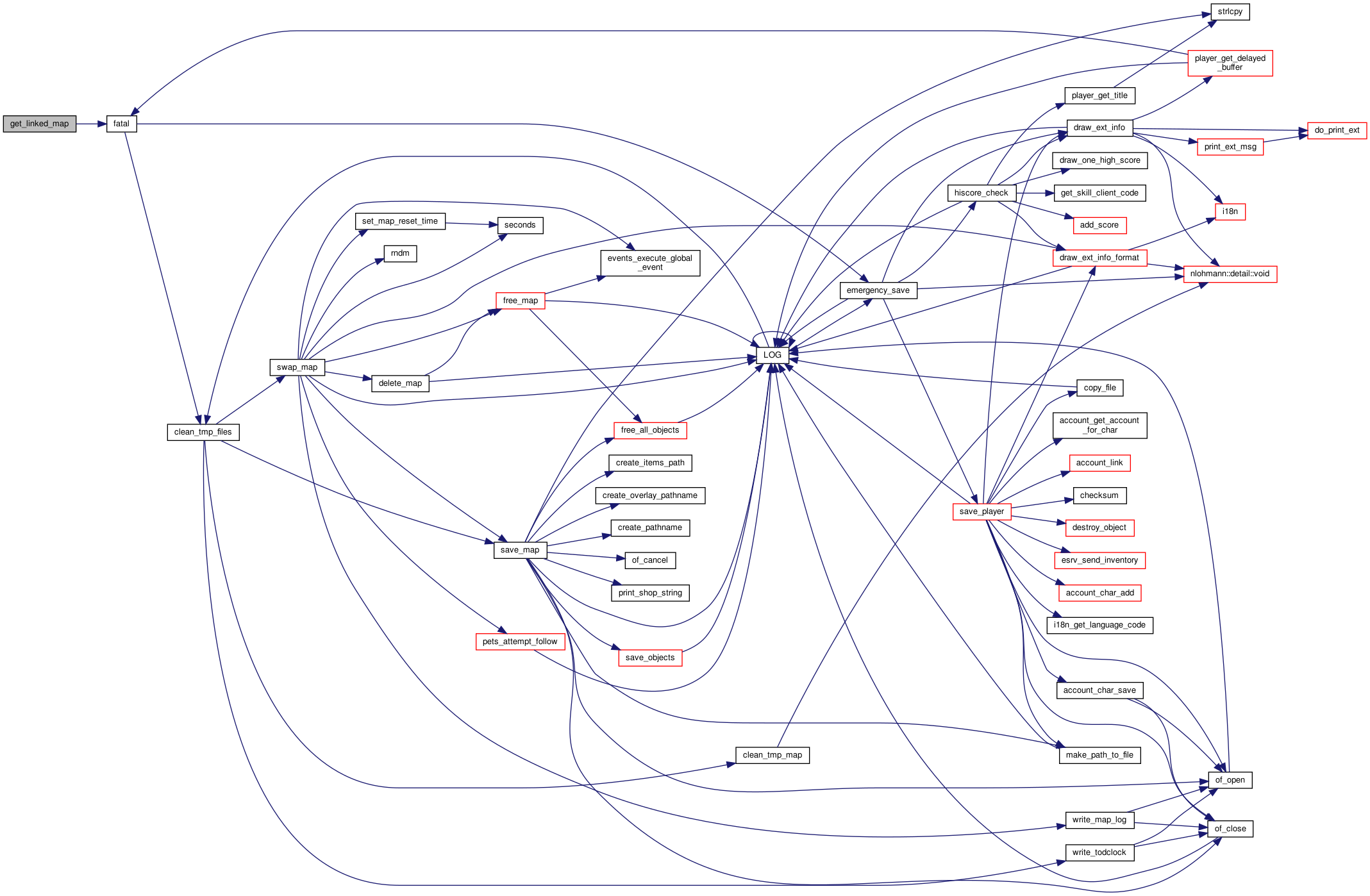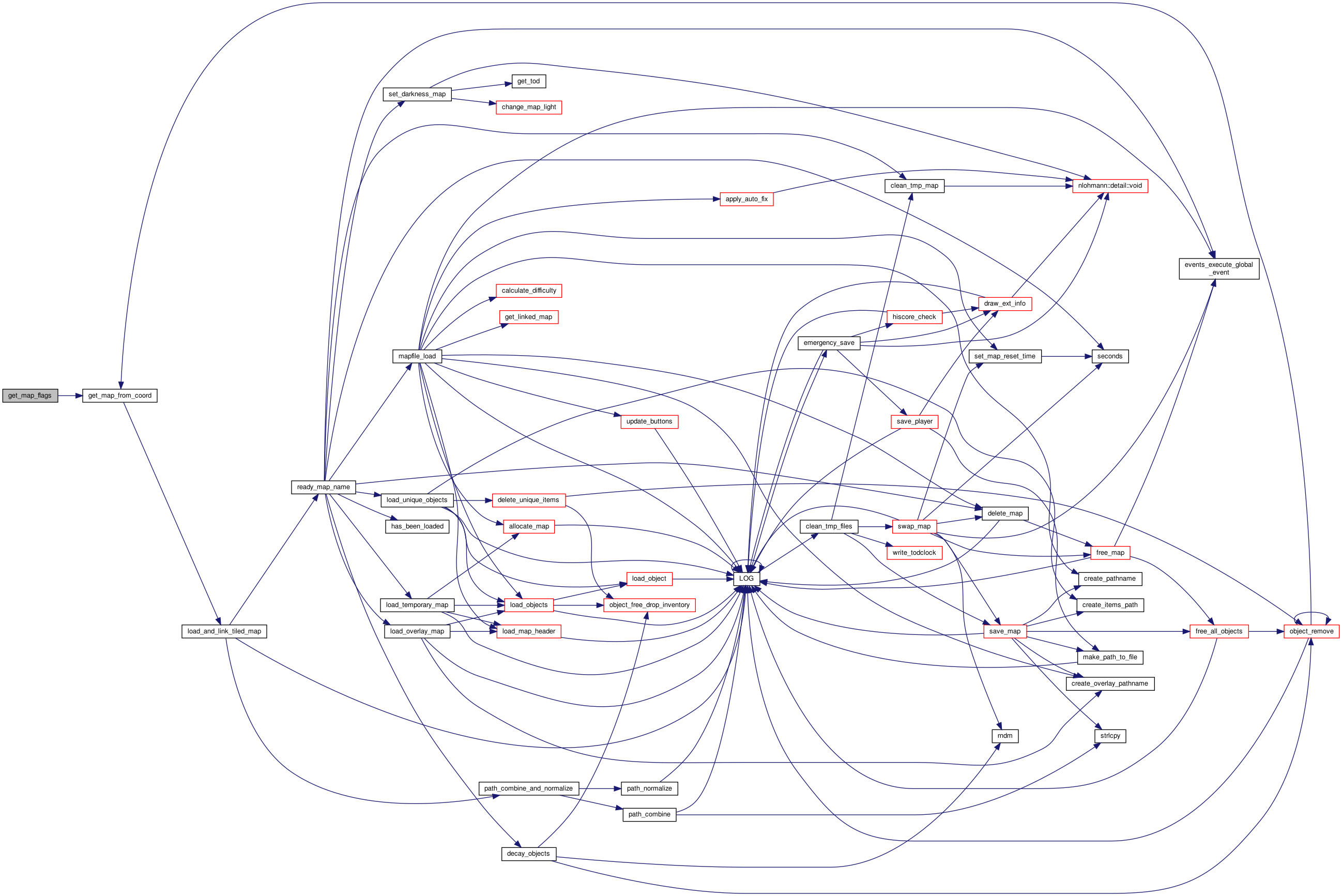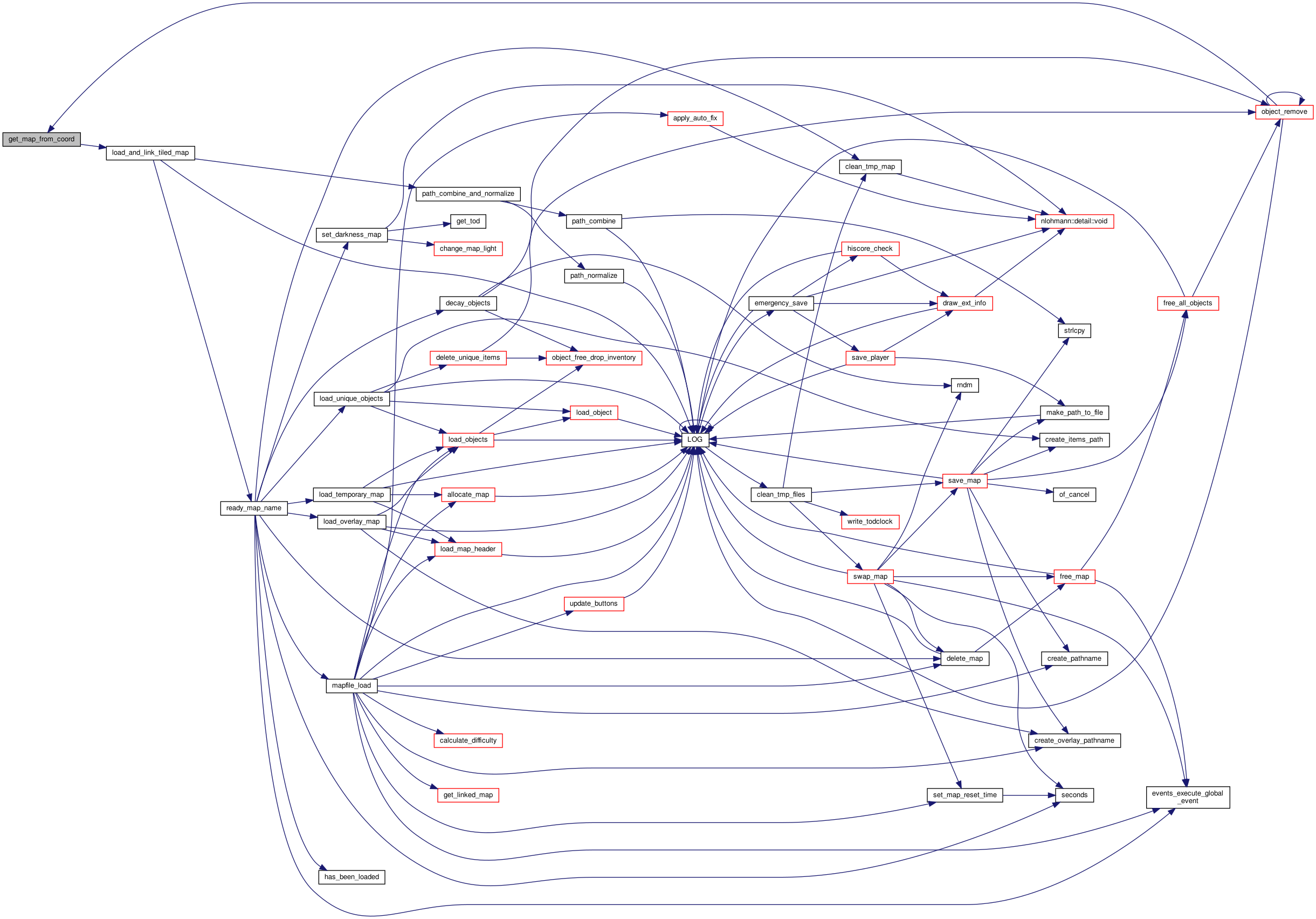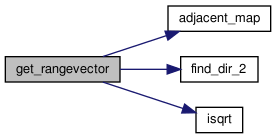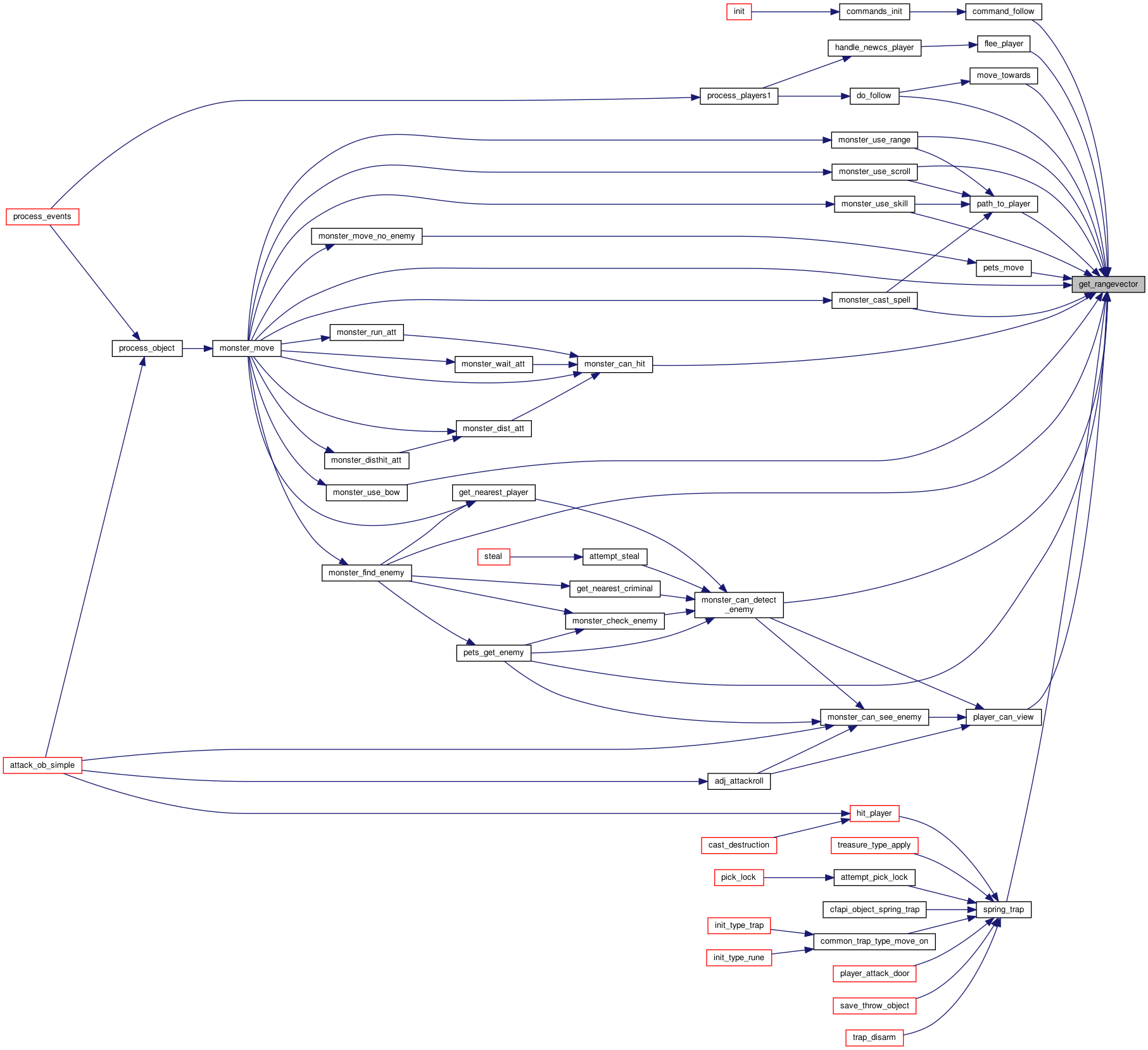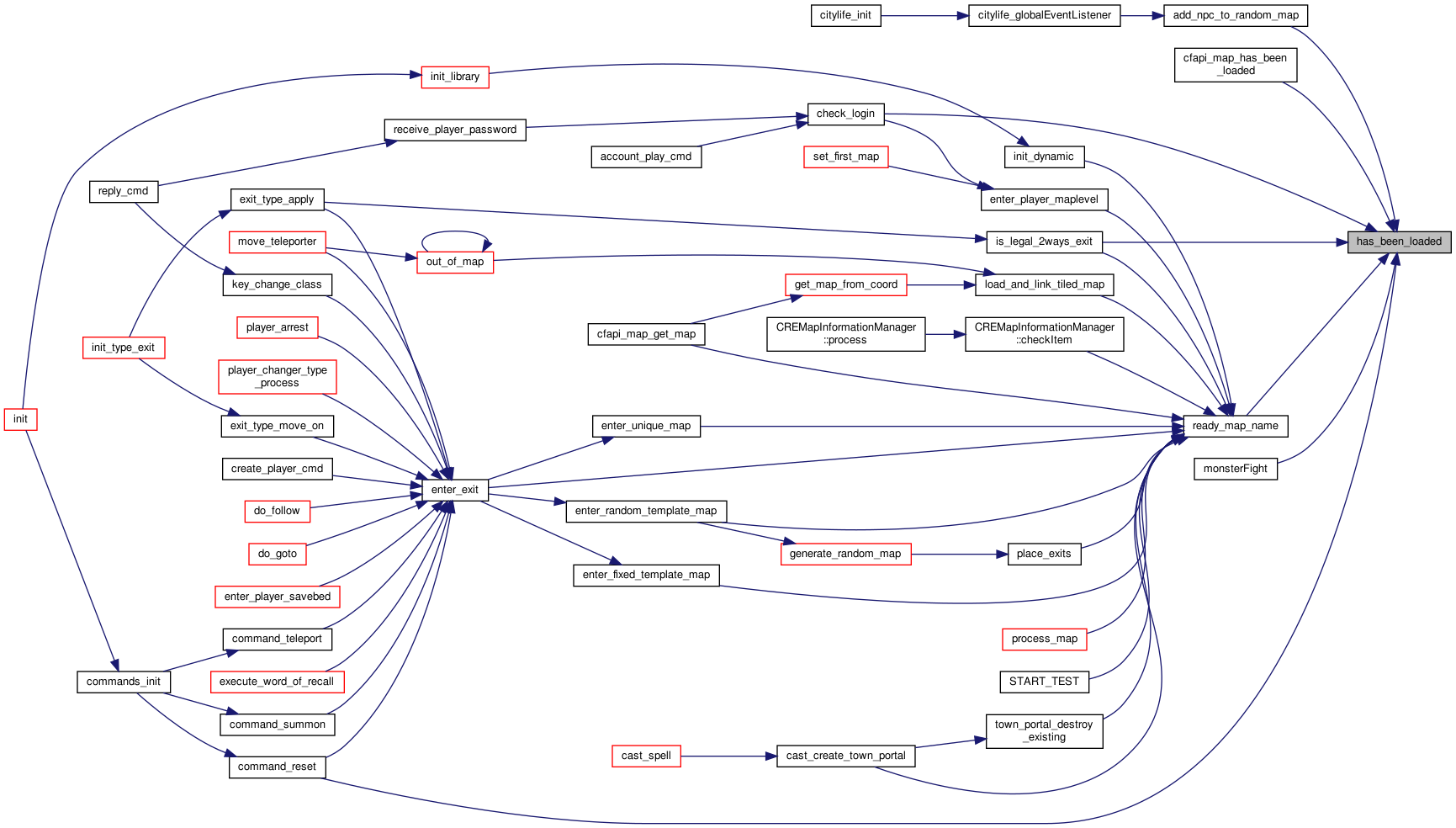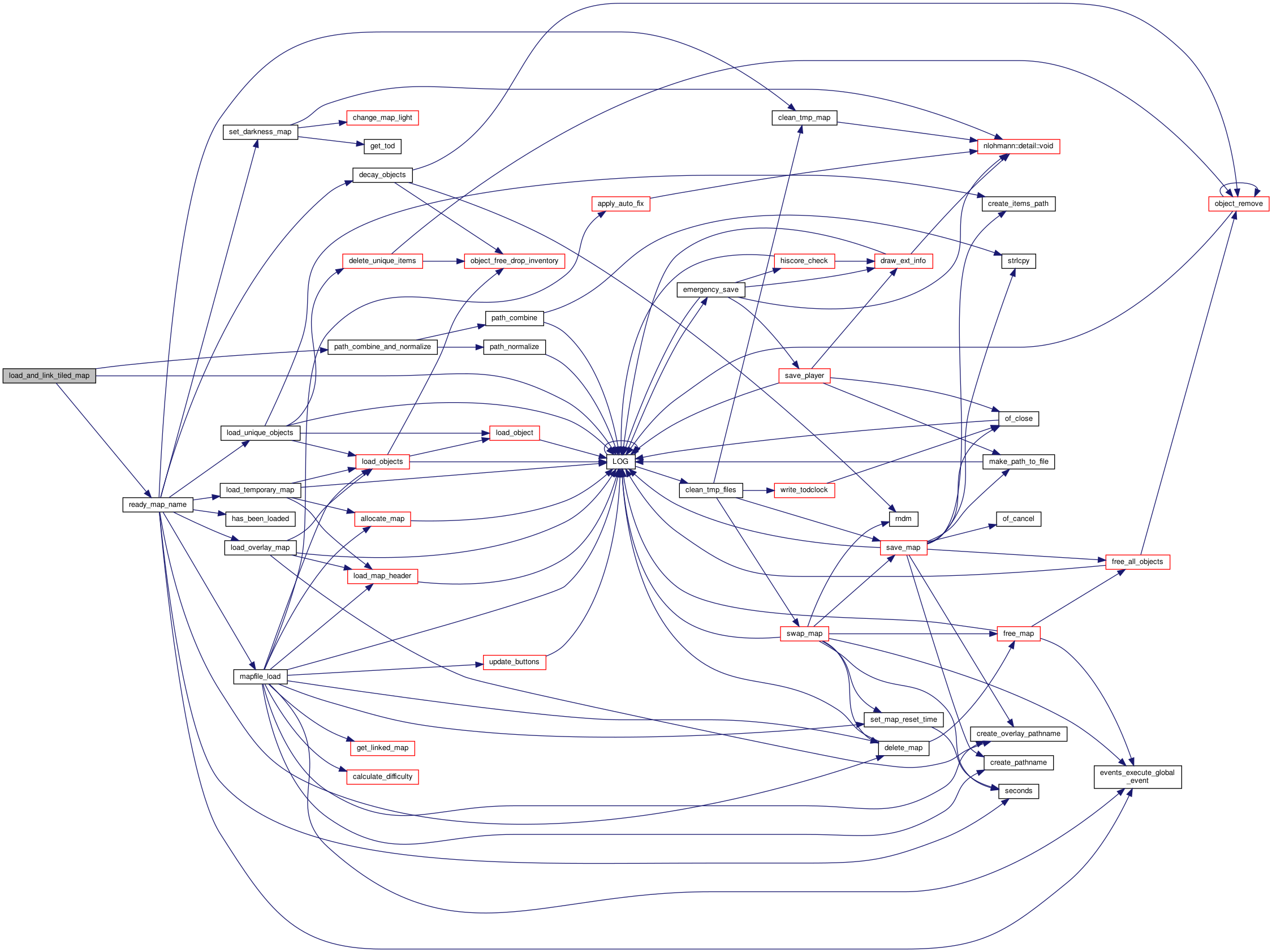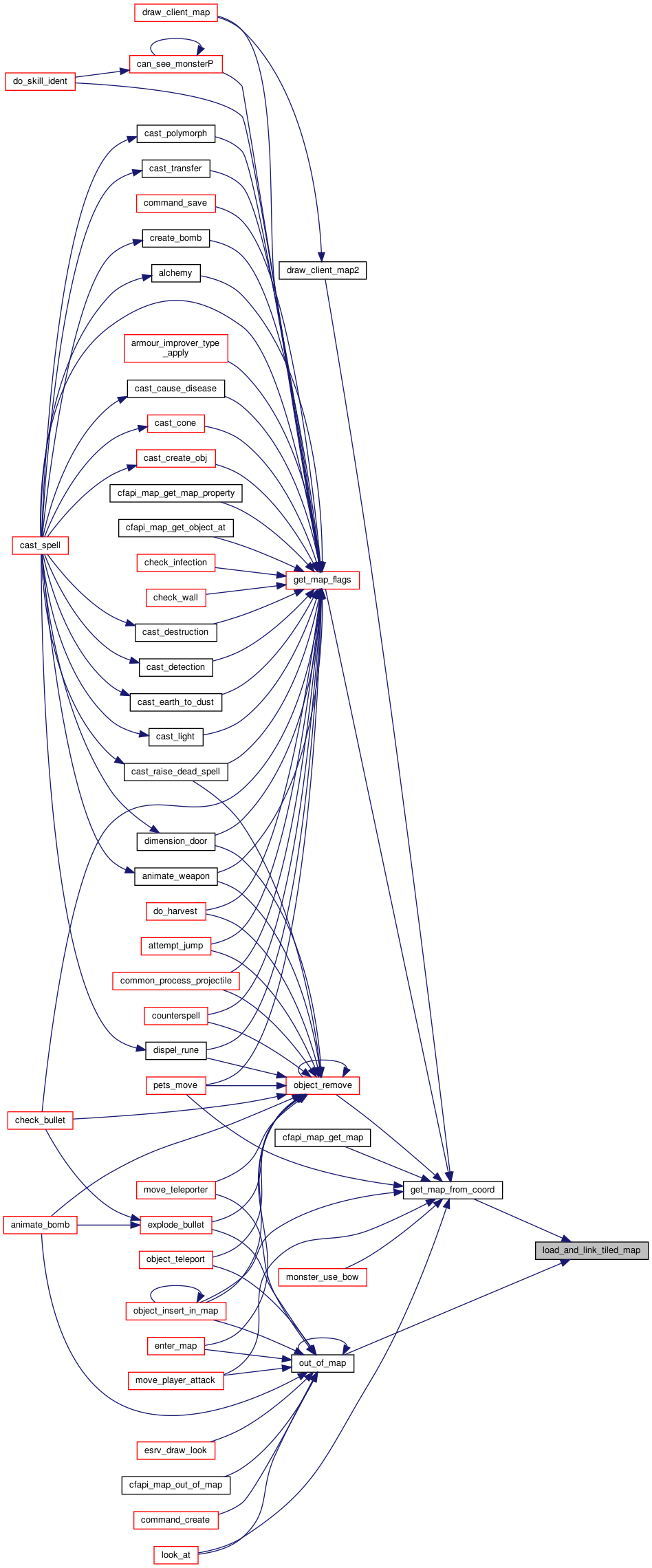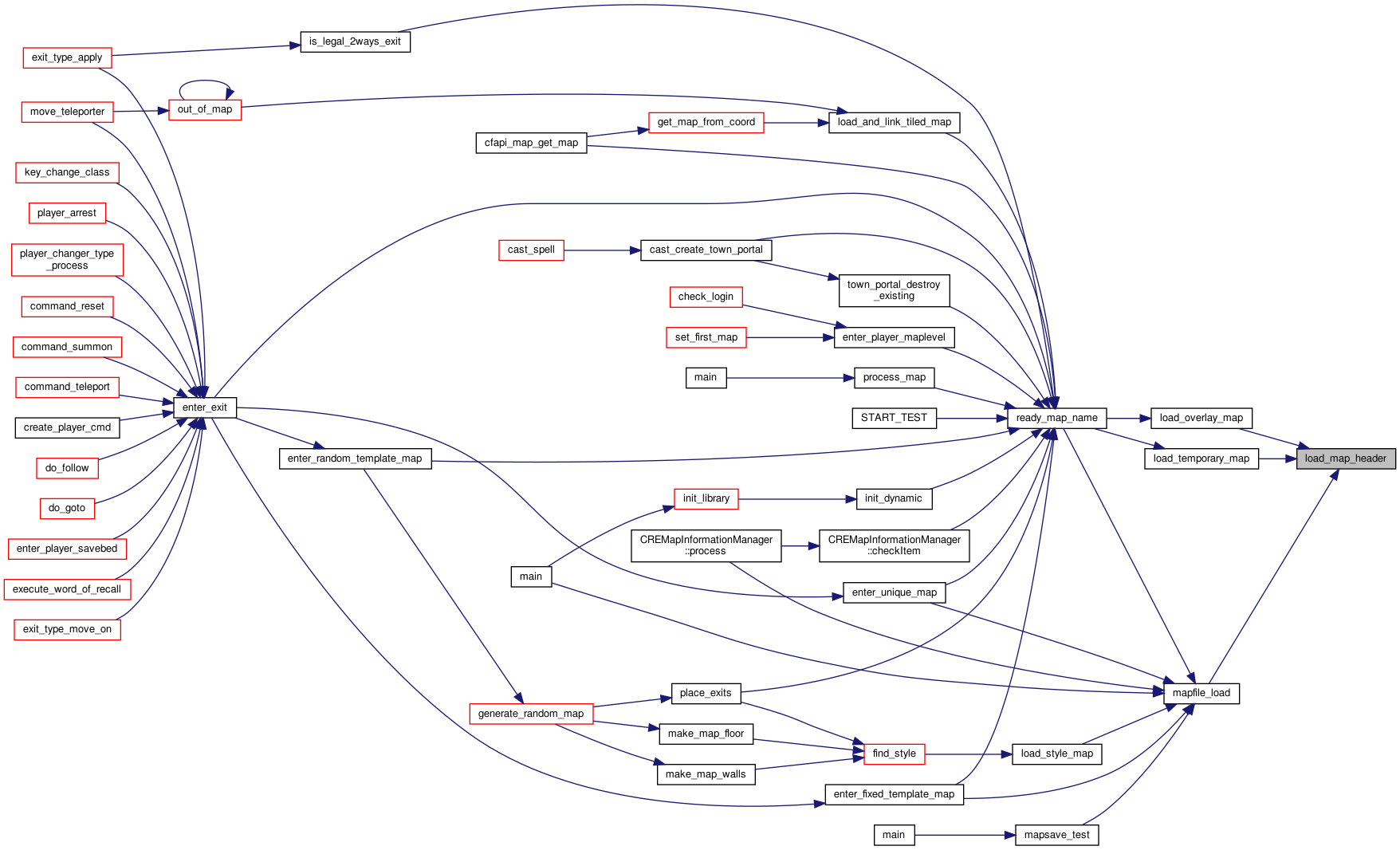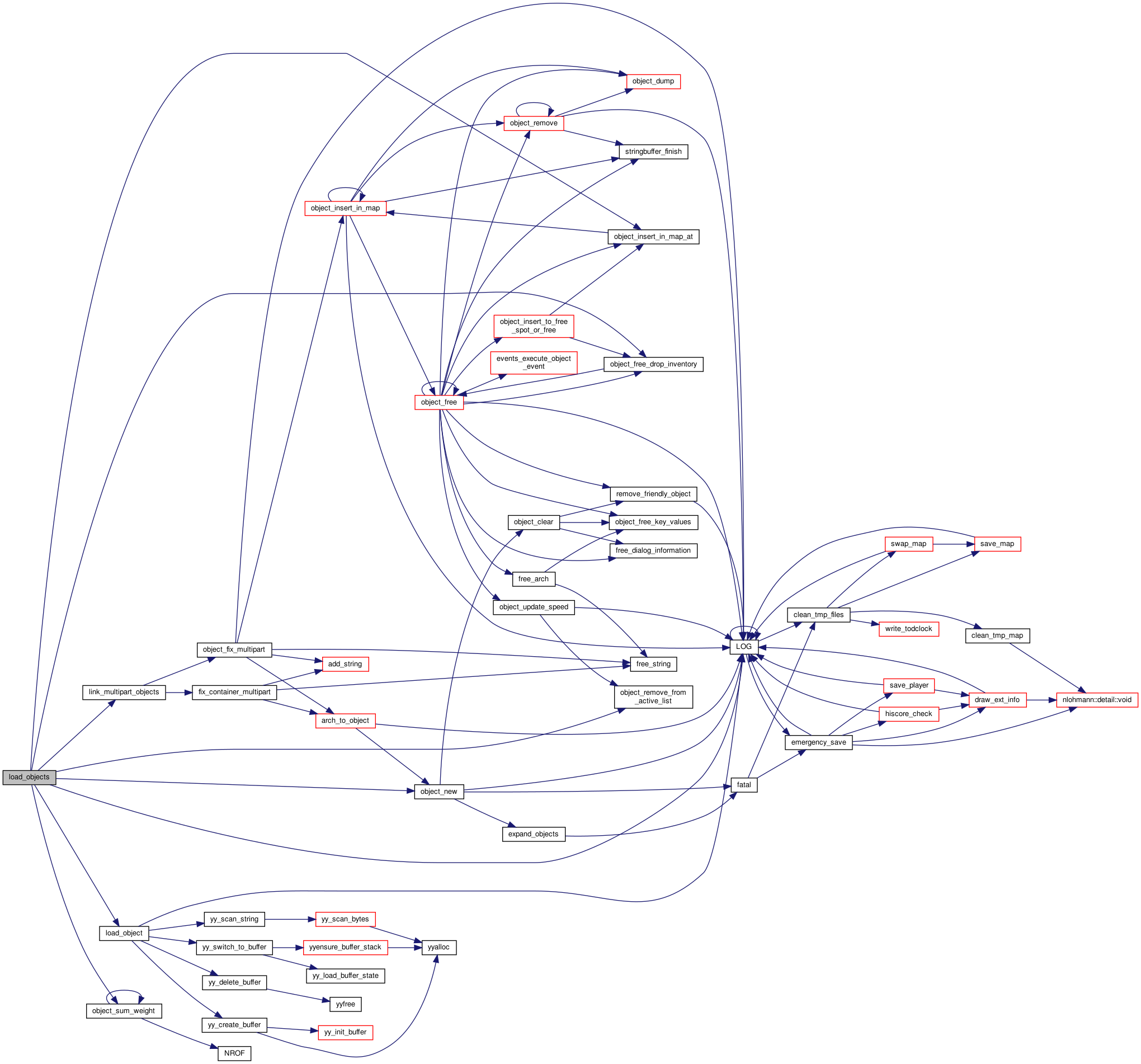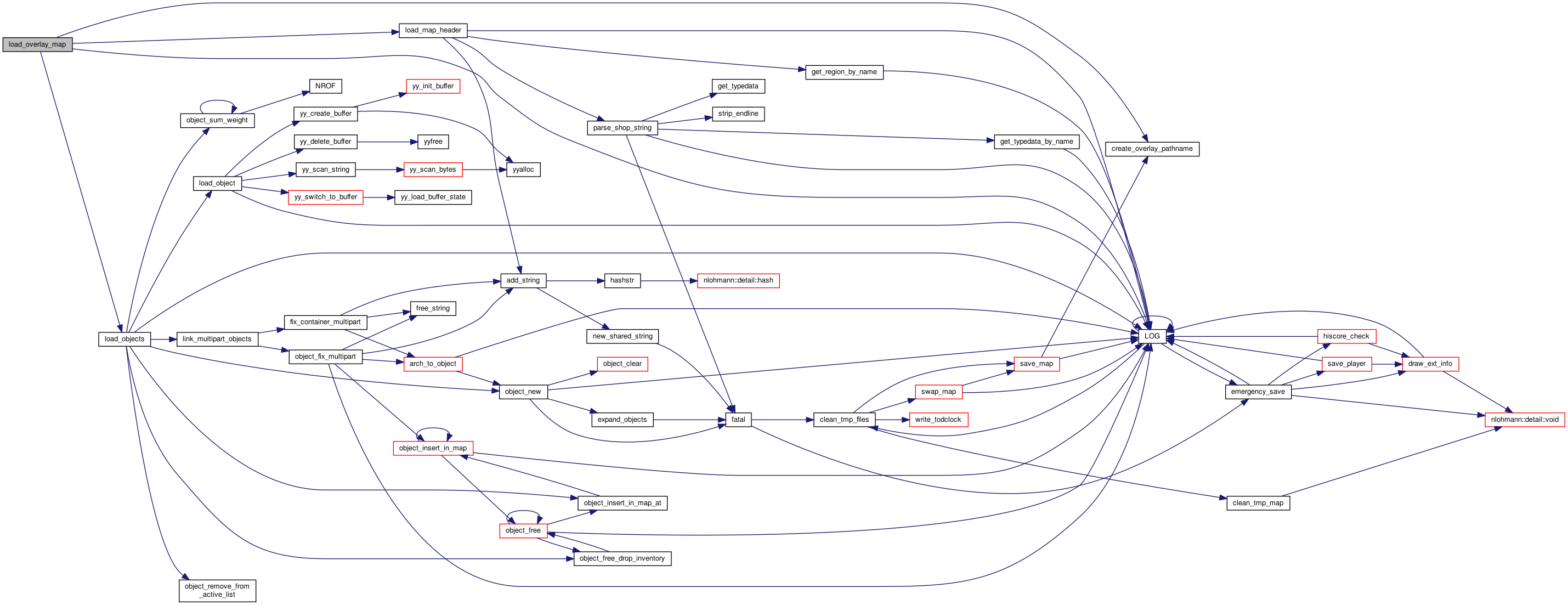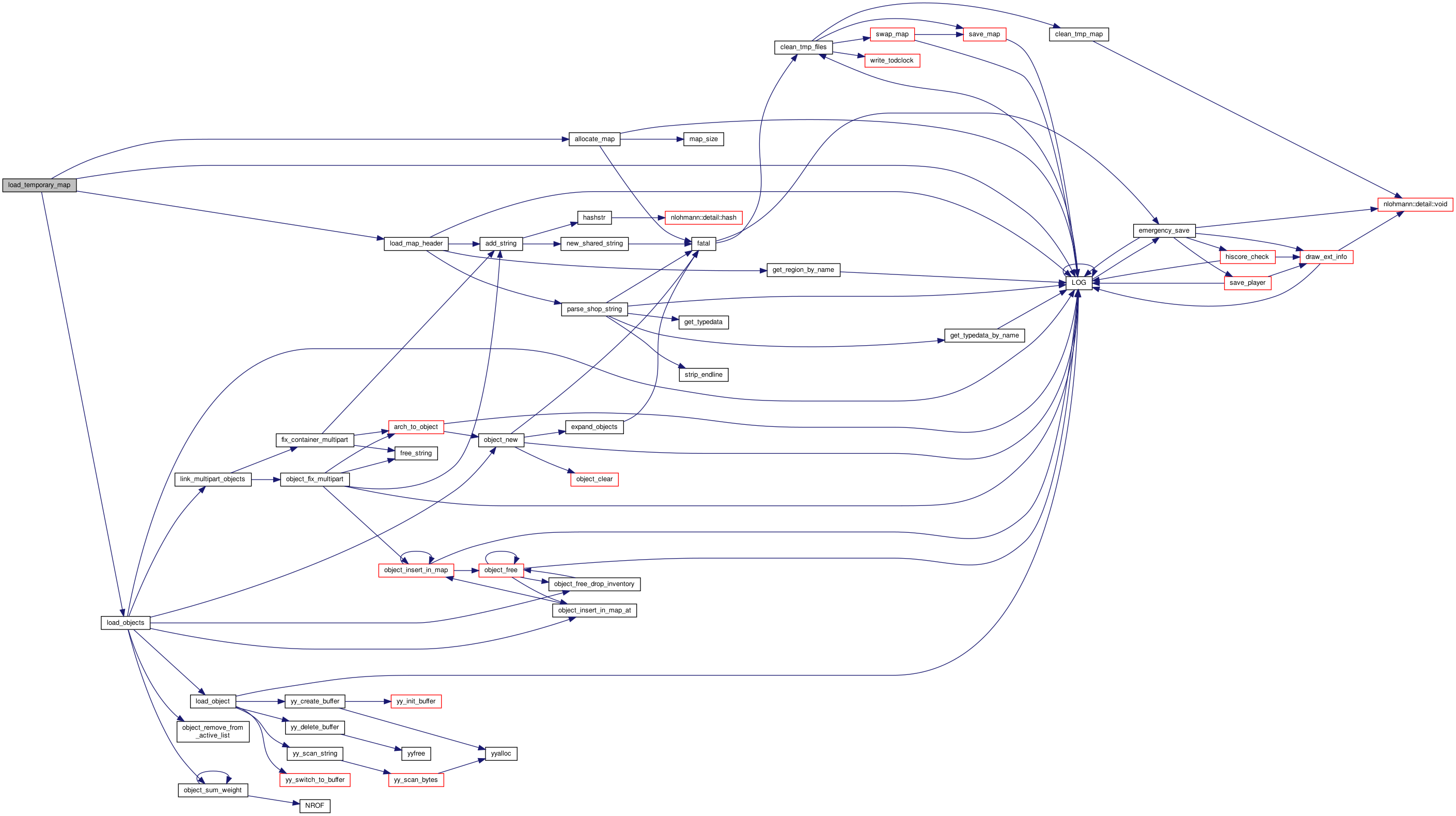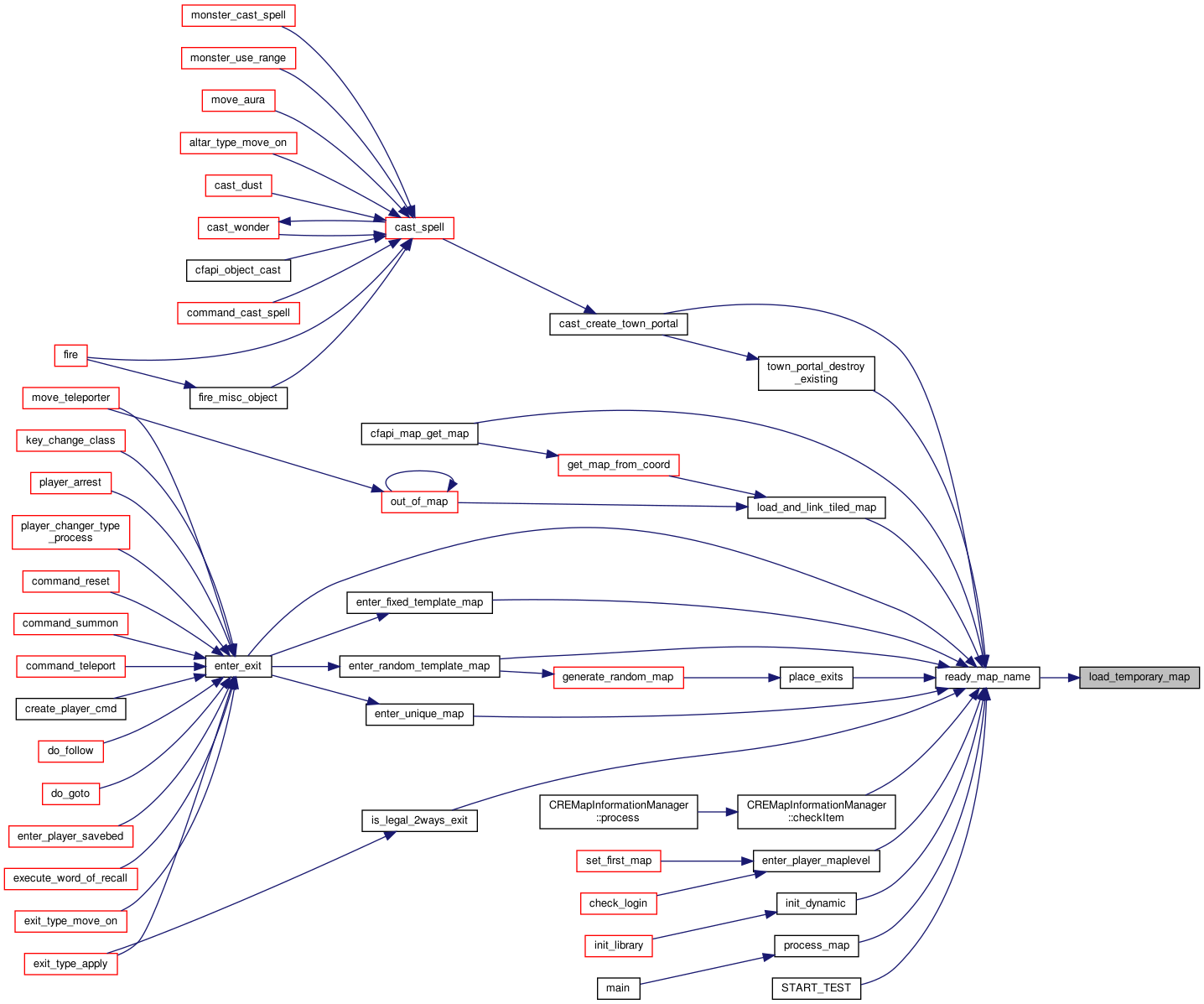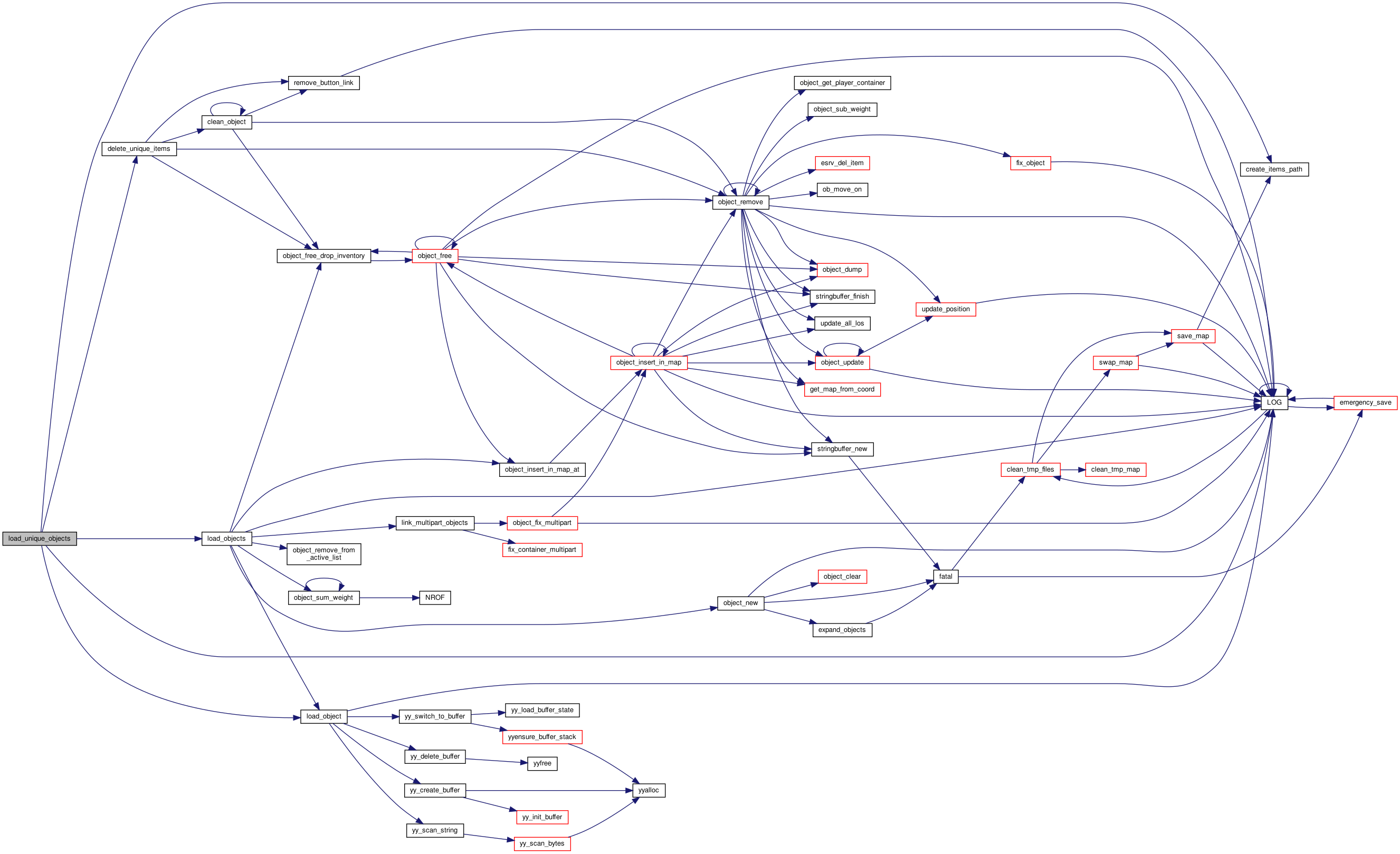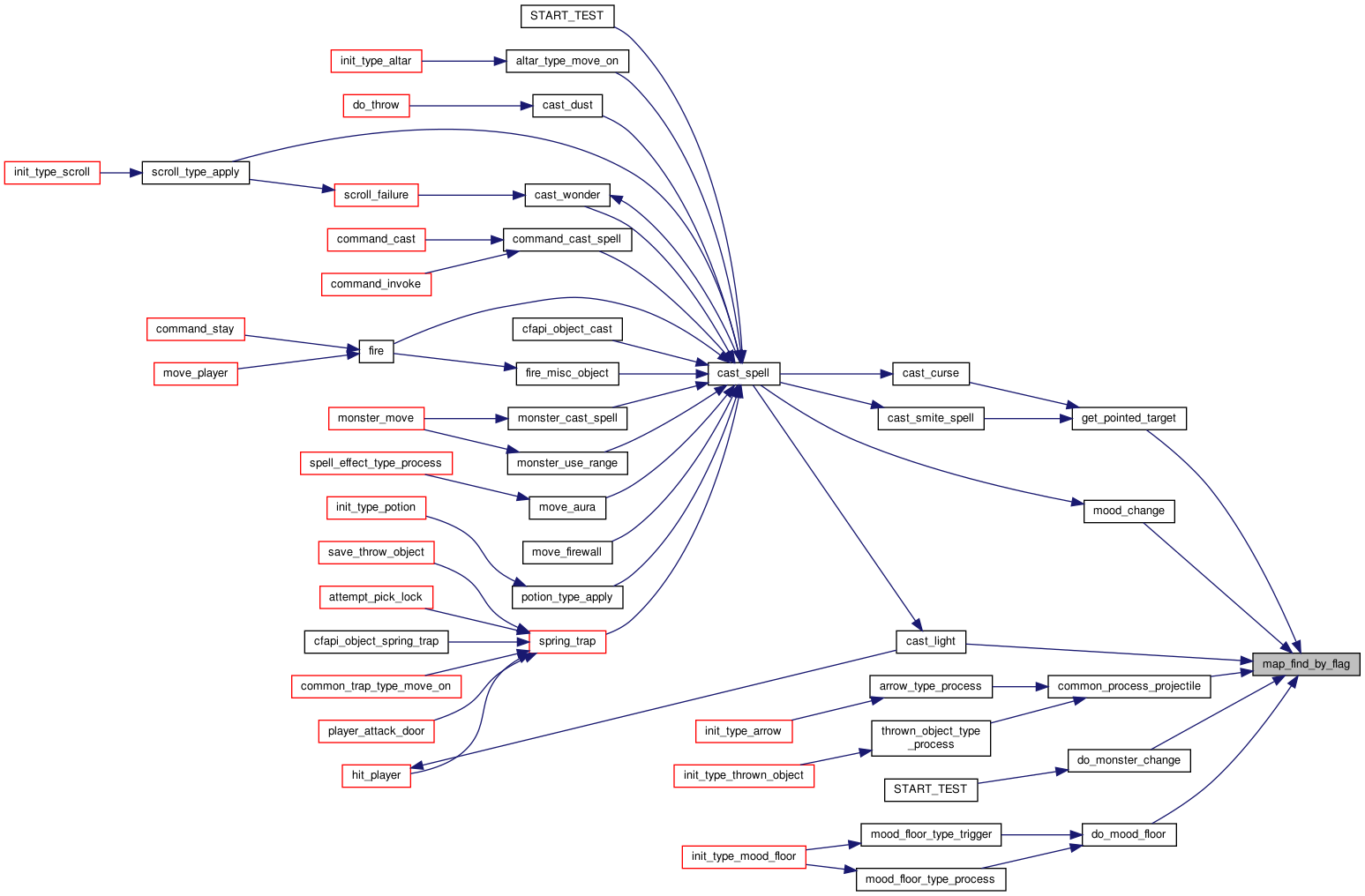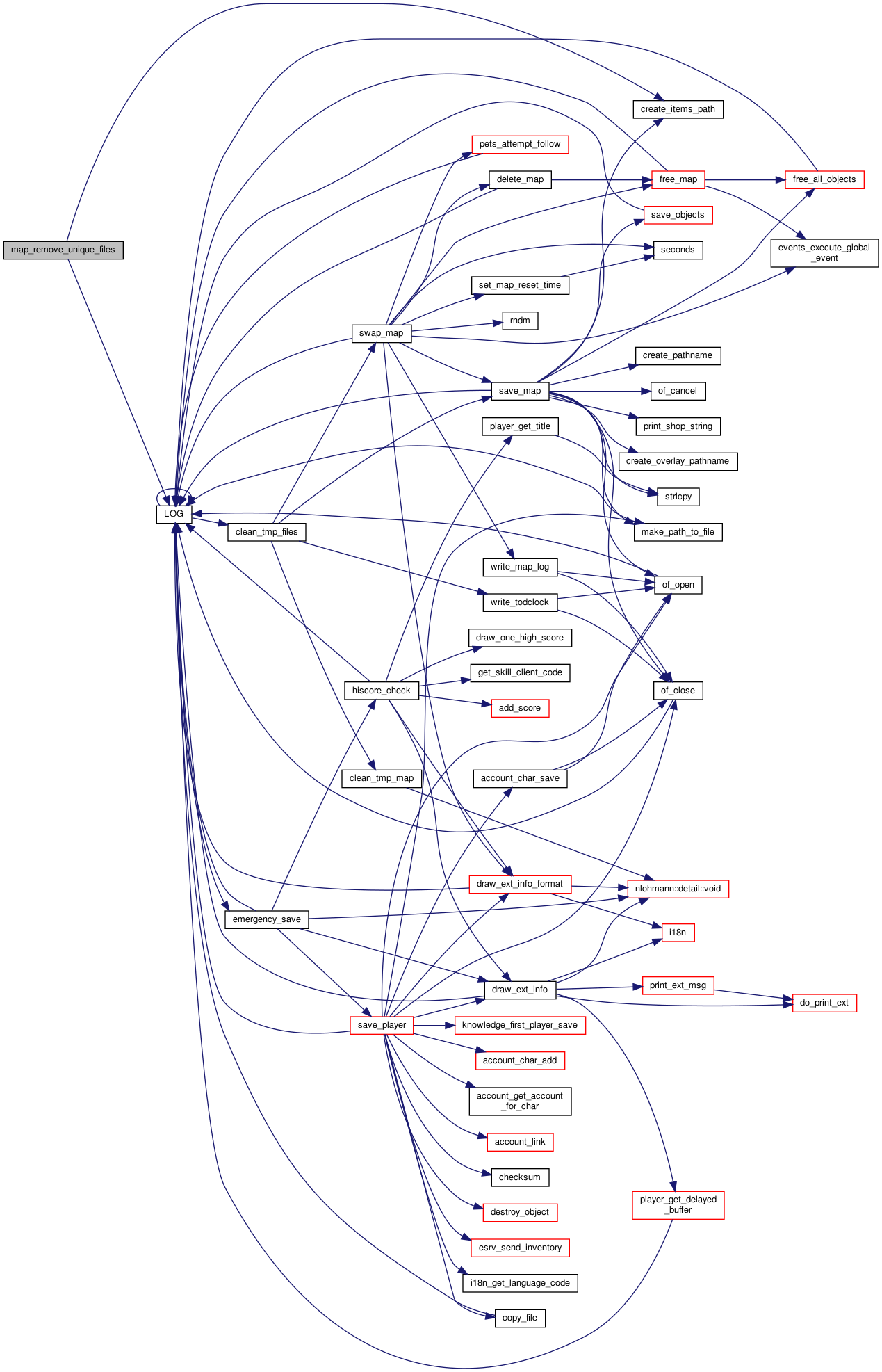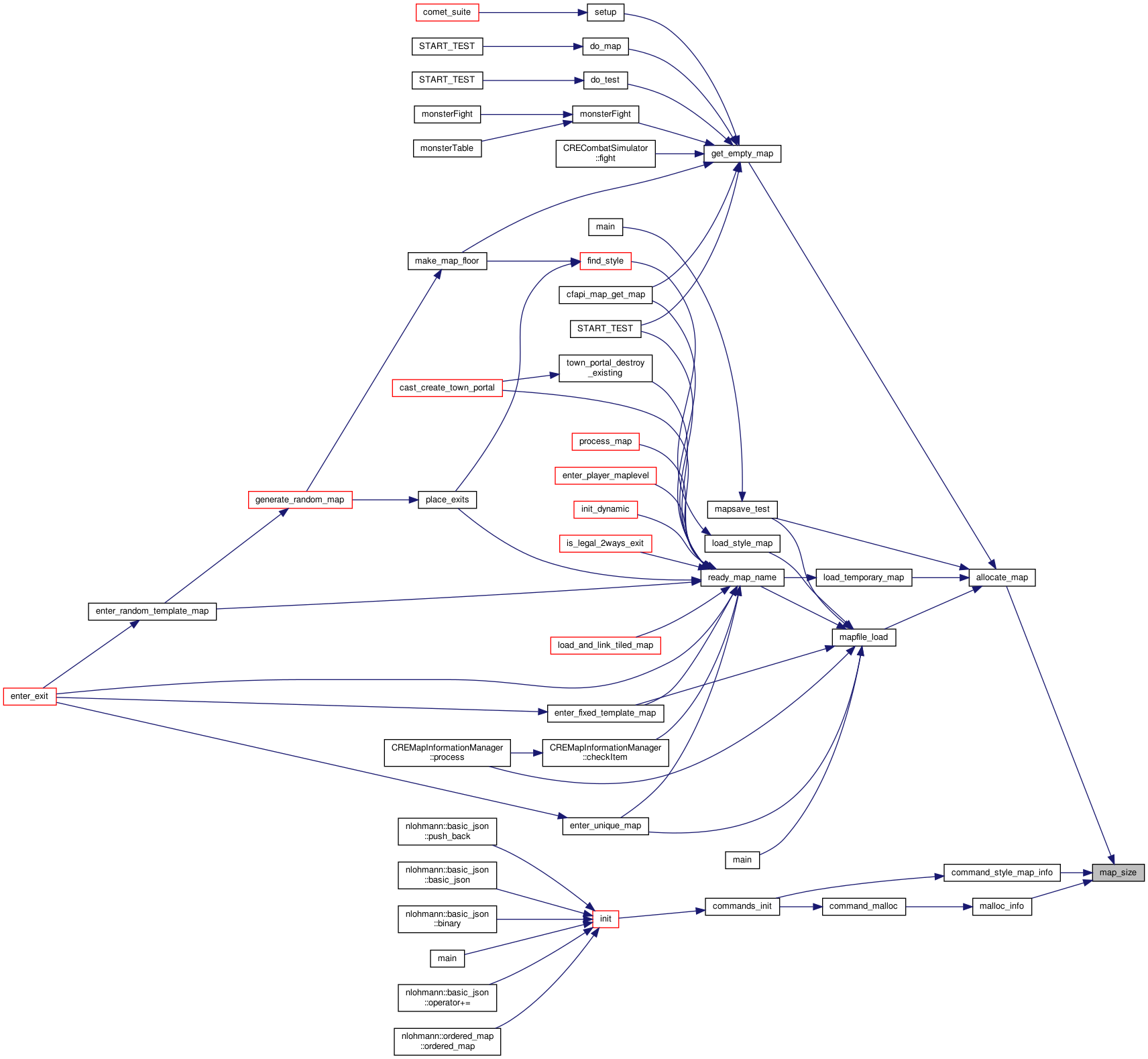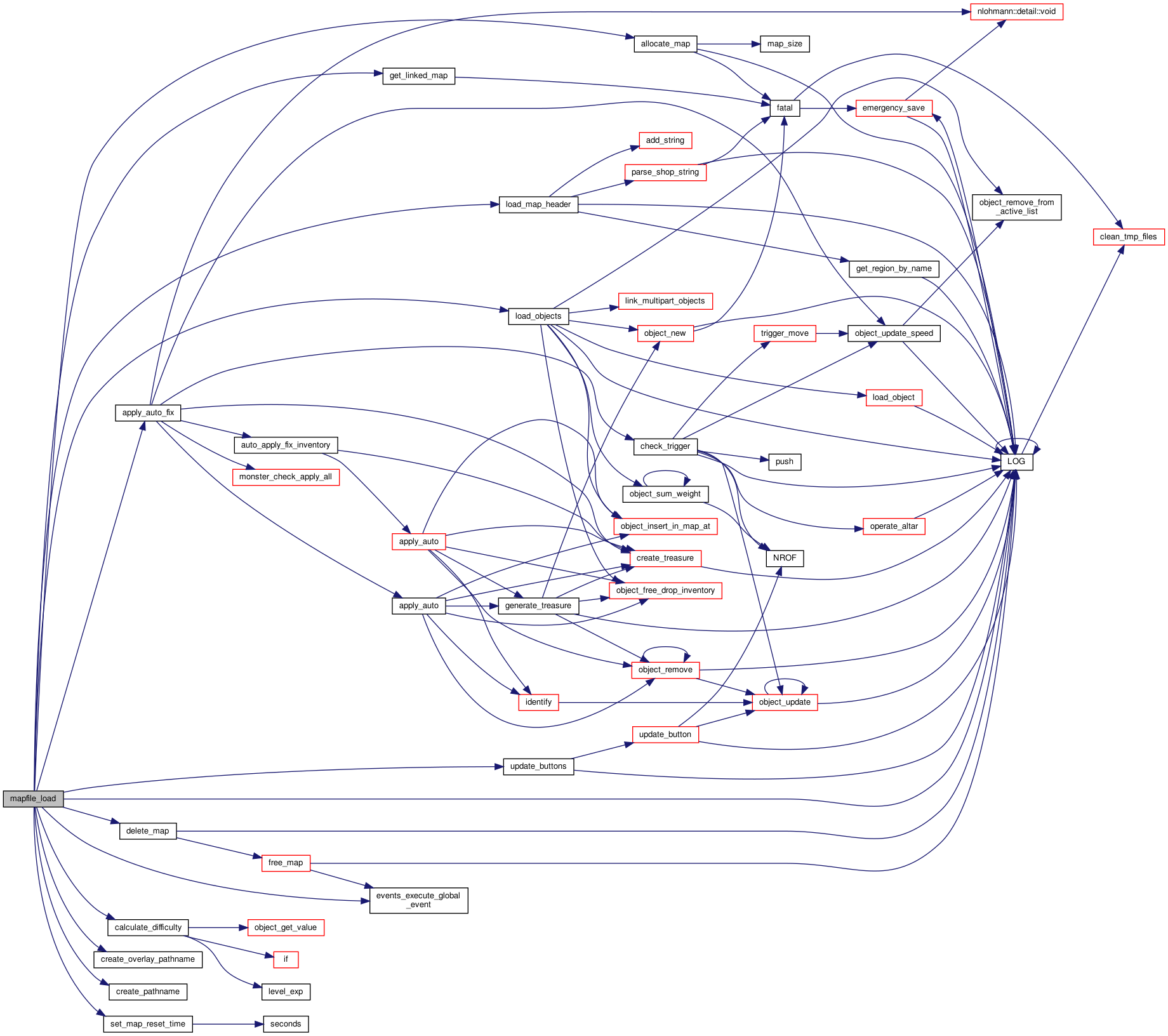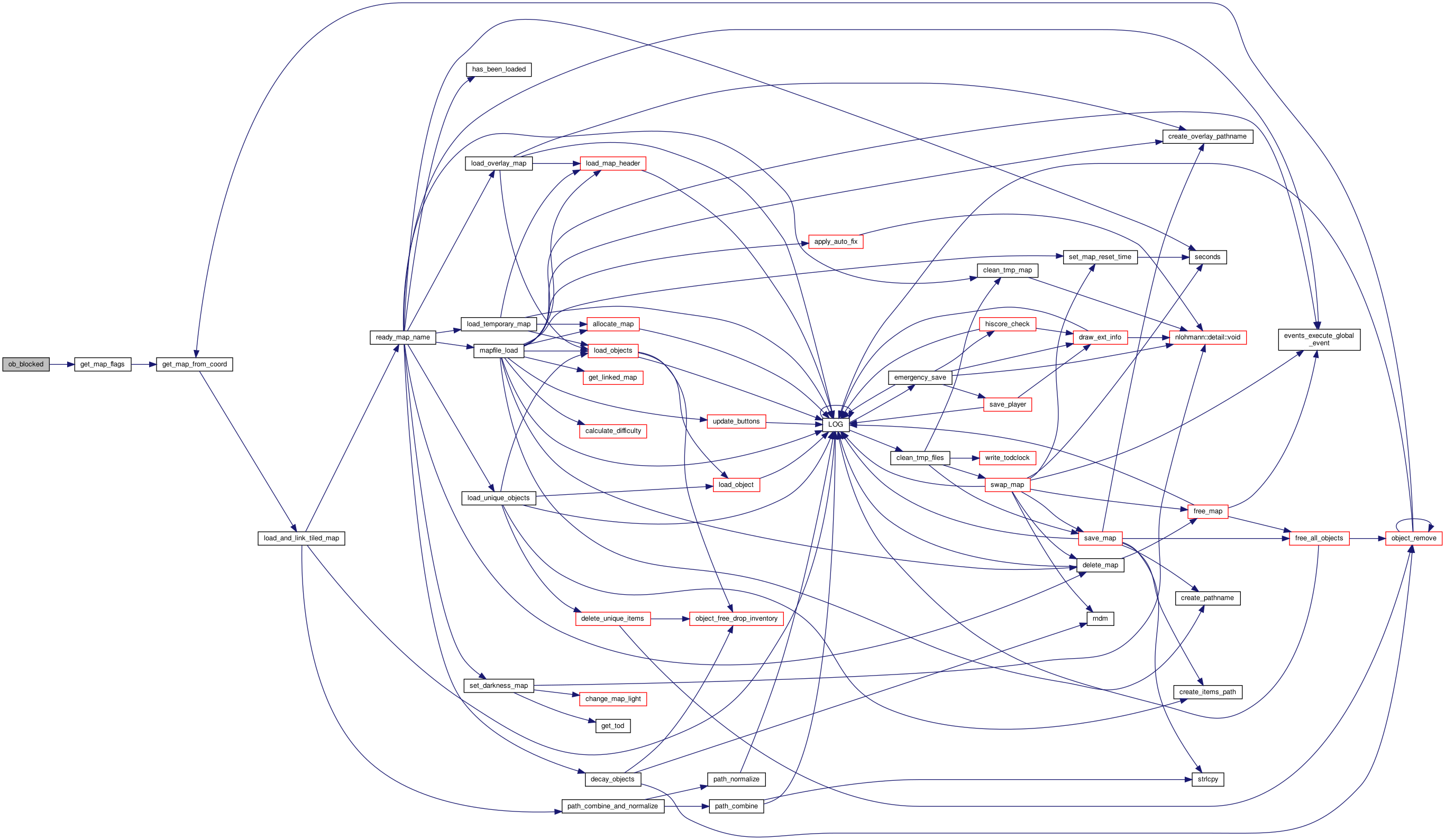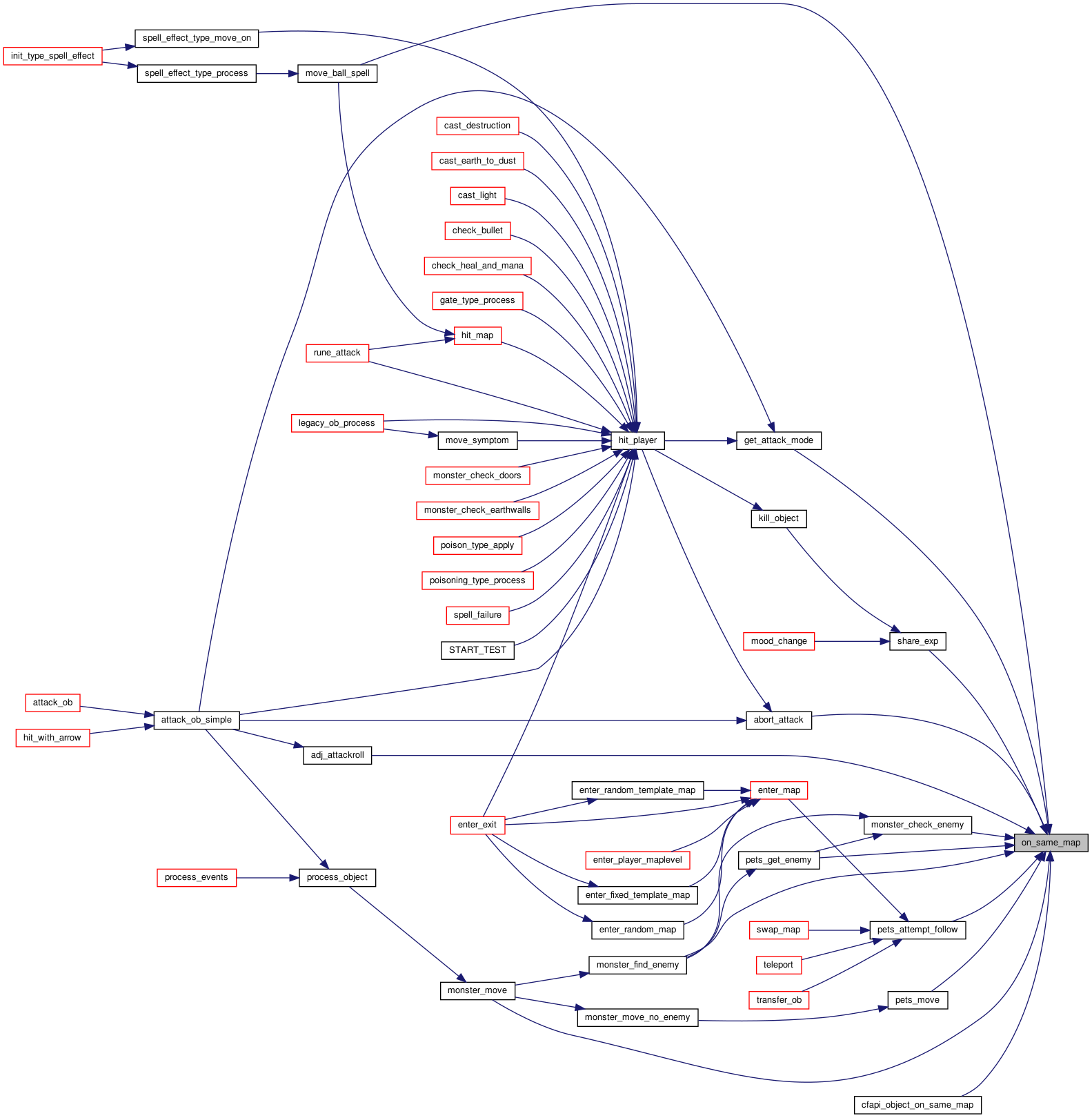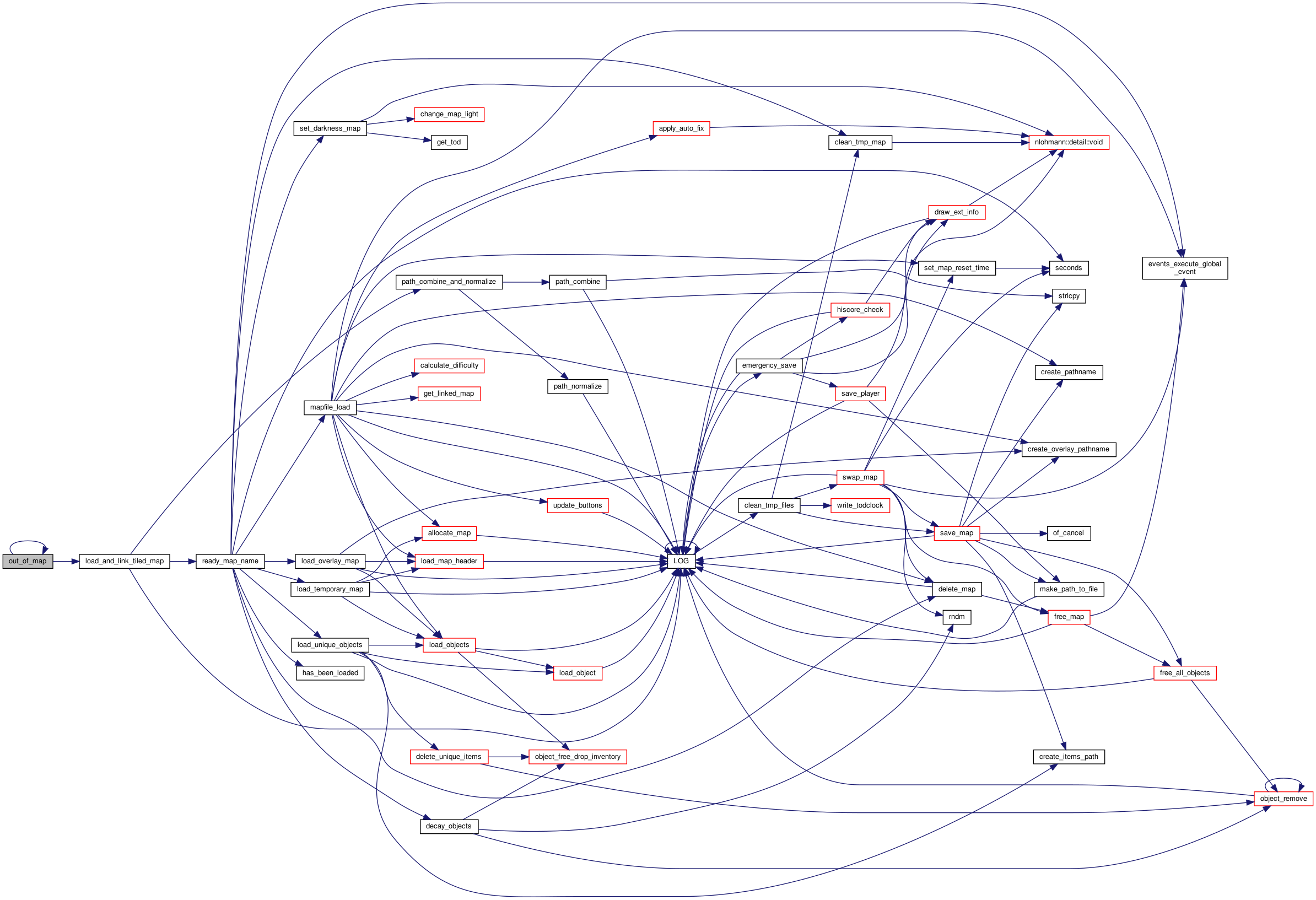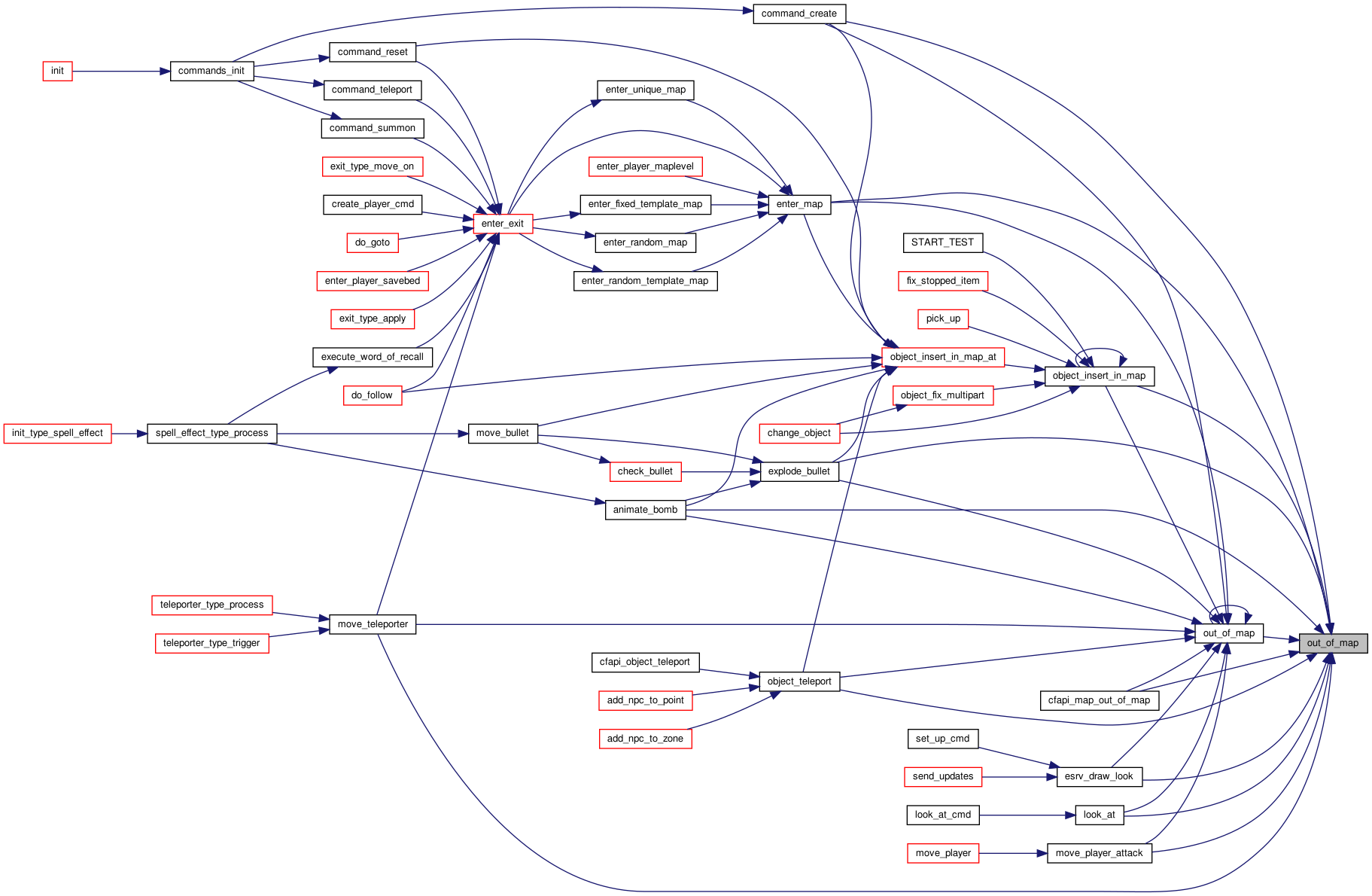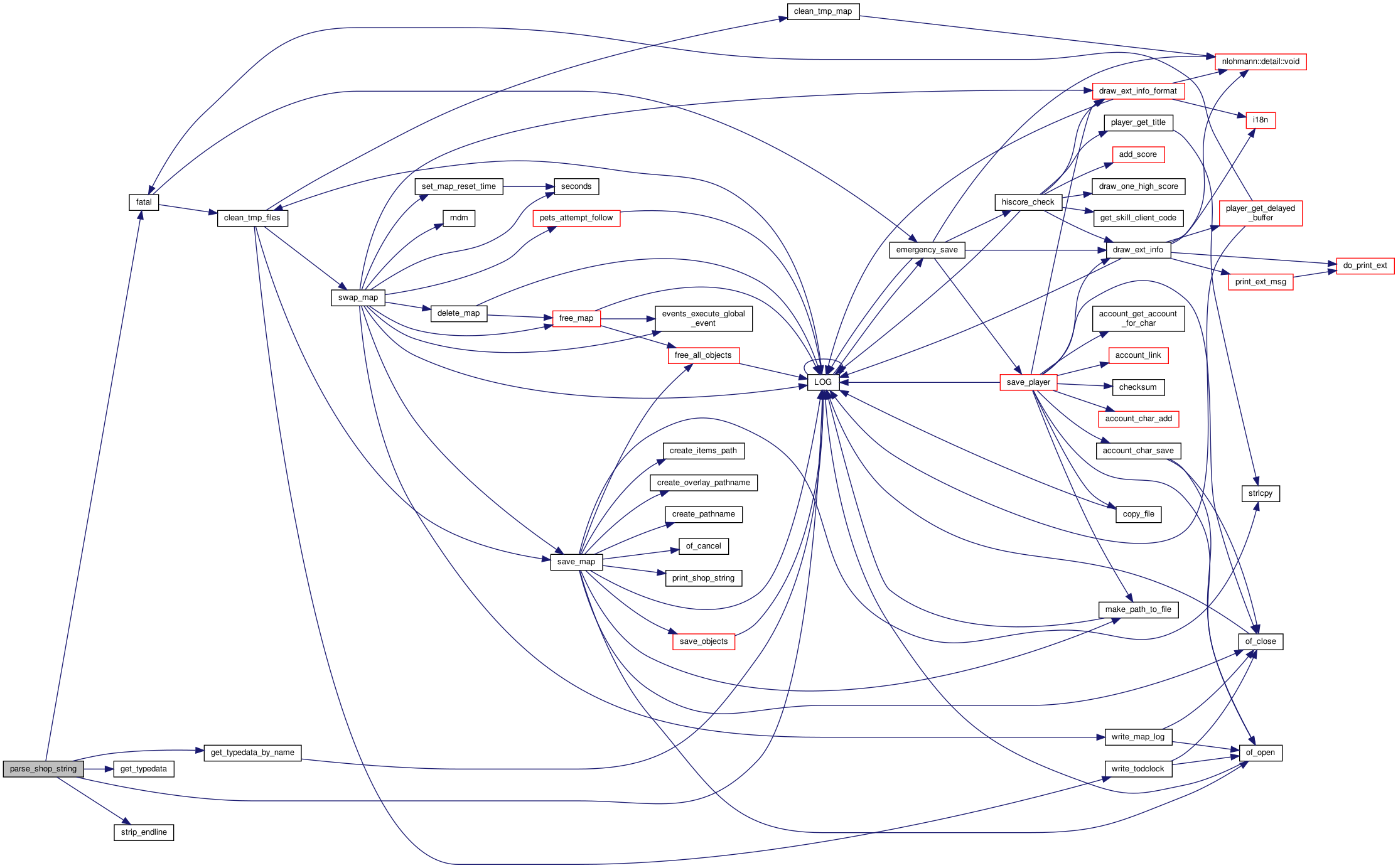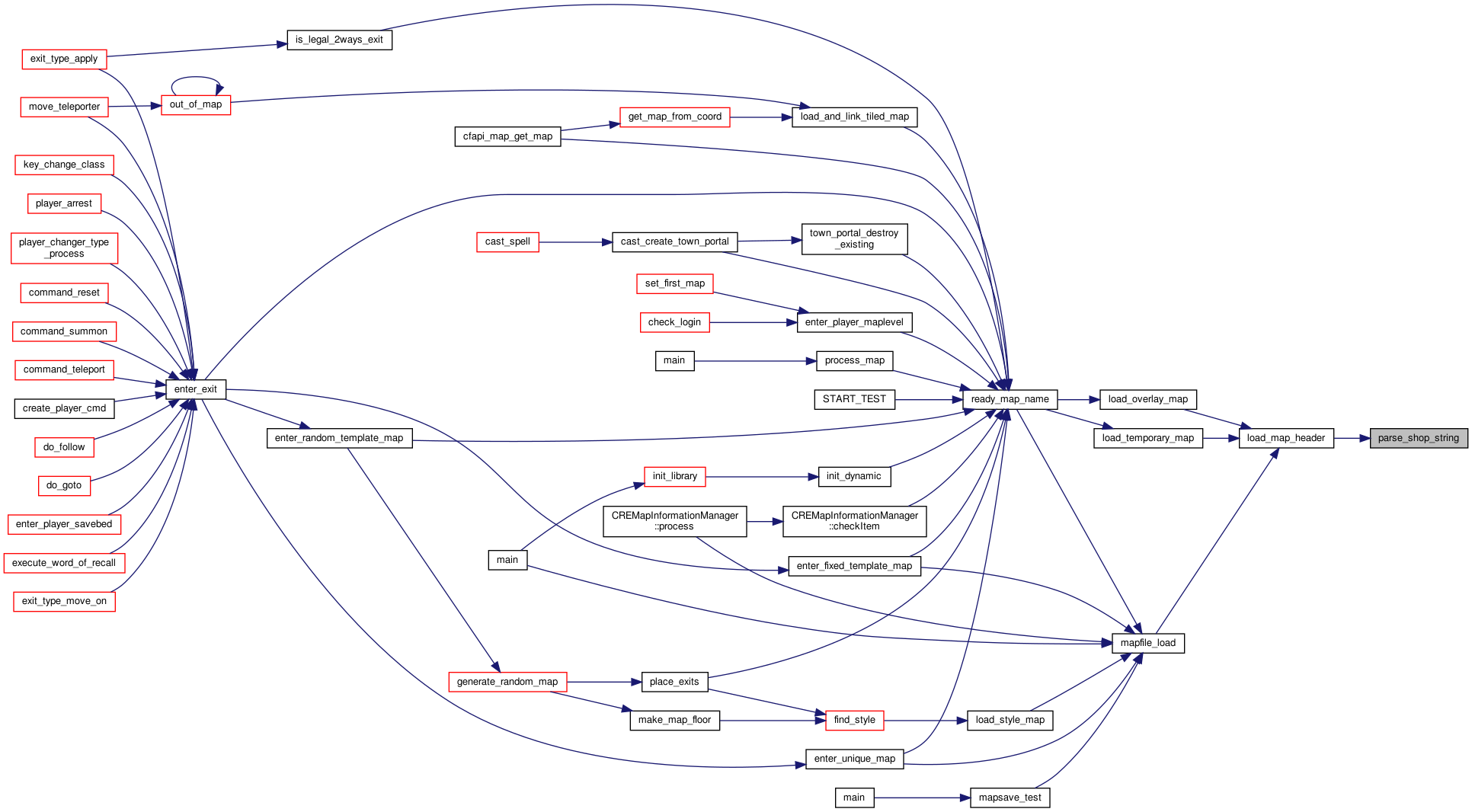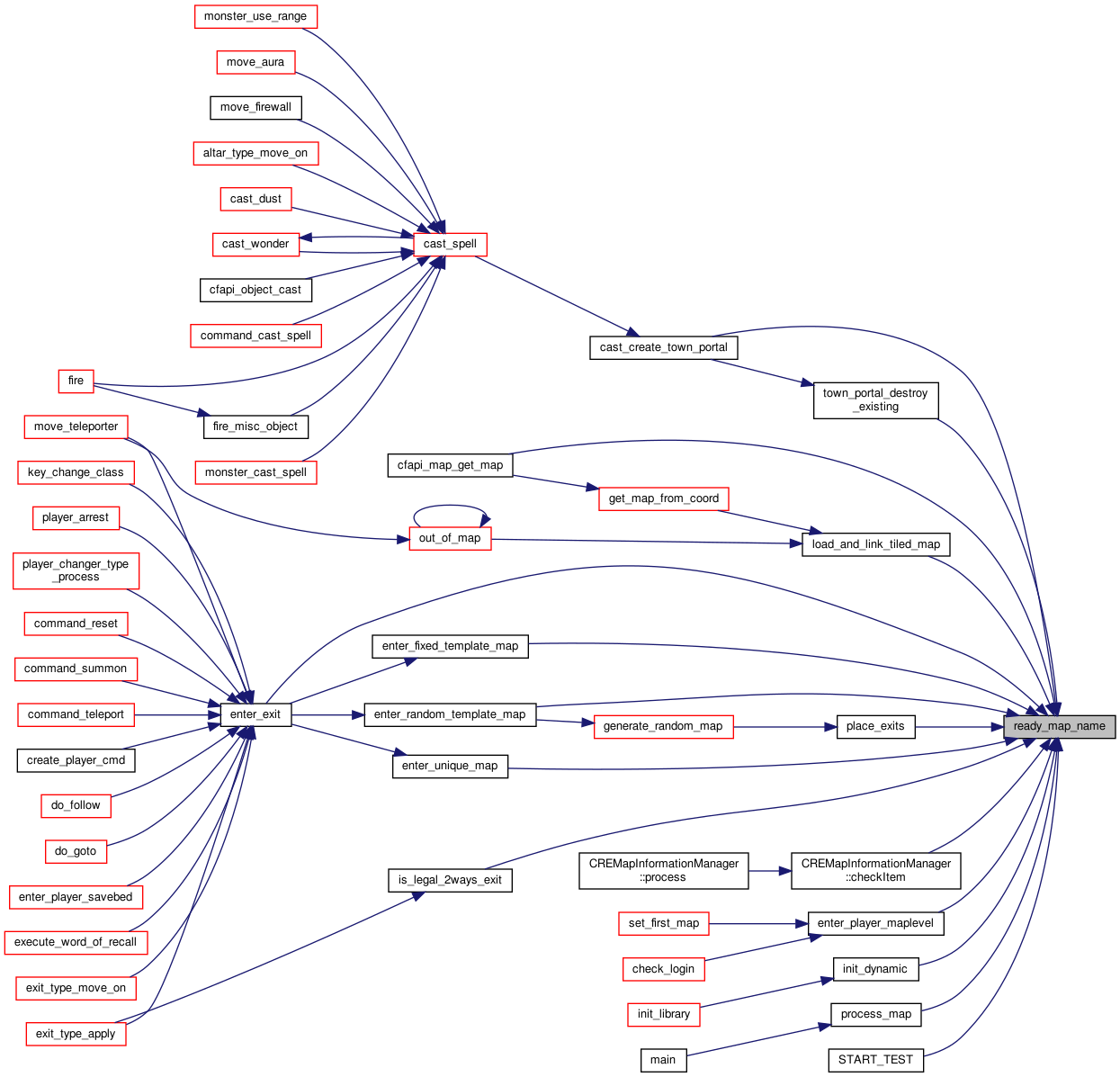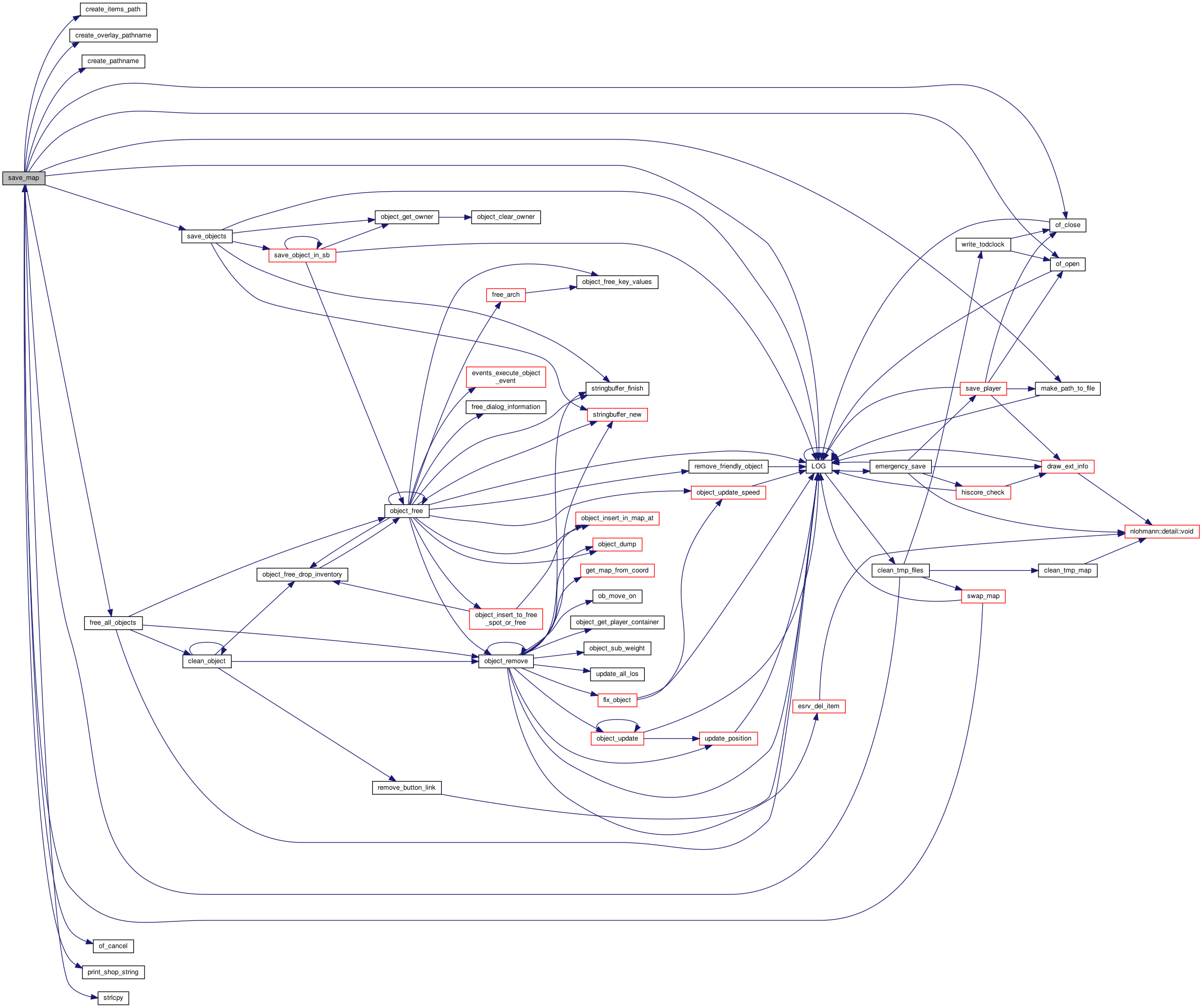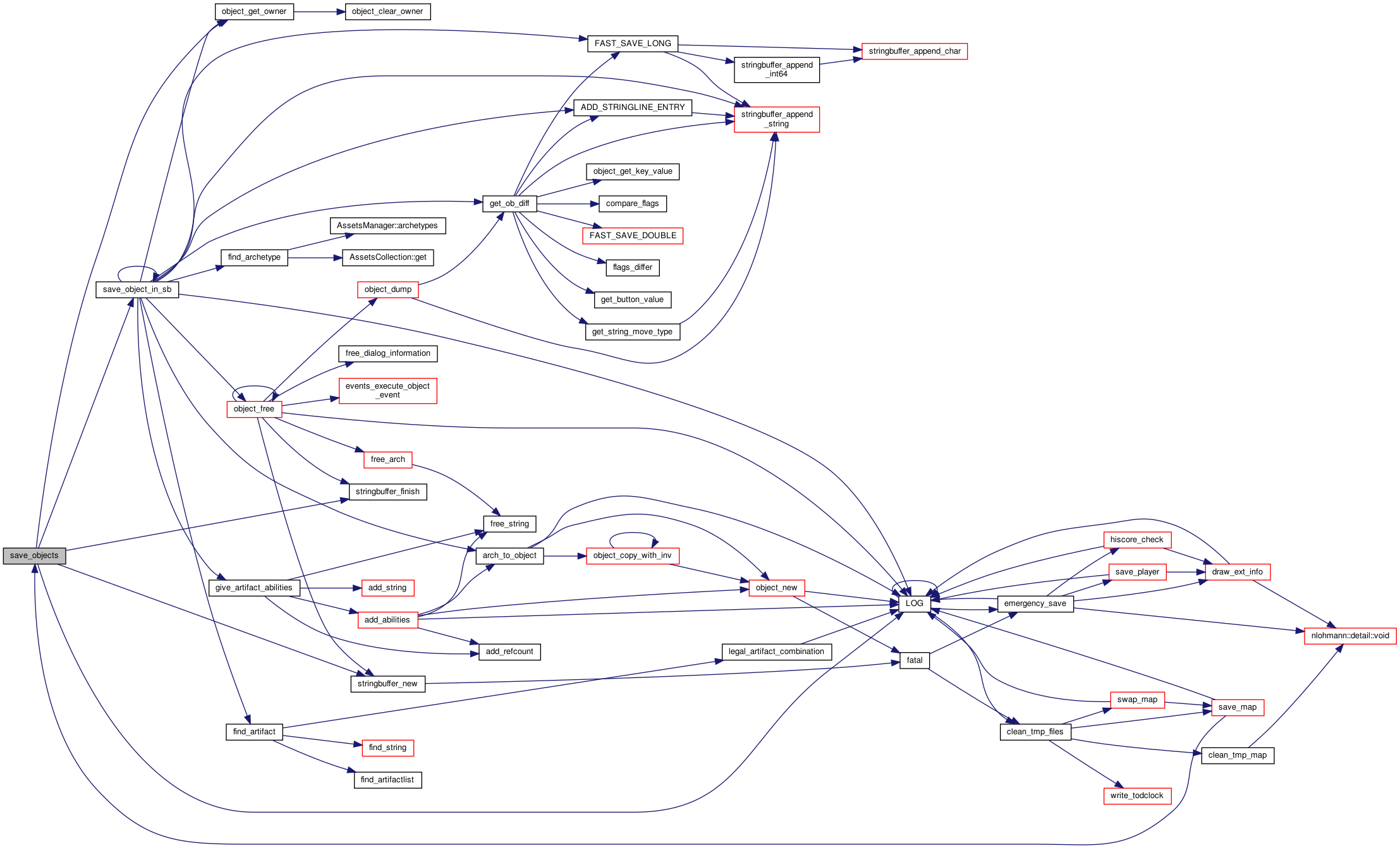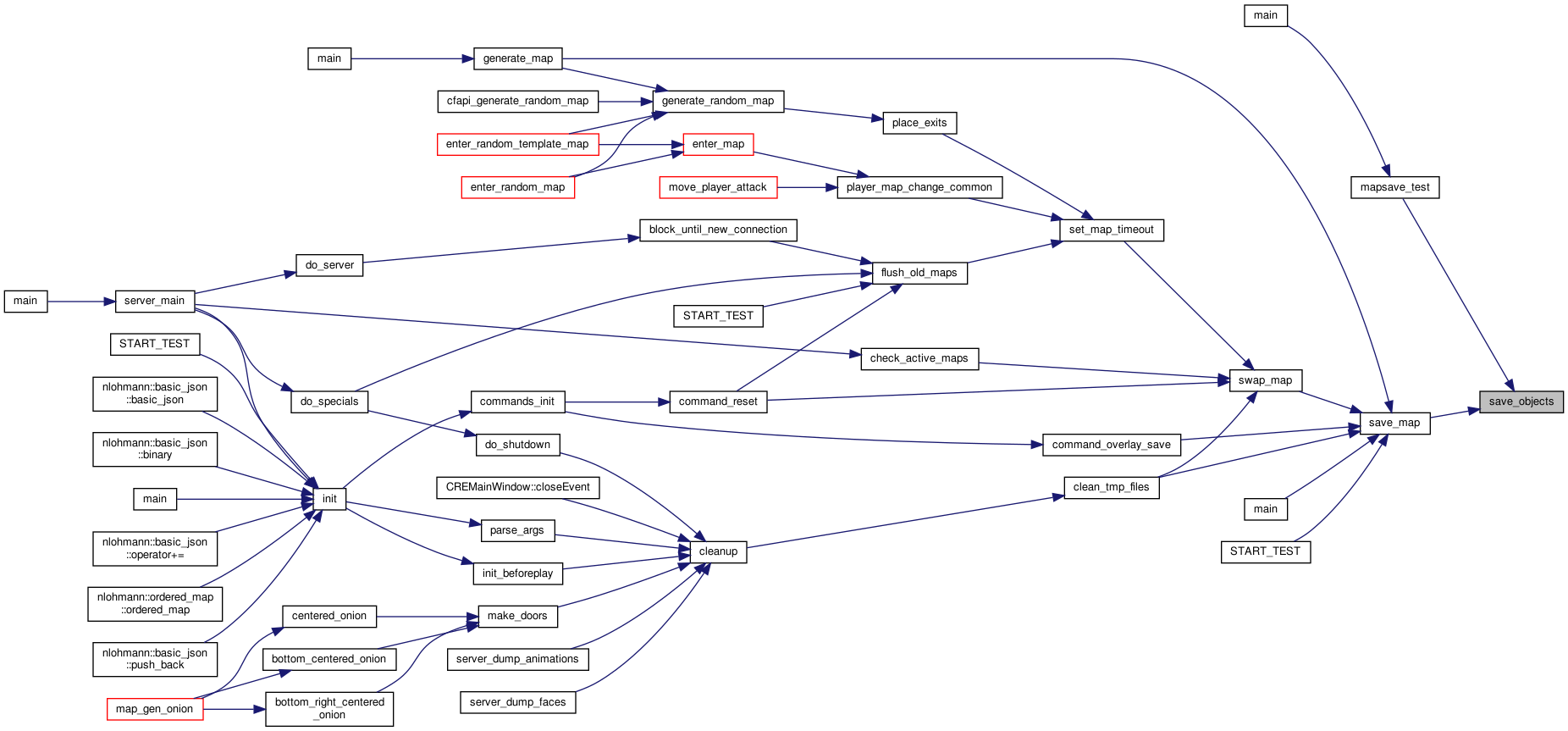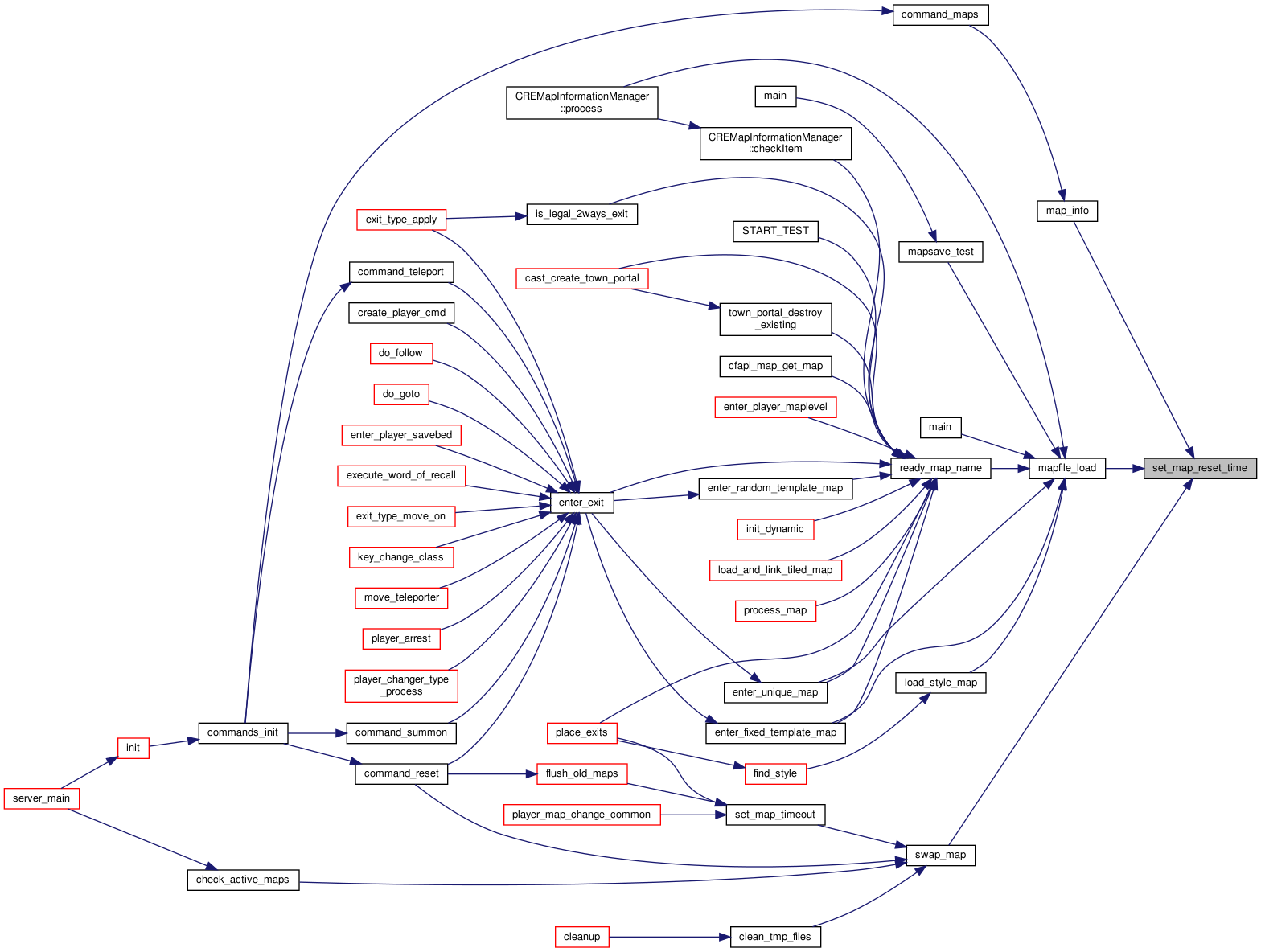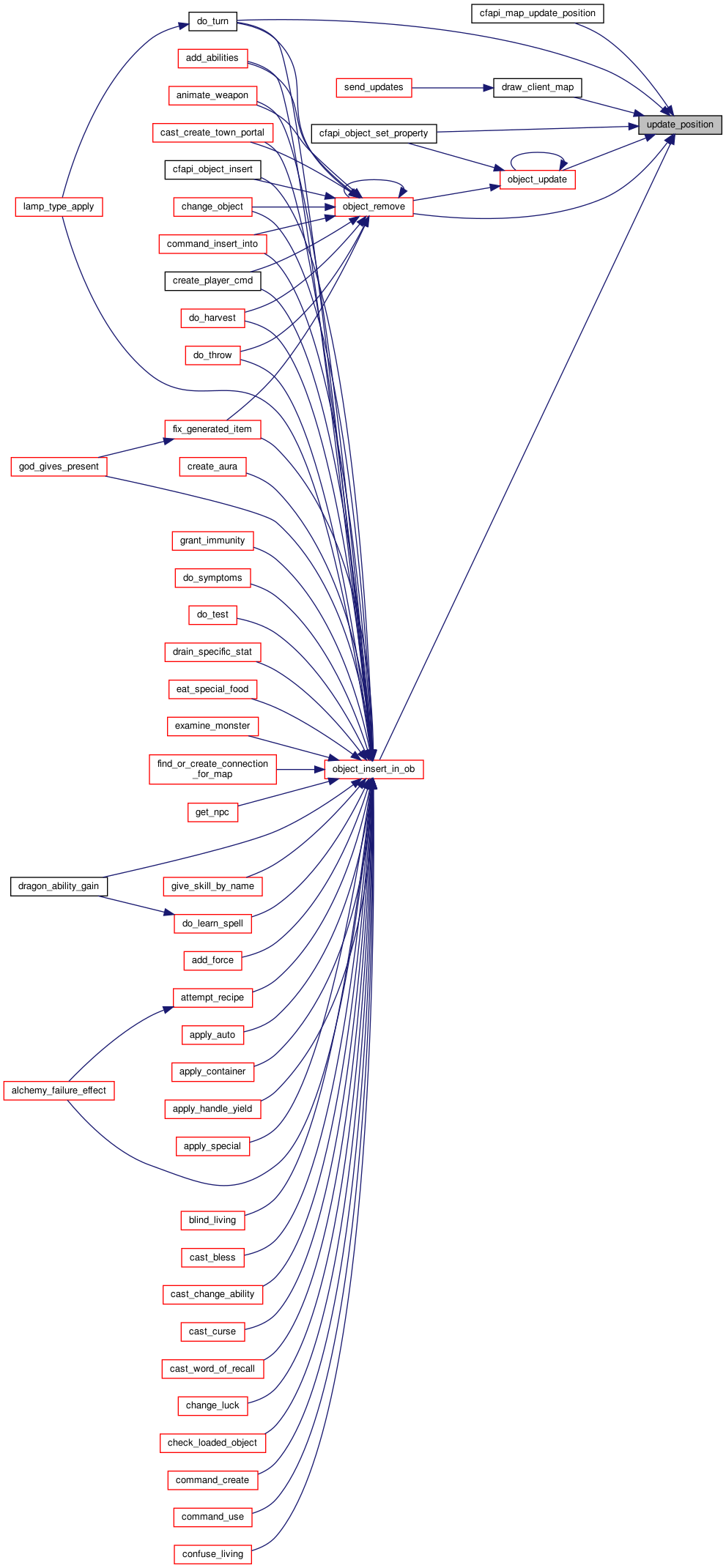#include "global.h"#include <ctype.h>#include <errno.h>#include <stdio.h>#include <stdlib.h>#include <string.h>#include <sys/stat.h>#include <math.h>#include <unistd.h>#include "sproto.h"#include "loader.h"#include "output_file.h"#include "path.h" Include dependency graph for map.c:
Include dependency graph for map.c:Go to the source code of this file.
Data Structures | |
| struct | Map_Layer_Info |
Typedefs | |
| typedef struct Map_Layer_Info | Map_Layer_Info |
Functions | |
| static void | add_face_layer (int low_layer, int high_layer, object *ob, object *layers[], int honor_visibility) |
| static int | adjacent_map (const mapstruct *map1, const mapstruct *map2, int *dx, int *dy) |
| void | allocate_map (mapstruct *m) |
| int | blocked_link (object *ob, mapstruct *m, int16_t sx, int16_t sy) |
| int | calculate_difficulty (mapstruct *m) |
| int | change_map_light (mapstruct *m, int change) |
| int | check_path (const char *name, int prepend_dir) |
| void | clean_object (object *op) |
| void | clean_tmp_map (mapstruct *m) |
| static void | create_items_path (const char *s, char *buf, size_t size) |
| void | create_overlay_pathname (const char *name, char *buf, size_t size) |
| char * | create_pathname (const char *name, char *buf, size_t size) |
| void | create_template_pathname (const char *name, char *buf, size_t size) |
| void | delete_map (mapstruct *m) |
| static void | delete_unique_items (mapstruct *m) |
| void | dump_all_maps (void) |
| void | dump_map (const mapstruct *m) |
| static void | fix_container_multipart (object *container) |
| void | free_all_maps (void) |
| static void | free_all_objects (mapstruct *m) |
| void | free_map (mapstruct *m) |
| mapstruct * | get_empty_map (int sizex, int sizey) |
| mapstruct * | get_linked_map (void) |
| int | get_map_flags (mapstruct *oldmap, mapstruct **newmap, int16_t x, int16_t y, int16_t *nx, int16_t *ny) |
| mapstruct * | get_map_from_coord (mapstruct *m, int16_t *x, int16_t *y) |
| int | get_rangevector (object *op1, const object *op2, rv_vector *retval, int flags) |
| int | get_rangevector_from_mapcoord (const mapstruct *m, int x, int y, const object *op2, rv_vector *retval, int flags) |
| mapstruct * | has_been_loaded (const char *name) |
| static void | link_multipart_objects (mapstruct *m) |
| static mapstruct * | load_and_link_tiled_map (mapstruct *orig_map, int tile_num) |
| static int | load_map_header (FILE *fp, mapstruct *m) |
| void | load_objects (mapstruct *m, FILE *fp, int mapflags) |
| static int | load_overlay_map (const char *filename, mapstruct *m) |
| static int | load_temporary_map (mapstruct *m) |
| static void | load_unique_objects (mapstruct *m) |
| object * | map_find_by_flag (mapstruct *map, int x, int y, int flag) |
| const char * | map_get_path (const object *item) |
| void | map_remove_unique_files (const mapstruct *map) |
| uint32_t | map_size (mapstruct *m) |
| mapstruct * | mapfile_load (const char *map, int flags) |
| int | ob_blocked (const object *ob, mapstruct *m, int16_t x, int16_t y) |
| int | on_same_map (const object *op1, const object *op2) |
| int | out_of_map (mapstruct *m, int x, int y) |
| static shopitems * | parse_shop_string (const char *input_string, const mapstruct *map) |
| static void | print_shop_string (mapstruct *m, char *output_string, int size) |
| mapstruct * | ready_map_name (const char *name, int flags) |
| int | save_map (mapstruct *m, int flag) |
| int | save_objects (mapstruct *m, FILE *fp, FILE *fp2, int flag) |
| void | set_map_reset_time (mapstruct *map) |
| void | update_position (mapstruct *m, int x, int y) |
Variables | |
| static const Map_Layer_Info | map_layer_info [MAP_LAYERS] |
| const char *const | map_layer_name [MAP_LAYERS] |
Detailed Description
Map-related functions.
Definition in file map.c.
Typedef Documentation
◆ Map_Layer_Info
| typedef struct Map_Layer_Info Map_Layer_Info |
Information about a layer.
Function Documentation
◆ add_face_layer()
|
inlinestatic |
This function is used for things that can have multiple layers - NO_PICK, ITEM, LIVING, FLYING. Basically, we want to store in the empty spot, and if both full, store highest visiblity objects. Since update_position() goes from bottom to top order, if the new object is equal to existing we take the new object since it is higher in the stack.
- Parameters
-
low_layer lower bounds to check (inclusive). high_layer upper bounds to check (inclusive). ob object to add to the layer. layers layers to change. honor_visibility if it is set to 0,then we do a pure stacking logic - this is used for the no pick layer, since stacking ordering there is basically fixed - don't want to re-order walls, pentagrams, etc.
Definition at line 2064 of file map.c.
References obj::face, banquet::l, guildjoin::ob, Ice::tmp, and Face::visibility.
Referenced by update_position().
 Here is the caller graph for this function:
Here is the caller graph for this function:◆ adjacent_map()
|
static |
Return whether map2 is adjacent to map1. If so, store the distance from map1 to map2 in dx/dy.
- Parameters
-
map1 map2 maps to consider. dx dy distance. Must not be NULL. Not altered if returns 0.
- Returns
- 1 if maps are adjacent, 0 else.
Definition at line 2468 of file map.c.
References MAP_HEIGHT, MAP_WIDTH, and mapdef::tile_map.
Referenced by get_rangevector(), get_rangevector_from_mapcoord(), and on_same_map().
 Here is the caller graph for this function:
Here is the caller graph for this function:◆ allocate_map()
| void allocate_map | ( | mapstruct * | m | ) |
This basically allocates the dynamic array of spaces for the map.
- Parameters
-
m map to check.
- Note
- will never fail, since it calls fatal() if memory allocation failure.
Definition at line 839 of file map.c.
References fatal(), llevError, LOG(), m, MAP_IN_MEMORY, map_size(), and OUT_OF_MEMORY.
Referenced by get_empty_map(), load_temporary_map(), mapfile_load(), and mapsave_test().
 Here is the call graph for this function:
Here is the call graph for this function: Here is the caller graph for this function:
Here is the caller graph for this function:◆ blocked_link()
Returns true if the given coordinate is blocked except by the object passed is not blocking. This is used with multipart monsters - if we want to see if a 2x2 monster can move 1 space to the left, we don't want its own area to block it from moving there.
- Parameters
-
ob object we ignore. Must not be NULL. m map we're considering. sx sy target coordinates
- Returns
- TRUE if the space is blocked by something other than ob.
- Note
- the coordinates & map passed in should have been updated for tiling by the caller.
Definition at line 345 of file map.c.
References CHECK_INV, check_inv_recursive(), DOOR, draw_ext_info(), FLAG_ALIVE, FLAG_WIZ, FOR_MAP_FINISH, FOR_MAP_PREPARE, GET_MAP_MOVE_BLOCK, HEAD, llevError, LOG(), m, MSG_TYPE_ATTACK, MSG_TYPE_ATTACK_NOKEY, NDI_NAVY, NDI_UNIQUE, guildjoin::ob, OB_MOVE_BLOCK, OB_TYPE_MOVE_BLOCK, OUT_OF_REAL_MAP, P_IS_ALIVE, PLAYER, QUERY_FLAG, Ice::tmp, and TRANSPORT.
Referenced by move_ob(), and path_to_player().
 Here is the call graph for this function:
Here is the call graph for this function: Here is the caller graph for this function:
Here is the caller graph for this function:◆ calculate_difficulty()
| int calculate_difficulty | ( | mapstruct * | m | ) |
This routine is supposed to find out the difficulty of the map. Difficulty does not have a lot to do with character level, but does have a lot to do with treasure on the map.
Difficulty can now be set by the map creature. If the value stored in the map is zero, then use this routine. Maps should really have a difficulty set than using this function - human calculation is much better than this functions guesswork.
- Parameters
-
m map for which to compute difficulty.
- Returns
- difficulty of the map.
Definition at line 1911 of file map.c.
References archt::clone, liv::exp, FLAG_GENERATOR, FLAG_MONSTER, FOR_MAP_FINISH, FOR_MAP_PREPARE, if(), level_exp(), m, MAP_DIFFICULTY, MAP_HEIGHT, MAP_WIDTH, object_get_value(), give::op, QUERY_FLAG, obj::stats, diamondslots::x, and diamondslots::y.
Referenced by cfapi_map_get_map_property(), generate_random_map(), mapfile_load(), and CREMapInformationManager::process().
 Here is the call graph for this function:
Here is the call graph for this function: Here is the caller graph for this function:
Here is the caller graph for this function:◆ change_map_light()
| int change_map_light | ( | mapstruct * | m, |
| int | change | ||
| ) |
Used to change map light level (darkness) up or down. It should now be possible to change a value by more than 1.
Move this from los.c to map.c since this is more related to maps than los. postive values make it darker, negative make it brighter
Will inform players on the map.
- Parameters
-
m map to change. change delta of light.
- Returns
- TRUE if light changed, FALSE else.
Definition at line 2009 of file map.c.
References ext_info_map(), m, MAX_DARKNESS, MSG_SUBTYPE_NONE, MSG_TYPE_MISC, NDI_BLACK, and update_all_map_los().
Referenced by cast_change_map_lightlevel(), cfapi_map_change_light(), dawn_to_dusk(), generate_random_map(), and set_darkness_map().
 Here is the call graph for this function:
Here is the call graph for this function: Here is the caller graph for this function:
Here is the caller graph for this function:◆ check_path()
| int check_path | ( | const char * | name, |
| int | prepend_dir | ||
| ) |
This function checks if a file with the given path exists.
- Parameters
-
name map path to check. prepend_dir If set, then we call create_pathname (which prepends libdir & mapdir). Otherwise, we assume the name given is fully complete.
- Returns
- -1 if it fails, otherwise the mode of the file is returned.
- Note
- Only the editor actually cares about the writablity of this - the rest of the code only cares that the file is readable. when the editor goes away, the call to stat should probably be replaced by an access instead (similar to the windows one, but that seems to be missing the prepend_dir processing
Definition at line 202 of file map.c.
References buf, create_pathname(), MAX_BUF, give::name, S_IRGRP, S_IROTH, S_IRUSR, S_IWGRP, S_IWOTH, S_IWUSR, and strlcpy().
Referenced by cfapi_system_check_path(), and check_login().
 Here is the call graph for this function:
Here is the call graph for this function: Here is the caller graph for this function:
Here is the caller graph for this function:◆ clean_object()
| void clean_object | ( | object * | op | ) |
Remove and free all objects in the inventory of the given object.
- Parameters
-
op object to clean.
- Todo:
- move to common/object.c ?
Definition at line 1613 of file map.c.
References clean_object(), FLAG_IS_LINKED, FOR_INV_FINISH, FOR_INV_PREPARE, object_free_drop_inventory(), object_remove(), give::op, QUERY_FLAG, remove_button_link(), and Ice::tmp.
Referenced by cfapi_object_clean_object(), clean_object(), delete_unique_items(), and free_all_objects().
 Here is the call graph for this function:
Here is the call graph for this function: Here is the caller graph for this function:
Here is the caller graph for this function:◆ clean_tmp_map()
| void clean_tmp_map | ( | mapstruct * | m | ) |
Removse the temporary file used by the map.
- Parameters
-
m map, which mustn't be NULL but can have no temporary file set.
Definition at line 1968 of file map.c.
References m, and nlohmann::detail::void().
Referenced by clean_tmp_files(), flush_old_maps(), and ready_map_name().
 Here is the call graph for this function:
Here is the call graph for this function: Here is the caller graph for this function:
Here is the caller graph for this function:◆ create_items_path()
|
static |
This makes absolute path to the itemfile where unique objects will be saved. Converts '/' to '@'. I think it's essier maintain files than full directory structure, but if this is problem it can be changed.
- Parameters
-
s path of the map for the item. buf buffer that will contain path. Must not be NULL. size buffer's length.
Definition at line 167 of file map.c.
References buf, Settings::localdir, settings, Floor::t, and Settings::uniquedir.
Referenced by load_unique_objects(), map_remove_unique_files(), and save_map().
 Here is the caller graph for this function:
Here is the caller graph for this function:◆ create_overlay_pathname()
| void create_overlay_pathname | ( | const char * | name, |
| char * | buf, | ||
| size_t | size | ||
| ) |
Same as create_pathname(), but for the overlay maps. /
- Parameters
-
name path of the overlay map. buf buffer that will contain the full path. size buffer's length.
Definition at line 124 of file map.c.
References buf, Settings::localdir, Settings::mapdir, give::name, and settings.
Referenced by cfapi_map_create_path(), command_overlay_reset(), load_overlay_map(), mapfile_load(), and save_map().
 Here is the caller graph for this function:
Here is the caller graph for this function:◆ create_pathname()
| char* create_pathname | ( | const char * | name, |
| char * | buf, | ||
| size_t | size | ||
| ) |
Get the full path to a map file. This simply means prepending the correct map directory to the given path.
- Parameters
-
name path of the map. buf buffer that will contain the full path. size buffer's length.
- Returns
- buf.
Definition at line 103 of file map.c.
References buf, Settings::datadir, Settings::mapdir, give::name, and settings.
Referenced by cfapi_map_create_path(), check_path(), CREMapInformationManager::checkItem(), enter_fixed_template_map(), mapfile_load(), CREMapInformationManager::process(), process_map(), CREMapInformationManager::recurseStyleDirectory(), and save_map().
 Here is the caller graph for this function:
Here is the caller graph for this function:◆ create_template_pathname()
| void create_template_pathname | ( | const char * | name, |
| char * | buf, | ||
| size_t | size | ||
| ) |
same as create_pathname(), but for the template maps.
- Parameters
-
name path of the template map. buf buffer that will contain the full path. size buf's length
Definition at line 144 of file map.c.
References buf, Settings::localdir, give::name, settings, and Settings::templatedir.
Referenced by enter_fixed_template_map(), and enter_random_template_map().
 Here is the caller graph for this function:
Here is the caller graph for this function:◆ delete_map()
| void delete_map | ( | mapstruct * | m | ) |
Frees the map, including the mapstruct.
This deletes all the data on the map (freeing pointers) and then removes this map from the global linked list of maps.
- Parameters
-
m pointer to mapstruct, if NULL no action. Will be invalid after this function.
Definition at line 1722 of file map.c.
References first_map, FREE_AND_CLEAR_STR_IF, free_map(), llevError, LOG(), m, MAP_IN_MEMORY, MAP_SAVING, mapdef::next, and Ice::tmp.
Referenced by cfapi_map_delete_map(), CREMapInformationManager::checkItem(), flush_old_maps(), free_all_maps(), free_style_maps(), init_dynamic(), key_confirm_quit(), mapfile_load(), monsterFight(), CREMapInformationManager::process(), process_map(), ready_map_name(), START_TEST(), and swap_map().
 Here is the call graph for this function:
Here is the call graph for this function: Here is the caller graph for this function:
Here is the caller graph for this function:◆ delete_unique_items()
|
static |
This goes through map 'm' and removes any unique items on the map.
- Parameters
-
m map to check.
Definition at line 1348 of file map.c.
References clean_object(), FLAG_IS_FLOOR, FLAG_IS_LINKED, FLAG_UNIQUE, FOR_MAP_FINISH, FOR_MAP_PREPARE, m, MAP_HEIGHT, MAP_WIDTH, object_free_drop_inventory(), object_remove(), give::op, QUERY_FLAG, and remove_button_link().
Referenced by load_unique_objects().
 Here is the call graph for this function:
Here is the call graph for this function: Here is the caller graph for this function:
Here is the caller graph for this function:◆ dump_all_maps()
| void dump_all_maps | ( | void | ) |
Prints out debug-information about all maps. This basically just goes through all the maps and calls dump_map() on each one. Can be used by a DM with the dumpallmaps command.
Definition at line 269 of file map.c.
References dump_map(), first_map, and m.
Referenced by command_dumpallmaps().
 Here is the call graph for this function:
Here is the call graph for this function: Here is the caller graph for this function:
Here is the caller graph for this function:◆ dump_map()
| void dump_map | ( | const mapstruct * | m | ) |
Prints out debug-information about a map. Dumping these at llevError doesn't seem right, but is necessary to make sure the information is in fact logged. Can be used by a DM with the dumpmap command.
- Parameters
-
m map to dump.
Definition at line 246 of file map.c.
References llevError, LOG(), m, MAP_ENTER_X, MAP_ENTER_Y, MAP_HEIGHT, and MAP_WIDTH.
Referenced by command_dumpmap(), and dump_all_maps().
 Here is the call graph for this function:
Here is the call graph for this function: Here is the caller graph for this function:
Here is the caller graph for this function:◆ fix_container_multipart()
|
static |
Go through all the objects in a container (recursively) looking for objects whose arch says they are multipart yet according to the info we have, they only have the head (as would be expected when they are saved). We do have to look for the old maps that did save the more sections and not re-add sections for them.
- Parameters
-
container object that contains the inventory.
Definition at line 543 of file map.c.
References add_string(), arch_to_object(), CLEAR_FLAG, FLAG_REMOVED, FOR_INV_FINISH, FOR_INV_PREPARE, free_string(), obj::more, archt::more, give::op, and Ice::tmp.
Referenced by link_multipart_objects().
 Here is the call graph for this function:
Here is the call graph for this function: Here is the caller graph for this function:
Here is the caller graph for this function:◆ free_all_maps()
| void free_all_maps | ( | void | ) |
Frees all allocated maps.
Definition at line 1977 of file map.c.
References delete_map(), first_map, mapdef::in_memory, llevDebug, LOG(), MAP_IN_MEMORY, and MAP_SAVING.
Referenced by cleanup().
 Here is the call graph for this function:
Here is the call graph for this function: Here is the caller graph for this function:
Here is the caller graph for this function:◆ free_all_objects()
|
static |
Remove and free all objects in the given map.
- Parameters
-
m map to free.
Definition at line 1629 of file map.c.
References clean_object(), FLAG_REMOVED, FREE_OBJ_NO_DESTROY_CALLBACK, GET_MAP_OB, HEAD, llevDebug, llevError, LOG(), m, MAP_HEIGHT, MAP_IN_MEMORY, MAP_WIDTH, object_free(), object_remove(), objects, give::op, and QUERY_FLAG.
Referenced by free_map(), and save_map().
 Here is the call graph for this function:
Here is the call graph for this function: Here is the caller graph for this function:
Here is the caller graph for this function:◆ free_map()
| void free_map | ( | mapstruct * | m | ) |
Frees everything allocated by the given mapstructure. Don't free tmpname or the reset group - our caller is left to do that. Mapstructure itself is not freed.
- Parameters
-
m map to free.
Definition at line 1676 of file map.c.
References EVENT_MAPUNLOAD, events_execute_global_event(), free_all_objects(), FREE_AND_CLEAR, free_objectlinkpt(), llevError, LOG(), m, and MAP_SWAPPED.
Referenced by delete_map(), CRECombatSimulator::fight(), main(), mapsave_test(), START_TEST(), swap_map(), and teardown().
 Here is the call graph for this function:
Here is the call graph for this function: Here is the caller graph for this function:
Here is the caller graph for this function:◆ get_empty_map()
| mapstruct* get_empty_map | ( | int | sizex, |
| int | sizey | ||
| ) |
Creates and returns a map of the specific size. Used in random map code and the editor.
- Parameters
-
sizex sizey map size.
- Returns
- new map.
- Note
- will never return NULL, as get_linked_map() never fails.
Definition at line 869 of file map.c.
References allocate_map(), get_linked_map(), m, and MAP_SWAPPED.
Referenced by cfapi_map_get_map(), do_map(), do_test(), CRECombatSimulator::fight(), make_map_floor(), monsterFight(), setup(), and START_TEST().
 Here is the call graph for this function:
Here is the call graph for this function: Here is the caller graph for this function:
Here is the caller graph for this function:◆ get_linked_map()
| mapstruct* get_linked_map | ( | void | ) |
Allocates, initialises, and returns a pointer to a mapstruct. Modified to no longer take a path option which was not being used anyways. MSW 2001-07-01
- Returns
- new structure.
- Note
- will never return NULL, but call fatal() if memory error.
Definition at line 788 of file map.c.
References fatal(), first_map, disinfect::map, MAP_ENTER_X, MAP_ENTER_Y, MAP_HEIGHT, MAP_RESET_TIMEOUT, MAP_SWAPPED, MAP_TIMEOUT, MAP_WIDTH, and OUT_OF_MEMORY.
Referenced by get_empty_map(), mapfile_load(), mapsave_test(), and read_map_log().
 Here is the call graph for this function:
Here is the call graph for this function: Here is the caller graph for this function:
Here is the caller graph for this function:◆ get_map_flags()
| int get_map_flags | ( | mapstruct * | oldmap, |
| mapstruct ** | newmap, | ||
| int16_t | x, | ||
| int16_t | y, | ||
| int16_t * | nx, | ||
| int16_t * | ny | ||
| ) |
This rolls up wall, blocks_magic, blocks_view, etc, all into one function that just returns a P_.. value (see map.h) it will also do map translation for tiled maps, returning new values into newmap, nx, and ny. Any and all of those values can be null, in which case if a new map is needed (returned by a P_NEW_MAP value, another call to get_map_from_coord is needed. The case of not passing values is if we're just checking for the existence of something on those spaces, but don't expect to insert/remove anything from those spaces.
- Parameters
-
oldmap map for which we want information. newmap if not NULL, will contain the actual map checked if not oldmap. x y coordinates to check nx ny if not NULL, will contain the actual coordinates checked.
- Returns
- flags for specified position, with maybe P_OUT_OF_MAP or P_NEW_MAP set.
Definition at line 301 of file map.c.
References MapSpace::flags, get_map_from_coord(), P_NEW_MAP, P_OUT_OF_MAP, mapdef::spaces, mapdef::width, diamondslots::x, and diamondslots::y.
Referenced by alchemy(), animate_weapon(), armour_improver_type_apply(), attempt_jump(), can_see_monsterP(), cast_cause_disease(), cast_cone(), cast_create_obj(), cast_destruction(), cast_detection(), cast_earth_to_dust(), cast_light(), cast_polymorph(), cast_raise_dead_spell(), cast_spell(), cast_transfer(), cfapi_map_get_map_property(), cfapi_map_get_object_at(), check_bullet(), check_infection(), check_wall(), command_save(), common_process_projectile(), counterspell(), create_bomb(), dimension_door(), dispel_rune(), do_harvest(), do_skill_ident(), do_throw(), draw_client_map(), eventListener(), expand_lighted_sight(), expand_sight(), find_target_for_friendly_spell(), find_traps(), fire_arch_from_position(), fire_bolt(), fire_bow(), forklightning(), get_pointed_target(), hideability(), hit_map(), magic_mapping_mark(), magic_mapping_mark_recursive(), magic_wall(), monster_communicate(), monster_find_nearest_enemy(), monster_npc_call_help(), monster_stand_in_light(), mood_change(), move_aura(), move_ball_spell(), move_bolt(), move_bullet(), move_missile(), move_ob(), move_player_mover(), move_swarm_spell(), move_to(), ob_blocked(), object_find_multi_free_spot_within_radius(), ok_to_put_more(), path_to_player(), pets_get_enemy(), pets_move(), pets_move_golem(), pick_arrow_target(), probe(), process_players1(), remove_adjacent_doors(), remove_trap(), roll_ob(), singing(), skill_attack(), spell_failure(), spell_find_dir(), stand_near_hostile(), steal(), teleport(), try_fit(), use_oratory(), weapon_improver_type_apply(), and write_rune().
 Here is the call graph for this function:
Here is the call graph for this function:◆ get_map_from_coord()
This is basically the same as out_of_map above(), but instead we return NULL if no map is valid (coordinates out of bounds and no tiled map), otherwise it returns the map as that the coordinates are really on, and updates x and y to be the localized coordinates. Using this is more efficient than calling out_of_map and then figuring out what the real map is
- Parameters
-
m map we want to look at. Must not be NULL. x y coordinates, which will contain the real position that was checked.
- Returns
- map that is at specified location. Will be NULL if not on any map.
- Note
- refactored to remove the recursion. This should help stack space and optimization.
Definition at line 2385 of file map.c.
References load_and_link_tiled_map(), m, MAP_HEIGHT, MAP_IN_MEMORY, MAP_WIDTH, OUT_OF_REAL_MAP, diamondslots::x, and diamondslots::y.
Referenced by cfapi_map_get_map(), draw_client_map2(), get_map_flags(), look_at(), monster_use_bow(), move_player_attack(), object_insert_in_map(), object_remove(), and pets_move().
 Here is the call graph for this function:
Here is the call graph for this function: Here is the caller graph for this function:
Here is the caller graph for this function:◆ get_rangevector()
From map.c This is used by get_player to determine where the other creature is. get_rangevector takes into account map tiling, so you just can not look the the map coordinates and get the right value. distance_x/y are distance away, which can be negative. direction is the crossfire direction scheme that the creature should head. part is the part of the monster that is closest.
get_rangevector looks at op1 and op2, and fills in the structure for op1 to get to op2. We already trust that the caller has verified that the two objects are at least on adjacent maps. If not, results are not likely to be what is desired.
- Parameters
-
op1 object which wants to go to op2's location. op2 target of op1. retval vector for op1 to go to op2. flags if 1, don't translate for closest body part of 'op1'
- Returns
- 1=ok; 0=the objects are not on the same map
Definition at line 2545 of file map.c.
References adjacent_map(), rv_vector::direction, rv_vector::distance, rv_vector::distance_x, rv_vector::distance_y, find_dir_2(), flags, isqrt(), obj::map, obj::more, rv_vector::part, Ice::tmp, obj::x, guild_entry::x1, and obj::y.
Referenced by command_follow(), do_follow(), flee_player(), monster_can_detect_enemy(), monster_can_hit(), monster_cast_spell(), monster_find_enemy(), monster_move(), monster_use_bow(), monster_use_range(), monster_use_scroll(), monster_use_skill(), move_towards(), path_to_player(), pets_get_enemy(), pets_move(), player_can_view(), and spring_trap().
 Here is the call graph for this function:
Here is the call graph for this function: Here is the caller graph for this function:
Here is the caller graph for this function:◆ get_rangevector_from_mapcoord()
| int get_rangevector_from_mapcoord | ( | const mapstruct * | m, |
| int | x, | ||
| int | y, | ||
| const object * | op2, | ||
| rv_vector * | retval, | ||
| int | flags | ||
| ) |
This is basically the same as get_rangevector() above, but instead of the first parameter being an object, it instead is the map and x,y coordinates - this is used for path to player - since the object is not infact moving but we are trying to traverse the path, we need this. flags has no meaning for this function at this time - I kept it in to be more consistant with the above function and also in case they are needed for something in the future. Also, since no object is pasted, the best field of the rv_vector is set to NULL.
- Parameters
-
m map to consider. x y origin coordinates. op2 target object. retval vector to get to op2. flags unused.
- Returns
- 1=ok; 0=the objects are not on the same map
Definition at line 2618 of file map.c.
References adjacent_map(), rv_vector::direction, rv_vector::distance, rv_vector::distance_x, rv_vector::distance_y, find_dir_2(), flags, isqrt(), m, obj::map, rv_vector::part, nlohmann::detail::void(), diamondslots::x, obj::x, diamondslots::y, and obj::y.
Referenced by path_to_player().
 Here is the call graph for this function:
Here is the call graph for this function: Here is the caller graph for this function:
Here is the caller graph for this function:◆ has_been_loaded()
| mapstruct* has_been_loaded | ( | const char * | name | ) |
Checks whether map has been loaded.
- Parameters
-
name path of the map to search. Can be NULL.
- Returns
- the mapstruct which has a name matching the given argument. return NULL if no match is found.
Definition at line 78 of file map.c.
References first_map, disinfect::map, and give::name.
Referenced by add_npc_to_random_map(), cfapi_map_has_been_loaded(), check_login(), command_reset(), is_legal_2ways_exit(), monsterFight(), and ready_map_name().
 Here is the caller graph for this function:
Here is the caller graph for this function:◆ link_multipart_objects()
|
static |
Go through all the objects on the map looking for objects whose arch says they are multipart yet according to the info we have, they only have the head (as would be expected when they are saved). We do have to look for the old maps that did save the more sections and not re-add sections for them.
- Parameters
-
m map to check.
Definition at line 584 of file map.c.
References fix_container_multipart(), FOR_MAP_FINISH, FOR_MAP_PREPARE, m, MAP_HEIGHT, MAP_WIDTH, object_fix_multipart(), Ice::tmp, diamondslots::x, and diamondslots::y.
Referenced by load_objects().
 Here is the call graph for this function:
Here is the call graph for this function: Here is the caller graph for this function:
Here is the caller graph for this function:◆ load_and_link_tiled_map()
This updates the orig_map->tile_map[tile_num] value after loading the map. It also takes care of linking back the freshly loaded maps tile_map values if it tiles back to this one. It returns the value of orig_map->tile_map[tile_num]. It really only does this so that it is easier for calling functions to verify success.
- Parameters
-
orig_map map for which we load the tiled map. tile_num tile to load. Must be between 0 and 3 inclusive.
- Returns
- linked map, or NULL on failure.
Definition at line 2273 of file map.c.
References HUGE_BUF, llevError, LOG(), python_init::path, mapdef::path, path_combine_and_normalize(), ready_map_name(), mapdef::tile_map, and mapdef::tile_path.
Referenced by get_map_from_coord(), and out_of_map().
 Here is the call graph for this function:
Here is the call graph for this function: Here is the caller graph for this function:
Here is the caller graph for this function:◆ load_map_header()
|
static |
This loads the header information of the map. The header contains things like difficulty, size, timeout, etc. this used to be stored in the map object, but with the addition of tiling, fields beyond that easily named in an object structure were needed, so it just made sense to put all the stuff in the map object so that names actually make sense. This could be done in lex (like the object loader), but I think currently, there are few enough fields this is not a big deal. MSW 2001-07-01
- Parameters
-
fp file to read from. m map being read.
- Returns
- 0 on success, 1 on failure.
Definition at line 1022 of file map.c.
References add_string(), buf, get_region_by_name(), HUGE_BUF, castle_read::key, llevError, LOG(), m, msgbuf, parse_shop_string(), strdup_local, create-tower::tile, and autojail::value.
Referenced by load_overlay_map(), load_temporary_map(), and mapfile_load().
 Here is the call graph for this function:
Here is the call graph for this function: Here is the caller graph for this function:
Here is the caller graph for this function:◆ load_objects()
| void load_objects | ( | mapstruct * | m, |
| FILE * | fp, | ||
| int | mapflags | ||
| ) |
Loads (and parses) the objects into a given map from the specified file pointer.
- Parameters
-
m m being loaded. fp file to read from. mapflags the same as we get with mapfile_load()
Definition at line 612 of file map.c.
References FLAG_IS_FLOOR, FLAG_OBJ_ORIGINAL, FLAG_OVERLAY_FLOOR, FLAG_UNIQUE, FOR_MAP_FINISH, FOR_MAP_PREPARE, INS_ABOVE_FLOOR_ONLY, INS_MAP_LOAD, INS_NO_MERGE, INS_NO_WALK_ON, INS_ON_TOP, link_multipart_objects(), LL_MORE, LL_NORMAL, llevDebug, llevError, LO_NEWFILE, LO_REPEAT, load_object(), LOG(), m, MAP_HEIGHT, MAP_OVERLAY, MAP_PLAYER_UNIQUE, MAP_STYLE, MAP_WIDTH, obj::more, object_free_drop_inventory(), object_insert_in_map_at(), object_new(), object_remove_from_active_list(), object_sum_weight(), give::op, PLAYER, PROFILE_BEGIN, PROFILE_END, QUERY_FLAG, and SET_FLAG.
Referenced by load_overlay_map(), load_temporary_map(), load_unique_objects(), mapfile_load(), and mapsave_test().
 Here is the call graph for this function:
Here is the call graph for this function: Here is the caller graph for this function:
Here is the caller graph for this function:◆ load_overlay_map()
|
static |
Loads an overlay for a map, which has been loaded earlier, from file.
- Parameters
-
filename filename for overlay. m map we want to load.
- Returns
- 0 on success, non zero in case of error, which is LOG'ed.
Definition at line 1313 of file map.c.
References create_overlay_pathname(), npc_dialog::filename, llevError, load_map_header(), load_objects(), LOG(), m, MAP_IN_MEMORY, MAP_LOADING, MAP_OVERLAY, and MAX_BUF.
Referenced by ready_map_name().
 Here is the call graph for this function:
Here is the call graph for this function: Here is the caller graph for this function:
Here is the caller graph for this function:◆ load_temporary_map()
|
static |
Loads a map, which has been loaded earlier, from file.
- Parameters
-
m map we want to reload.
- Returns
- 0 if success, non zero if failure, in which case error was LOG'ed.
Definition at line 1277 of file map.c.
References allocate_map(), llevError, load_map_header(), load_objects(), LOG(), m, MAP_IN_MEMORY, and MAP_LOADING.
Referenced by ready_map_name().
 Here is the call graph for this function:
Here is the call graph for this function: Here is the caller graph for this function:
Here is the caller graph for this function:◆ load_unique_objects()
|
static |
Loads unique objects from file(s) into the map which is in memory
- Parameters
-
m map to load unique items into.
Definition at line 1373 of file map.c.
References disinfect::count, create_items_path(), delete_unique_items(), llevDebug, LO_NOREAD, load_object(), load_objects(), LOG(), m, MAP_IN_MEMORY, MAP_LOADING, MAX_BUF, and give::name.
Referenced by ready_map_name().
 Here is the call graph for this function:
Here is the call graph for this function: Here is the caller graph for this function:
Here is the caller graph for this function:◆ map_find_by_flag()
Finds an object in a map tile by flag number. Checks the objects' heads.
- Parameters
-
map the map to search. x the x-coordiate to search. y the y-coordiate to search. flag the flag to seacrh for
- Returns
- first object's head in the tile that has the flag set. NULL if no match.
- Note
- will not search in inventory of objects.
Definition at line 2680 of file map.c.
References GET_MAP_OB, HEAD, disinfect::map, QUERY_FLAG, Ice::tmp, diamondslots::x, and diamondslots::y.
Referenced by cast_light(), common_process_projectile(), do_monster_change(), do_mood_floor(), get_pointed_target(), and mood_change().
 Here is the caller graph for this function:
Here is the caller graph for this function:◆ map_get_path()
| const char* map_get_path | ( | const object * | item | ) |
Return the map path on which the specified item is.
- Parameters
-
item what to return the map path for.
- Returns
- path, map's name, or error string, never NULL.
Definition at line 2722 of file map.c.
References map_get_path().
Referenced by gate_type_process(), and map_get_path().
 Here is the call graph for this function:
Here is the call graph for this function: Here is the caller graph for this function:
Here is the caller graph for this function:◆ map_remove_unique_files()
| void map_remove_unique_files | ( | const mapstruct * | map | ) |
Remove files containing the map's unique items.
- Parameters
-
map
Definition at line 2697 of file map.c.
References disinfect::count, create_items_path(), HUGE_BUF, llevError, Settings::localdir, LOG(), disinfect::map, python_init::path, Settings::playerdir, and settings.
Referenced by command_reset().
 Here is the call graph for this function:
Here is the call graph for this function: Here is the caller graph for this function:
Here is the caller graph for this function:◆ map_size()
| uint32_t map_size | ( | mapstruct * | m | ) |
Calculate map size without intermediate sign extension.
Definition at line 825 of file map.c.
References m.
Referenced by allocate_map(), command_style_map_info(), and malloc_info().
 Here is the caller graph for this function:
Here is the caller graph for this function:◆ mapfile_load()
| mapstruct* mapfile_load | ( | const char * | map, |
| int | flags | ||
| ) |
Opens the file "filename" and reads information about the map from the given file, and stores it in a newly allocated mapstruct. A pointer to this structure is returned, or NULL on failure. flags correspond to those in map.h. Main ones used are MAP_PLAYER_UNIQUE, in which case we don't do any name changes, and
- Parameters
-
map Map path flags Additional options for loading the map: - MAP_PLAYER_UNIQUE: Load from a player-specific directory
- MAP_OVERLAY: map is an overlay
- MAP_STYLE: style map - don't add active objects, don't add to server managed map list.
- Returns
- loaded map, or NULL if failure.
Definition at line 1214 of file map.c.
References allocate_map(), apply_auto_fix(), calculate_difficulty(), create_overlay_pathname(), create_pathname(), delete_map(), EVENT_MAPLOAD, events_execute_global_event(), flags, get_linked_map(), HUGE_BUF, llevDebug, llevError, load_map_header(), load_objects(), Settings::localdir, LOG(), m, disinfect::map, MAP_DIFFICULTY, MAP_IN_MEMORY, MAP_LOADING, MAP_NO_DIFFICULTY, MAP_OVERLAY, MAP_PLAYER_UNIQUE, MAP_STYLE, MAX_BUF, Settings::playerdir, PROFILE_BEGIN, PROFILE_END, safe_strncpy, set_map_reset_time(), settings, and update_buttons().
Referenced by enter_fixed_template_map(), enter_unique_map(), load_style_map(), main(), mapsave_test(), CREMapInformationManager::process(), and ready_map_name().
 Here is the call graph for this function:
Here is the call graph for this function: Here is the caller graph for this function:
Here is the caller graph for this function:◆ ob_blocked()
Returns true if the given object can't fit in the given spot. This is meant for multi space objects - for single space objecs, just calling get_map_blocked and checking that against movement type of object. This function goes through all the parts of the multipart object and makes sure they can be inserted.
While this doesn't call out of map, the get_map_flags does.
This function has been used to deprecate arch_out_of_map - this function also does that check, and since in most cases, a call to one would follow the other, doesn't make a lot of sense to have two seperate functions for this.
This returns nonzero if this arch can not go on the space provided, 0 otherwise. the return value will contain the P_.. value so the caller can know why this object can't go on the map. Note that callers should not expect P_NEW_MAP to be set in return codes - since the object is multispace - if we did return values, what do you return if half the object is one map, half on another.
- Parameters
-
ob object to test. m x y map and coordinates to check.
- Returns
- 0 if the object can fit on specified space, non-zero else.
- Note
- This used to be arch_blocked, but with new movement code, we need to have actual object to check its move_type against the move_block values.
Definition at line 488 of file map.c.
References AB_NO_PASS, get_map_flags(), GET_MAP_MOVE_BLOCK, m, obj::more, MOVE_ALL, obj::move_type, guildjoin::ob, OB_TYPE_MOVE_BLOCK, P_IS_ALIVE, P_OUT_OF_MAP, Ice::tmp, TRANSPORT, diamondslots::x, and diamondslots::y.
Referenced by enter_map(), monster_compute_path(), move_creator(), object_find_first_free_spot(), object_find_free_spot(), object_find_multi_free_spot_around(), object_find_multi_free_spot_within_radius(), pets_summon_golem(), pets_summon_object(), and turn_one_transport().
 Here is the call graph for this function:
Here is the call graph for this function: Here is the caller graph for this function:
Here is the caller graph for this function:◆ on_same_map()
Checks whether 2 objects are on the same map or not.
Note we only look one map out to keep the processing simple and efficient. This could probably be a macro. MSW 2001-08-05
- Parameters
-
op1 first object. op2 second object.
- Returns
- TRUE if op1 and op2 are effectively on the same map (as related to map tiling).
- Note
- This looks for a path from op1 to op2, so if the tiled maps are assymetric and op2 has a path to op1, this will still return false.
Definition at line 2657 of file map.c.
References adjacent_map(), and obj::map.
Referenced by abort_attack(), adj_attackroll(), cfapi_object_on_same_map(), get_attack_mode(), monster_check_enemy(), monster_find_enemy(), monster_move(), move_ball_spell(), pets_attempt_follow(), pets_get_enemy(), pets_move(), and share_exp().
 Here is the call graph for this function:
Here is the call graph for this function: Here is the caller graph for this function:
Here is the caller graph for this function:◆ out_of_map()
| int out_of_map | ( | mapstruct * | m, |
| int | x, | ||
| int | y | ||
| ) |
this returns TRUE if the coordinates (x,y) are out of map m. This function also takes into account any tiling considerations, loading adjacant maps as needed. This is the function should always be used when it necessary to check for valid coordinates. This function will recursively call itself for the tiled maps.
- Parameters
-
m map to consider. Must not be NULL. x y coordinates.
- Returns
- 1 if out of map, 0 else
Definition at line 2312 of file map.c.
References load_and_link_tiled_map(), m, MAP_HEIGHT, MAP_IN_MEMORY, MAP_WIDTH, out_of_map(), diamondslots::x, and diamondslots::y.
Referenced by animate_bomb(), cfapi_map_out_of_map(), command_create(), enter_map(), esrv_draw_look(), explode_bullet(), look_at(), move_player_attack(), move_teleporter(), object_insert_in_map(), object_teleport(), and out_of_map().
 Here is the call graph for this function:
Here is the call graph for this function: Here is the caller graph for this function:
Here is the caller graph for this function:◆ parse_shop_string()
Takes a string from a map definition and outputs a pointer to the array of shopitems corresponding to that string. Memory is allocated for this, it must be freed at a later date. Called by parse_map_headers() below.
- Parameters
-
input_string shop item line. map map for which to parse the string, in case of warning.
- Returns
- new array that should be freed by the caller.
Definition at line 891 of file map.c.
References CALLOC, fatal(), get_typedata(), get_typedata_by_name(), shopitem::index, llevDebug, llevError, LOG(), disinfect::map, typedata::name, shopitem::name, typedata::name_pl, shopitem::name_pl, typedata::number, OUT_OF_MEMORY, item::q, strdup_local, shopitem::strength, strip_endline(), and shopitem::typenum.
Referenced by load_map_header().
 Here is the call graph for this function:
Here is the call graph for this function: Here is the caller graph for this function:
Here is the caller graph for this function:◆ print_shop_string()
|
static |
Opposite of parse string(), this puts the string that was originally fed in to the map (or something equivilent) into output_string.
- Parameters
-
m map we're considering. output_string string to write to. size output_string's length.
Definition at line 977 of file map.c.
References m, MAX_BUF, and Ice::tmp.
Referenced by save_map().
 Here is the caller graph for this function:
Here is the caller graph for this function:◆ ready_map_name()
| mapstruct* ready_map_name | ( | const char * | name, |
| int | flags | ||
| ) |
Makes sure the given map is loaded and swapped in.
- Parameters
-
name path name of the map. flags - 0x1 (MAP_FLUSH): flush the map - always load from the map directory, and don't do unique items or the like.
- 0x2 (MAP_PLAYER_UNIQUE) - this is a unique map for each player. dont do any more name translation on it.
- Returns
- pointer to the given map, NULL on failure.
Definition at line 1785 of file map.c.
References buf, clean_tmp_map(), decay_objects(), delete_map(), EVENT_MAPREADY, events_execute_global_event(), flags, has_been_loaded(), load_overlay_map(), load_temporary_map(), load_unique_objects(), Settings::localdir, m, MAP_FLUSH, MAP_IN_MEMORY, MAP_LOADING, MAP_OVERLAY, MAP_PLAYER_UNIQUE, mapfile_load(), MAX_BUF, give::name, Settings::playerdir, seconds(), set_darkness_map(), and settings.
Referenced by cast_create_town_portal(), cfapi_map_get_map(), CREMapInformationManager::checkItem(), enter_exit(), enter_fixed_template_map(), enter_player_maplevel(), enter_random_template_map(), enter_unique_map(), init_dynamic(), is_legal_2ways_exit(), load_and_link_tiled_map(), place_exits(), process_map(), START_TEST(), and town_portal_destroy_existing().
 Here is the call graph for this function:
Here is the call graph for this function: Here is the caller graph for this function:
Here is the caller graph for this function:◆ save_map()
| int save_map | ( | mapstruct * | m, |
| int | flag | ||
| ) |
Saves a map to file. If flag is SAVE_MODE_INPLACE, it is saved into the same file it was (originally) loaded from. Otherwise a temporary filename will be genarated, and the file will be stored there. The temporary filename will be stored in the mapstructure. If the map is unique, we also save to the filename in the map (this should have been updated when first loaded)
- Parameters
-
m map to save. flag One of SAVE_MODE_xxx values.
- Returns
- one of SAVE_ERROR_xxx values.
Definition at line 1420 of file map.c.
References create_items_path(), create_overlay_pathname(), create_pathname(), npc_dialog::filename, FMT64U, free_all_objects(), llevDebug, llevError, Settings::localdir, LOG(), m, make_path_to_file(), MAP_IN_MEMORY, MAP_SAVING, MAX_BUF, give::name, of_cancel(), of_close(), of_open(), Settings::playerdir, print_shop_string(), PROFILE_BEGIN, PROFILE_END, altar_valkyrie::res, SAVE_ERROR_CLOSE, SAVE_ERROR_NO_PATH, SAVE_ERROR_OK, SAVE_ERROR_RCREATION, SAVE_ERROR_UCREATION, SAVE_ERROR_URENAME, SAVE_FLAG_NO_REMOVE, SAVE_MODE, SAVE_MODE_NORMAL, SAVE_MODE_OVERLAY, save_objects(), settings, strlcpy(), and Settings::tmpdir.
Referenced by clean_tmp_files(), command_overlay_save(), generate_map(), main(), START_TEST(), and swap_map().
 Here is the call graph for this function:
Here is the call graph for this function: Here is the caller graph for this function:
Here is the caller graph for this function:◆ save_objects()
| int save_objects | ( | mapstruct * | m, |
| FILE * | fp, | ||
| FILE * | fp2, | ||
| int | flag | ||
| ) |
This saves all the objects on the map in a non destructive fashion. Modified by MSW 2001-07-01 to do in a single pass - reduces code, and we only save the head of multi part objects - this is needed in order to do map tiling properly.
- Parameters
-
m map to save. fp file where regular objects are saved. fp2 file to save unique objects. flag combination of SAVE_FLAG_xxx flags.
- Returns
- one of SAVE_ERROR_xxx value.
Definition at line 725 of file map.c.
References disinfect::count, FLAG_IS_FLOOR, FLAG_OBJ_ORIGINAL, FLAG_UNIQUE, FLAG_UNPAID, FOR_MAP_FINISH, FOR_MAP_PREPARE, llevDebug, LOG(), m, MAP_HEIGHT, MAP_WIDTH, object_get_owner(), give::op, PLAYER, PROFILE_BEGIN, PROFILE_END, QUERY_FLAG, SAVE_FLAG_NO_REMOVE, SAVE_FLAG_SAVE_UNPAID, save_object_in_sb(), stringbuffer_finish(), and stringbuffer_new().
Referenced by mapsave_test(), and save_map().
 Here is the call graph for this function:
Here is the call graph for this function: Here is the caller graph for this function:
Here is the caller graph for this function:◆ set_map_reset_time()
| void set_map_reset_time | ( | mapstruct * | map | ) |
Updates the map's timeout.
- Parameters
-
map map to update.
Definition at line 2247 of file map.c.
References disinfect::map, MAP_DEFAULTRESET, MAP_MAXRESET, MAP_RESET_TIMEOUT, MAP_WHEN_RESET, and seconds().
Referenced by map_info(), mapfile_load(), and swap_map().
 Here is the call graph for this function:
Here is the call graph for this function: Here is the caller graph for this function:
Here is the caller graph for this function:◆ update_position()
| void update_position | ( | mapstruct * | m, |
| int | x, | ||
| int | y | ||
| ) |
This function updates various attributes about a specific space on the map (what it looks like, whether it blocks magic, has a living creatures, prevents people from passing through, etc)
- Parameters
-
m map considered x y coordinates to update
Definition at line 2133 of file map.c.
References add_face_layer(), blank_face, blocks_prayer, FLAG_ALIVE, FLAG_BLOCKSVIEW, FLAG_DAMNED, FLAG_IS_FLOOR, FLAG_MONSTER, FLAG_NO_MAGIC, FLAG_NO_PICK, FLAG_WIZ, flags, FOR_MAP_FINISH, FOR_MAP_PREPARE, GET_MAP_FACE_OBJS, GET_MAP_FLAGS, Map_Layer_Info::high_layer, Map_Layer_Info::honor_visibility, llevDebug, llevError, LOG(), m, MAP_LAYER_FLOOR, MAP_LAYER_FLY1, MAP_LAYER_FLY2, map_layer_info, MAP_LAYER_ITEM1, MAP_LAYER_ITEM3, MAP_LAYER_LIVING1, MAP_LAYER_LIVING2, MAP_LAYER_NO_PICK1, MAP_LAYER_NO_PICK2, MAP_LAYERS, MOVE_FLYING, object_value_set_shared(), P_BLOCKSVIEW, P_IS_ALIVE, P_NEED_UPDATE, P_NO_CLERIC, P_NO_ERROR, P_NO_MAGIC, P_PLAYER, PLAYER, QUERY_FLAG, SET_MAP_FLAGS, SET_MAP_LIGHT, SET_MAP_MOVE_BLOCK, SET_MAP_MOVE_OFF, SET_MAP_MOVE_ON, SET_MAP_MOVE_SLOW, SET_MAP_PLAYER, Ice::tmp, diamondslots::x, and diamondslots::y.
Referenced by cfapi_map_update_position(), cfapi_object_set_property(), do_turn(), draw_client_map(), object_insert_in_ob(), object_remove(), and object_update().
 Here is the call graph for this function:
Here is the call graph for this function: Here is the caller graph for this function:
Here is the caller graph for this function:Variable Documentation
◆ map_layer_info
|
static |
the ob->map_layer holds the low layer. For the update_position() logic, we also need to know the higher layer and whether visibility should be honored. This table has that information, so that it doesn't need to be hardcoded.
Definition at line 62 of file map.c.
Referenced by update_position().
◆ map_layer_name
| const char* const map_layer_name[MAP_LAYERS] |
These correspond to the layer names in map.h - since some of the types can be on multiple layers, names are duplicated to correspond to that layer.
Definition at line 45 of file map.c.
Referenced by get_ob_diff(), and while().


